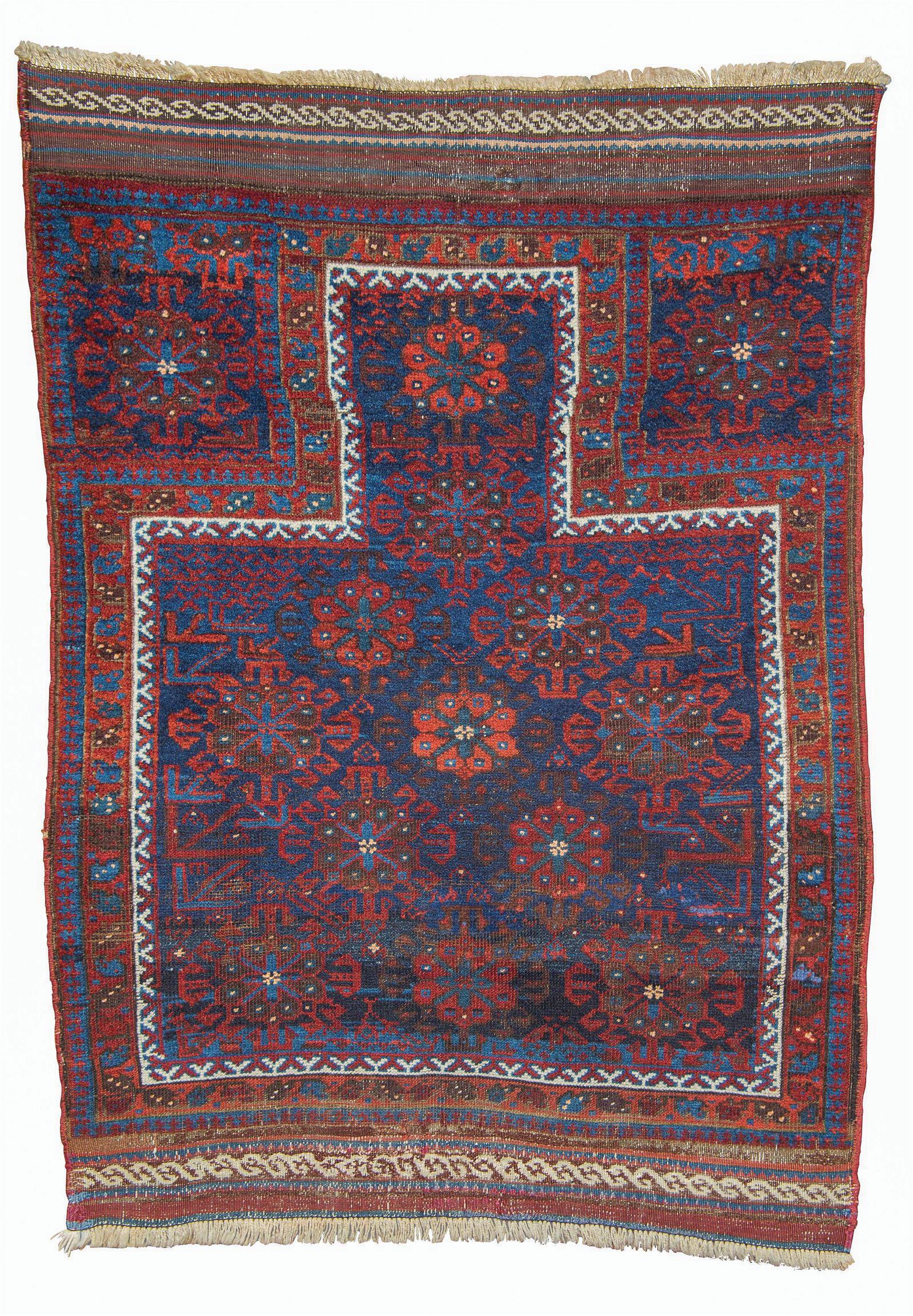
 Lot 21: Baluch Main Carpet, Southwest Afghanistan
Lot 21: Baluch Main Carpet, Southwest Afghanistan


 Lot 21: Baluch Main Carpet, Southwest Afghanistan
Lot 21: Baluch Main Carpet, Southwest Afghanistan
The Richard Stewart Collection of Baluch and Navajo Weavings

Live Showroom Auction: Sunday, May 21, 2023, 1PM ET


Public Exhibition: May 19-20, 11AM-4PM

Undoubtedly a student of the hunter / gatherer mentality, Richard Stewart excelled at what he did without raising a fuss, rarely drawing attention to himself as he quietly led his life. Discovering antique rugs in the late 1960s, he grew to love and finally pursue them with single-minded purpose. Having relocated part time to Santa Fe, NM to spend the summer months in the Land of Enchantment, he followed his heart and began collecting Navajo weavings as well as assorted objects from other cultures too. Interested in small Tibetan and Indian bronzes, his eye wandered to objects of veneration from all faiths, prompting the 12-year-old daughter of a friend to remark that a visit to his home was a unique experience, like making a holy pilgrimage. Similar observations voiced by others pleased him; sensitive to the big picture, he practiced kindness and gratitude whenever the opportunity presented itself.
Denver is hardly considered a cosmopolitan hub of multi-cultural activity, and the breadth of his interests far exceeded that of many of his friends who were inexorably attracted to his relaxed lifestyle. As one of the founders of the Colorado Textile Group (CTG) in 1993, Richard served as its first president, generously hosting speakers from the far corners of the world, including Elena Tsareva (twice) and Parviz Tanavoli, as well as helping to organize ACOR 4 (American Conference on Oriental Rugs) in Denver in May 1998.
Seeking like-minded company led him to travel the world and expand his horizons more than he could have ever imagined. He thrived on these rug related activities, and those of the Hajji Baba Club in New York and the International Hajji Baba Society in Washington DC, routinely attending both national and international rug conferences as well as textile art fairs in San Francisco, Santa Fe, in addition to Berlin as well as Istanbul.
Inspired to begin acquiring by, among others, Michael Philips, those with whom he remained closest were, for the most part, local to his home in Boulder, CO., on the outskirts of Denver. Over the years he forged relationships with like-minded collectors and dealers, including Michael Craycraft from whom a number of these rugs were purchased. He also took great pride in being able to consider prominent collectors including Col. Jeff Boucher as personal friends.
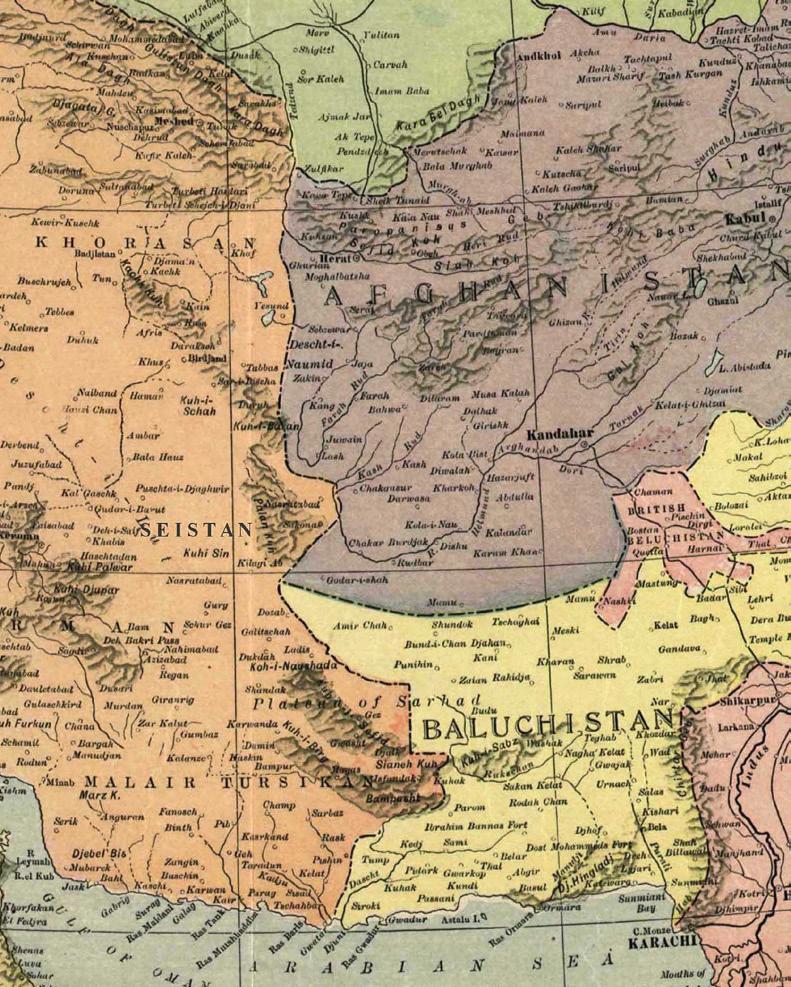
Richard lived with his rugs, enjoyed them as much as he could even though there were obviously many more than he could actually view at any one time. During the year it took to produce the book - a project that miraculously energized him in spite of poor health — he continued to view Textile Museum and Hajii Baba zoom presentations with unwavering interest and curiosity while recalling details of from whom and where he had acquired everything he owned. Offering the collection at auction was unplanned but with his sad passing, long-time friends and associates know he would have liked for others to enjoy the rugs, weavings and objects as much as he did throughout his life.
 —Thomas Cole
—Thomas Cole
1. Baluch Prayer Rug, Northwest Afghanistan. A splendid example of Baluch weaving, possibly from northwest Afghanistan adjacent to Khorassan, an area on either side of the political border. The brilliant blue ground provides a lovely contrast to the deeply saturated elements of the field pattern – elegant latch hook medallions containing a beautifully proportioned flower head. The scale on which the elements are drawn is pleasing. If prayer rugs are a “commercial” venture, one wonders for whom such a rug was woven. Undoubtedly, it was held in great esteem in the local markets, just as it is a highly coveted example in a marketplace removed by thousands of miles in a completely different culture a century and half later. 31” x 42” (77cm x 105cm). Asymmetric knot open left, 8h x 11v = 88 kpsi. Colors (11): red, 2 blues (dark, medium), corrosive brown, light yellow/tan, orange red, purple, corrosive olive, corrosive brown, natural ivory/white, faded yellow.
Published: Plate 1. Cole, T. FROM THE LAND OF THE SUN. THE RICHARD STEWART COLLECTION OF BALUCH RUGS, BAGS, AND TRAPPINGS. 2022. $1000-1500 Start: $500
2. Baluch Prayer Rug, Northeast Persia. An older example of a highly collectible type, one which most interested in Baluch rugs would love to keep. The complete kilim end is elaborately detailed, while the top end may be missing something if one believes these ends were intended to be the same length. The blue ground featuring an ascending tree like device in the center appears to be a common theme of these so called Taimuri group rugs entering the marketplace from both sides of the border – northwest Afghanistan and northeast Persia. The elaborate finish of kilim ends suggests the latter. The primary border, too, is one not immediately associated with the rugs from Afghanistan. 36” x 60” (90m x 150cm). Asymmetric knot open left, 8h x 11v = 88 kpsi. Colors (6): medium red, 2 blues (dark, medium), corrosive olive, natural ivory/white, corrosive black.
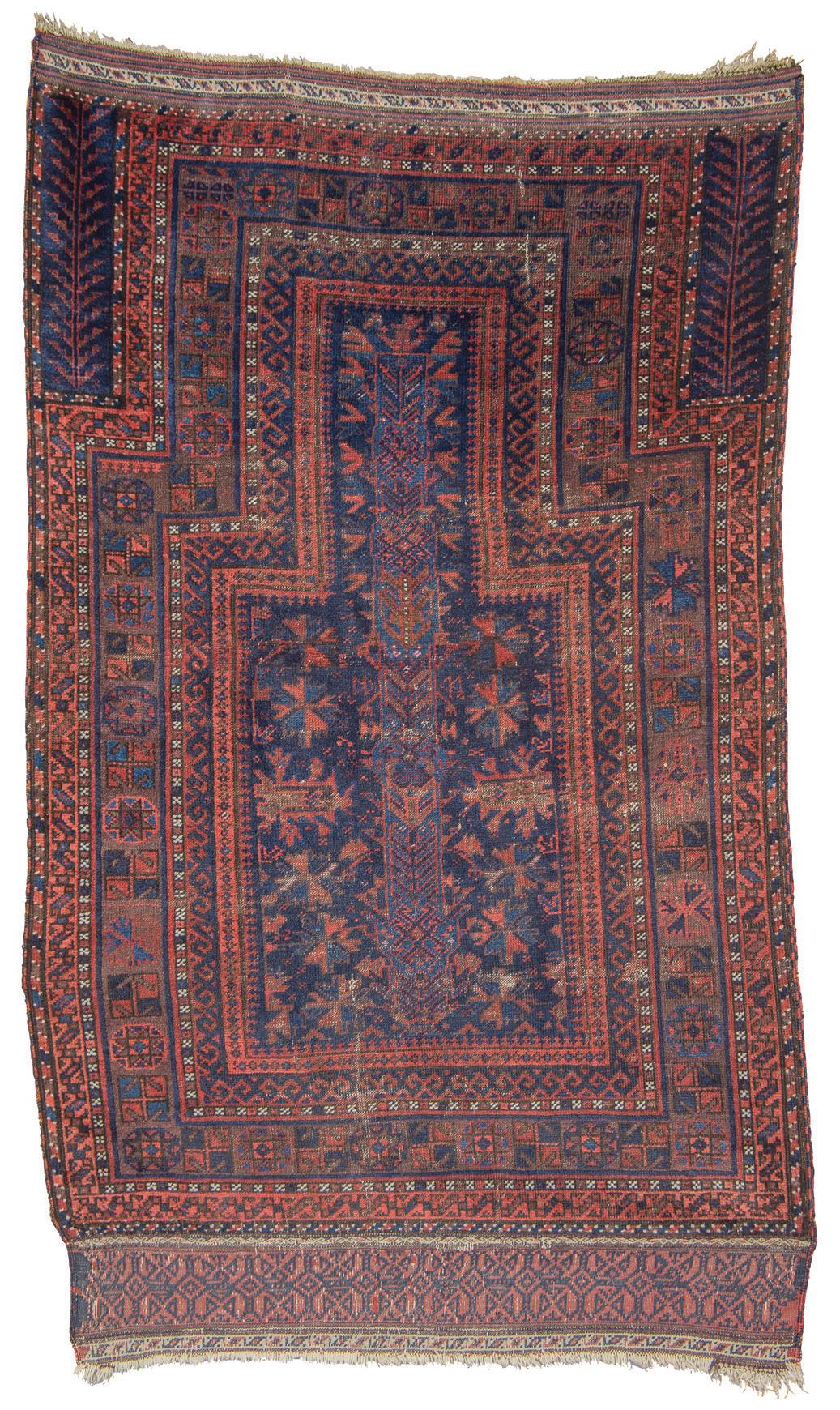
Published: Plate 2. Cole, T. FROM THE LAND OF THE SUN. THE RICHARD STEWART COLLECTION OF BALUCH RUGS, BAGS, AND TRAPPINGS. 2022. $1000-1500 Start: $500

3. Baluch Prayer Rug, Northeast Persia. Though unsure of exact provenance, there is little doubt the primary elements arrayed on the camel ground field color are unusual. When confronted with such patterns that are not often seen (and therefore rare), we often regard them as older. What meaning can the pattern have? It is unsure and to speculate from our distanced perspective in the 21st century may be a bit too ambitious. Apparently of significance to the weaver, the motifs may represent jewelry – Turkmen silver amulets worn by women – but unequivocally to declare it to be exactly that may be presumptuous. 27” x 44” (67cm x 110cm) Asymmetric knot open left, 10h x 10v = 100 kpsi. Colors (7): red, light red, 2 blue/green (dark, medium), olive (corrosive), black, natural ivory/white. Published: Plate
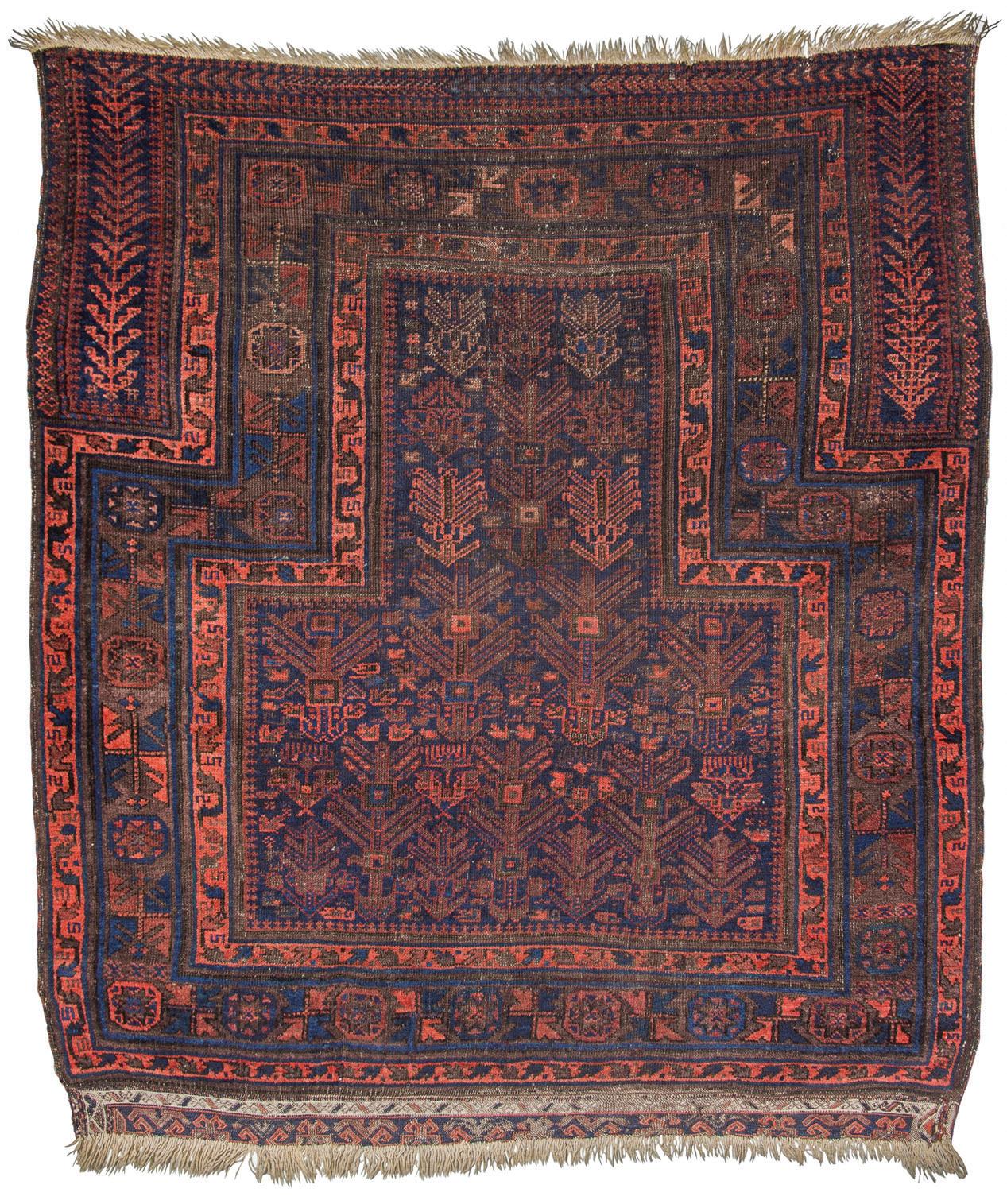
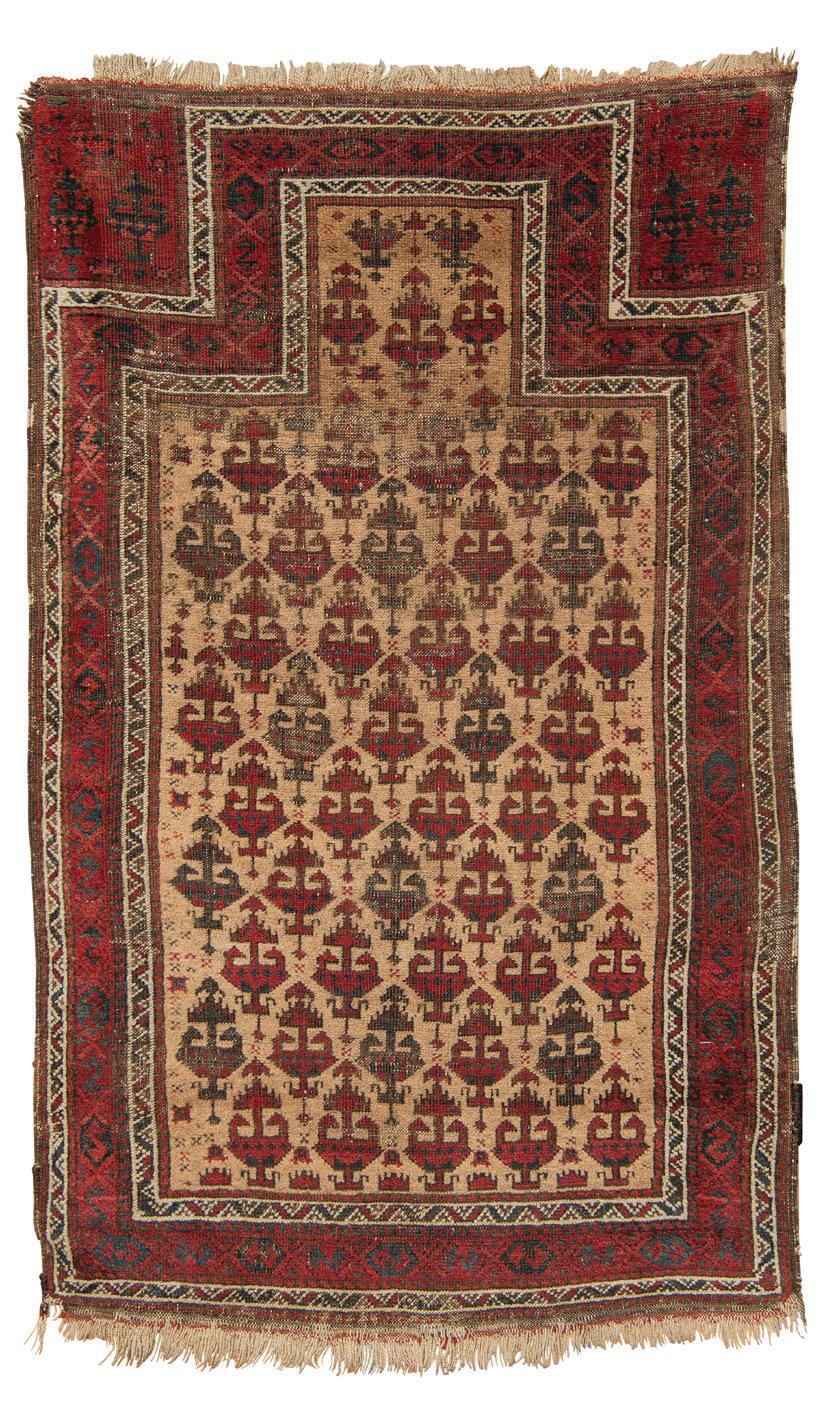
3. Cole, T. FROM THE LAND OF THE SUN. THE RICHARD STEWART COLLECTION OF BALUCH RUGS, BAGS, AND TRAPPINGS. 2022.
$1000-1500 Start: $500
4. Baluch Prayer Rug, Northeast Persia. A prayer rug that stands out from the crowded field. So many were made, possibly to service those travelling to make the Haj pilgrimage, or so one story goes, and it could be true. Or they were made for the urban elite in the local marketplaces of Persia? The complexity of the primary border is quite nice, well drawn and pleasing, especially so with the two more colorful minor borders framing it providing a welcome contrast to the darker more subdued palette. The elaborate kilim end suggests it may have been woven in northeast Persia. Few if any Afghan rugs include such finely executed flatwoven ends. 44” x 50” (110cm x 125cm) Asymmetric knot open left, 7.5h x 9v = 67.5 kpsi. Colors (6): red, salmon red, dark blue, slight corrosive dark brown, natural ivory/white, corrosive olive/brown.
Published: Plate
4. Cole, T. FROM THE LAND OF THE SUN. THE RICHARD STEWART COLLECTION OF BALUCH RUGS, BAGS, AND TRAPPINGS. 2022.
$1000-1500 Start: $500
5.
Rug, Afghanistan. This prayer rug features a classic design type, distinguished by the shape of the prayer arch and repeating shrub like motifs in the field. Every prayer rug of this design type is known as a Dokhtor-i-Qazi. They were woven on both sides of the border, with the Persian examples featuring a fine weave and a classic Khorassan palette. The warm colors of this example suggest it was made in Afghanistan, as does the relatively low knot count, possibly from southwest Afghanistan and the Chakhansur area. Interviewed in HALI 76 (1994), Jerry Anderson suggested there are very few rugs that can be accurately assigned that name (13 to be exact), though his comments are based on local legend that may (or may not) be true. The mysterious East has spawned many legends, most of which are just that – fantastic stories. 32” x 44” (80cm x 110cm) Asymmetric knot open left, 8.5h x 8v = 68 kpsi. Colors (11): salmon red, 2 blue (light, medium), corrosive dark brown, deep red, corrosive olive, purple over-dyed on brown wool (slightly corrosive), natural ivory/white Flatweave ends – salmon red, light salmon red, natural brown, natural ivory/white.
Published: Plate 5. Cole, T. FROM THE LAND OF THE SUN. THE RICHARD STEWART COLLECTION OF BALUCH RUGS, BAGS, AND TRAPPINGS. 2022. $1000-1500 Start: $500
6.
Prayer Rug, Afghanistan. The light palette of contrasting colors is rarely seen in surviving prayer rugs from Afghanistan, suggesting it may be older than others. The palette, though, is distinctly Afghan, with the light salmon red dye, a shade rarely appearing in northeast Persia. The detailing of tertiary elements scattered on the camel-colored ground is a nice touch. The care taken to make it and the condition in which it appears may indicate the rug was held in high esteem and preserved. 33” x 54” (82cm x 135cm) Asymmetric knot open left, 7.5h x 9v = 67.5 kpsi. Colors (10): light salmon red, medium blue, camel brown, dark maroon/red, corrosive brown natural ivory/white, aubergine, natural dark brown, light olive brown, dark blue.

Published: Plate 6. Cole, T. FROM THE LAND OF THE SUN. THE RICHARD STEWART COLLECTION OF BALUCH RUGS, BAGS, AND TRAPPINGS. 2022. $1000-1500 Start: $500

7. Baluch Prayer Rug, Afghanistan. Without the colors or drawing one might expect, the border is quite extraordinary and rarely seen though not unknown by any means. Given the inexact drawing, the border might be considered a provincial interpretation of a Khorassan type. The patterning of the kilim ends also suggests a possible Afghan provenance.
39” x 53” (97cm x 132cm) Asymmetric knot open left, 7h x 10v = 70 kpsi. Colors: Camel wool, brown/red, aubergine, dark blue, medium blue, bleached white, corrosive brown/black.
Published: Plate 7. Cole, T. FROM THE LAND OF THE SUN. THE RICHARD STEWART COLLECTION OF BALUCH RUGS, BAGS, AND TRAPPINGS. 2022. $1000-1500 Start: $500
8. Baluch Prayer Rug, Northeast Persia / Afghanistan. Using an actual prayer rug is not a requirement as deemed by Islam, as many simply choose to perform their daily practice on a straw mat, or even a blanket. Thought of as a prestige item for trade (rather than home domestic use), flatweaves designed for this purpose are uncommon. The supplementary sumac-like design elements floating on the field appear to reflect an ancient design pool – a fertility or kotchanak motif. Why it has been used on a prayer rug of sorts is unknown. Probably from Afghanistan, and possibly a “one off”, it is very unlike other prayer mats or rugs from the standpoint of design. 23” x 46” (57cm x 115cm) Colors (11): red, brownish red, bright orange/red, 2 blues (dark, light/medium), aubergine, light purple, light olive/brown, brown, ivory/white, camel wool.

Published: Plate 8. Cole, T. FROM THE LAND OF THE SUN. THE RICHARD STEWART COLLECTION OF BALUCH RUGS, BAGS, AND TRAPPINGS. 2022. $1000-1500 Start: $500

9. Baluch Prayer Rug, Afghanistan. Prayer rugs often exhibit little evidence of use and were undoubtedly made for the local marketplaces rather than used by the weaver’s family. While the field pattern may appear to be repetitive, the lower section exhibits a different design before changing to the overall leaf pattern and appears to be a rustic example from the looms of Baluch group weavers in western Afghanistan though the primary border is one seen more often used in northeast Persia. 37” x 53” (92cm x 132cm) Asymmetric knot open left, 6.5h x 9.5v = 62 kpsi. Colors (5): red, camel brown, dark aubergine, corrosive black, natural ivory/ white. Published: Plate 9. Cole, T. FROM THE LAND OF THE SUN. THE RICHARD STEWART COLLECTION OF BALUCH RUGS, BAGS, AND TRAPPINGS. 2022. $800-1200 Start: $400
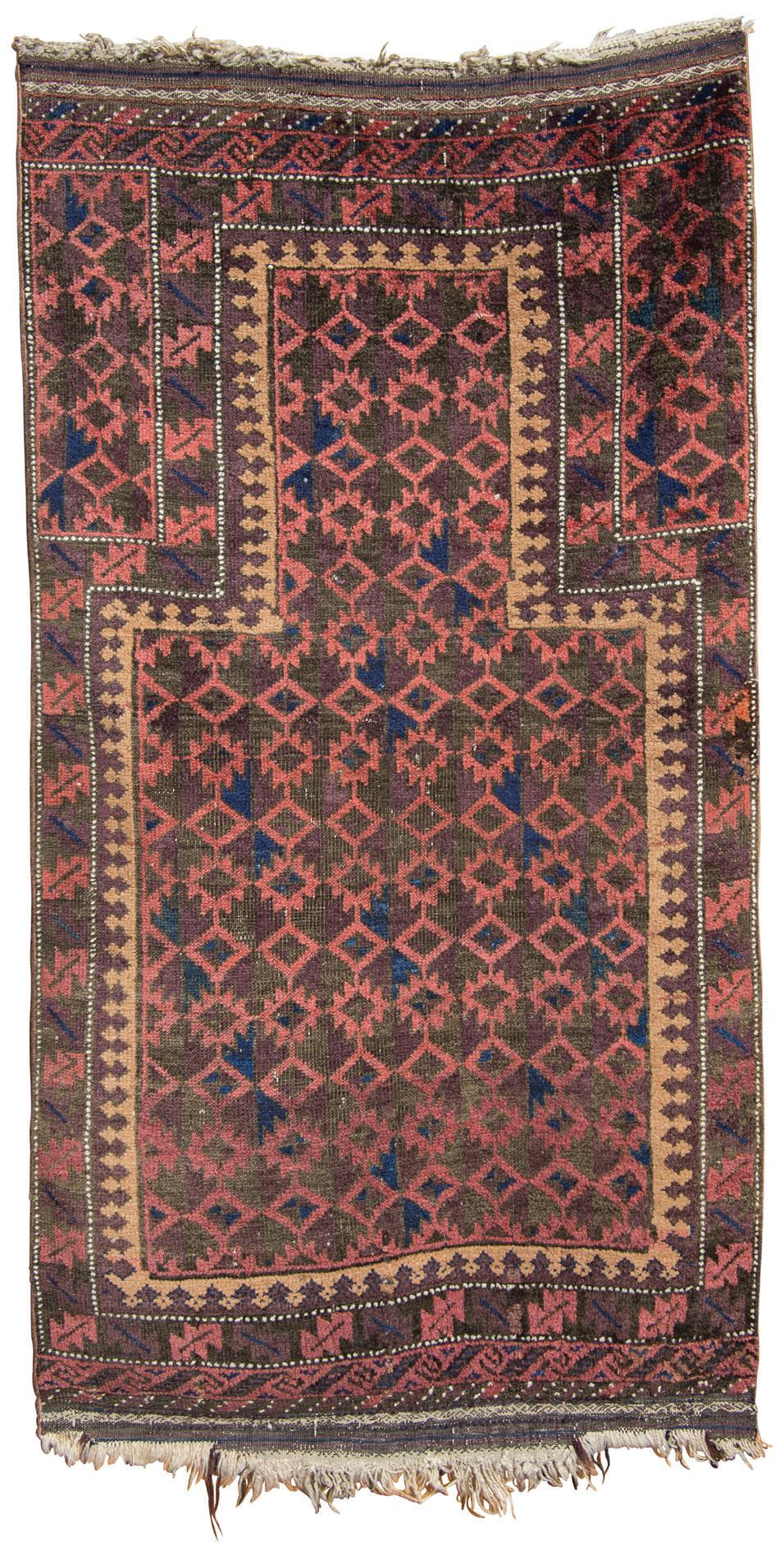
Missing the outer borders on either side (but with complete top and bottom ends), the reciprocity of design with the salmon red ground color may be viewed by some as the primary design alternating from an ashik form to a diamond shape. The use of camel wool confined to the secondary/minor border – yet another reciprocal pattern contrasted with aubergine – is uncommon. 29” x 53” (73cm x 132cm) Asymmetric knot open left, 7h x 9v = 63 kpsi. Colors (7): light salmon red, aubergine, dark blue, camel wool, natural grey, corrosive grey/black, natural ivory/ white. Published: Plate 10. Cole, T. FROM THE LAND OF THE SUN. THE RICHARD STEWART COLLECTION OF BALUCH RUGS, BAGS, AND TRAPPINGS. 2022. $600-900 Start: $300

11. Baluch Prayer Rug, Afghanistan. The reciprocal trefoil secondary border on the white ground and the orientation of the motifs in the border suggest this example may be older than others. The large gol from which the tree of life emerges is an interesting feature as well. Without a saturated palette, the drawing does suggest it has some age. The reciprocal trefoil secondary border in white also suggests an Afghan provenance as does the plain weave striped kilim end 30” x 52” (75cm x 130cm) Asymmetric knot open left, 5h x 11v = 55 kpsi. Colors (7): salmon red, dark blue, natural ivory/ white, corrosive olive/brown, brown/red, camel brown, faded light red. Published: Plate 11. Cole, T. FROM THE LAND OF THE SUN. THE RICHARD STEWART COLLECTION OF BALUCH RUGS, BAGS, AND TRAPPINGS. 2022. $800-1200 Start: $400
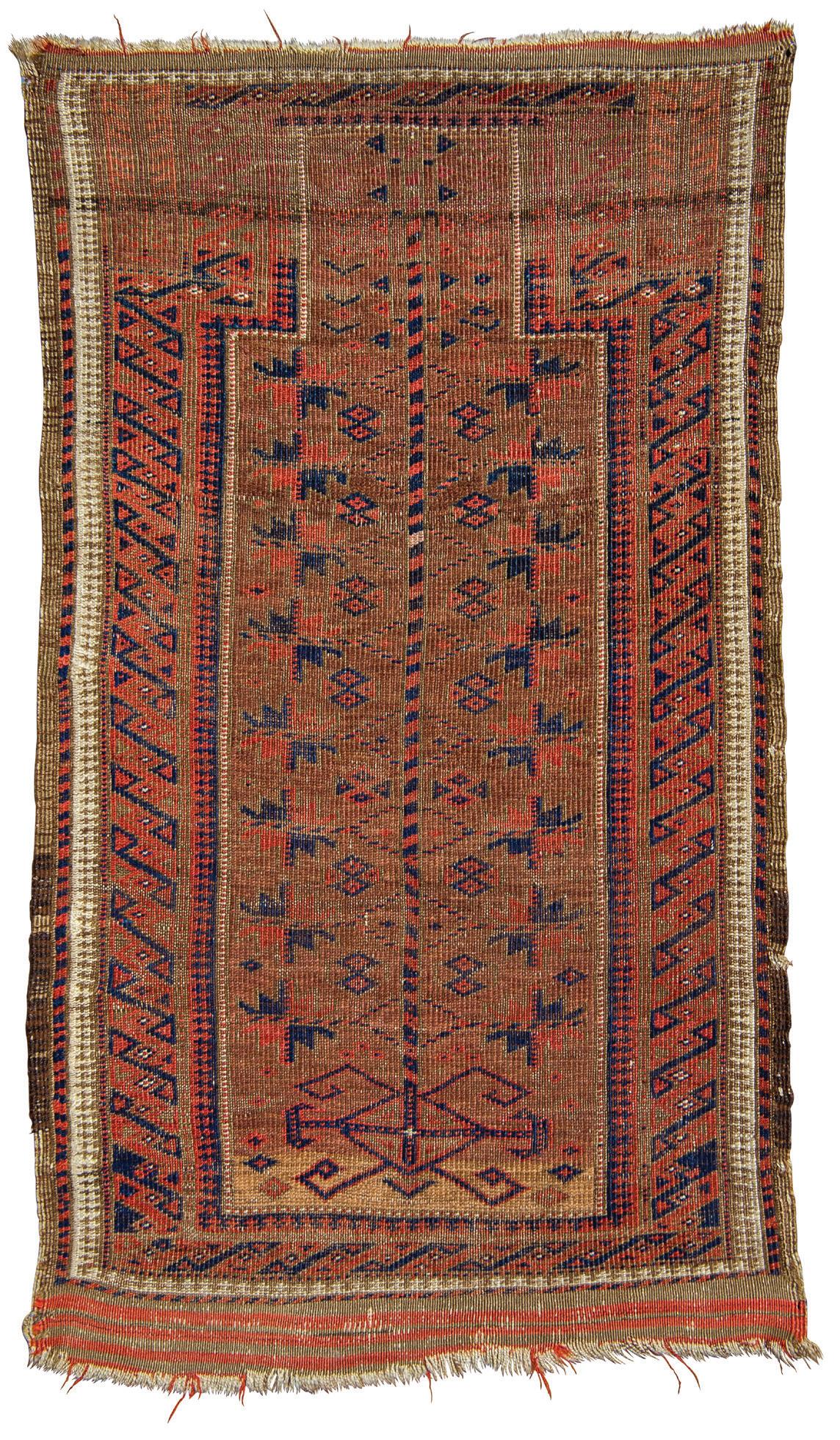
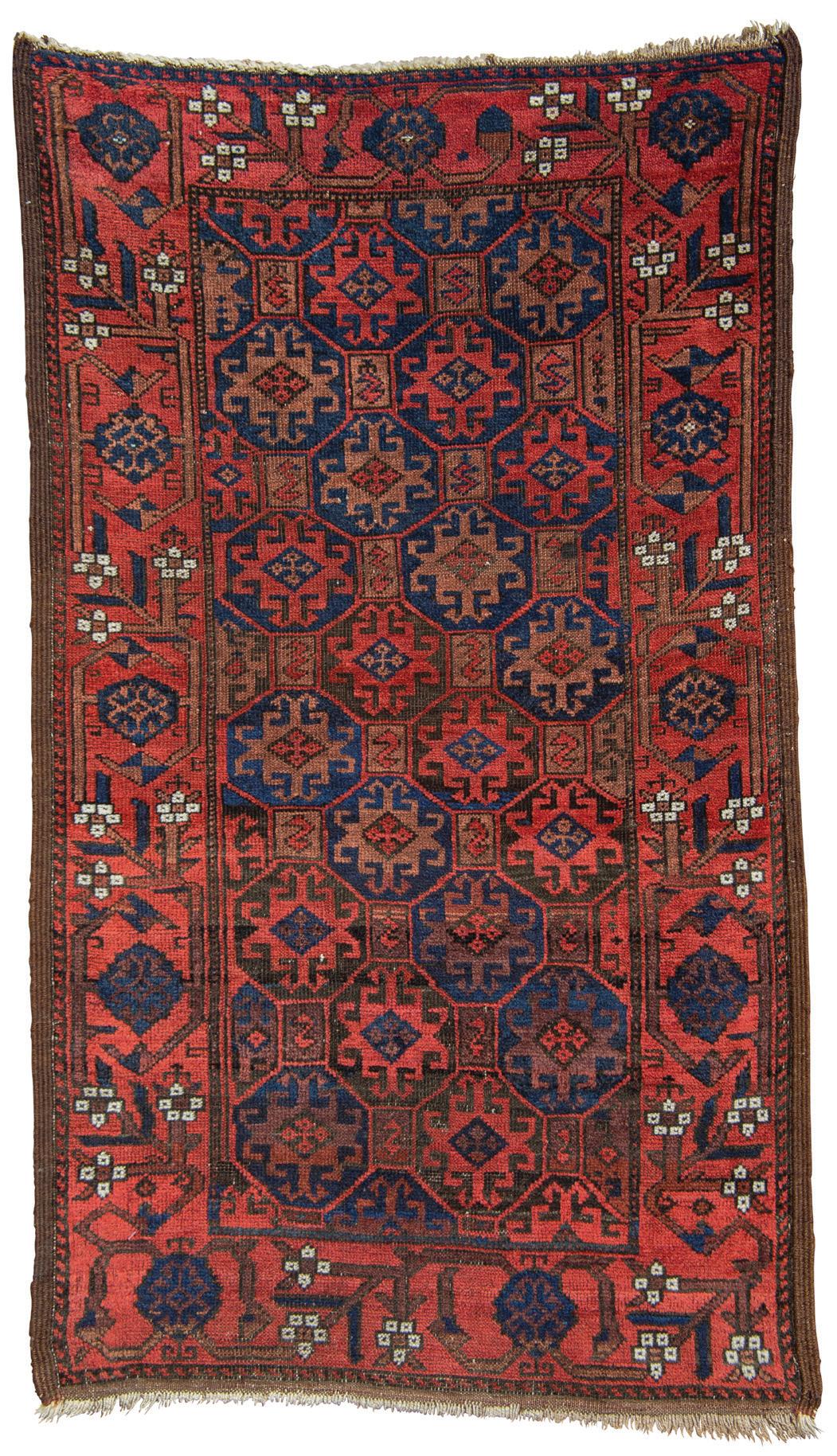
12. Baluch Rug, Northeast Persia. A fine weaving from northeast Persia, with fine silky wool enhancing the clear dyes – all the attributes of Khorassan Baluch rugs, and source for the enduring appeal of Baluch weavings in the marketplace. Some might call this a Taimuri weaving but these attributions remain guesswork, even at the best of times, as the visual appeal transcends marketplace vernacular. 27” x 47” (67cm x 117cm)
Asymmetric knot open left, 8h x 11v = 88 kpsi. Colors (9): red, dark blue, medium blue, corrosive olive/green, aubergine, corrosive black, corrosive olive/brown, corrosive light olive, natural white.
Published: Plate 12. Cole, T. FROM THE LAND OF THE SUN. THE RICHARD STEWART COLLECTION OF BALUCH RUGS, BAGS, AND TRAPPINGS. 2022. $800-1200 Start: $400
13. Baluch Rug, Northeast Persia. Woven with the best wool, the handle is sublime – a joy to handle as the colors literally glow having been applied to the silky wool with apparent professional expertise. Possibly a Taimuri group weaving (?), the blossoms throughout the field radiate an indefinable “presence” seen in the best examples of the design type. The symmetry of each blossom - the ratio of height to width – has been executed with precision, but without any hint of stiff or mechanical drawing. 36” x 60” (90cm x 150cm) Asymmetric knot open left, 8h x 10v=80 kpsi. Colors (8): deep salmon red, dark blue, medium blue, aubergine, corrosive dark brown, corrosive light brown/ olive, natural ivory/white, dark brown goat hair selvedge.

Published: Plate 13. Cole, T. FROM THE LAND OF THE SUN. THE RICHARD STEWART COLLECTION OF BALUCH RUGS, BAGS, AND TRAPPINGS. 2022. $800-1200 Start: $400
14. Baluch Rug, Northeast Persia. A smaller rug, somewhat coarsely woven (for the type), features a clearly articulated design in both the field and border. The primary border is exceptional, with the attractive use of “reciprocal” space, as one’s eye moves between the design in blue and the red ground pattern to identify the primary motif. The zig-zag secondary border framing the field may indicate a later, rather than earlier, date, as few rugs with this type of detailing are “early”. With that said though, the corrosion, the flatwoven kilim ends and integrity of the “running dog” or “wave” minor border is well done, possibly suggesting it is older than some might suppose. 37” x 61” (92cm x 153cm) Asymmetric knot open left. 7h x 8v = 56 kpsi. Colors (6): salmon red, dark blue, light aubergine, natural ivory/white, corrosive black, corrosive grey. Published: Plate 14. Cole, T. FROM THE LAND OF THE SUN. THE RICHARD STEWART COLLECTION OF BALUCH RUGS, BAGS, AND TRAPPINGS. 2022.
$800-1200 Start: $400

15. Baluch Rug, Northeast Persia / Northwest Afghanistan. Collectors have ardently pursued rugs of this boteh design type for many years. This example, though hardly a fine weave, is a charming example with random tertiary elements floating on the ivory field. The primary border is one that might very well be seen in the fine blue ground carpets thought to be woven by the Taimuri but the outer minor border seems to reflect the vocabulary of Afghan weavers and rarely (if ever?) present in Khorassan examples. It may very well be from a Taimuri group rug in northwest Afghanistan. 38” x 63” (95cm x 158cm) Asymmetric knot open left, 6h x 10v = 60 kpsi. Colors (9): dark red/brown, medium red/brown, aubergine, dark blue, medium blue, natural ivory/white, corrosive light brown/olive, corrosive dark brown, natural light grey. Published: Plate 15. Cole, T. FROM THE LAND OF THE SUN. THE RICHARD STEWART COLLECTION OF BALUCH RUGS, BAGS, AND TRAPPINGS. 2022.
$1000-1500 Start: $500
16. Baluch Rug, Northeast Persia. An unusual composition of stars is seldom featured as the primary field design. The primary border appropriated from nearby Turkmen weavers suggests the Khorassan provenance. The secondary border placed on the camel wool field is uncommon. 24” x 46” (60cm x 115cm) Asymmetric knot open left, 7h x 8v = 56 kpsi. Colors (7): camel wool, salmon red, corrosive medium brown, corrosive black, corrosive reddish brown, corrosive plum red, natural ivory/white.

Published: Plate 16. Cole, T. FROM THE LAND OF THE SUN. THE RICHARD STEWART COLLECTION OF BALUCH RUGS, BAGS, AND TRAPPINGS. 2022. $800-1200 Start: $400

17. Baluch Rug, Northeast Persia / Afghanistan. A rather formal rug, finely woven featuring a detailed field design which those who collect the Doktor-i-Qazi type rugs could only hope to see. The tree like device of the field indicates the sure hand of a weaver very familiar with the motif. Perhaps the pattern is related to jewelry – talismans in silver or white metal hung around the neck? As indicated by the graceful lines of the minor border flanking the field with large “S” or dragon forms, the weaver appears to have been very familiar with both. The primary border is an extremely pleasing composition with an alternating flower head and Turkic inspired kotchanak or fertility symbol with ancient roots dating to (or before) the Scythian period of Central Asian history (200 BCE). 32” x 57” (80cm x 143cm) Asymmetric knot open left, 9h x 9v = 81 kpsi. Colors (6): red, salmon red, dark blue, slightly corrosive dark brown, natural ivory/white corrosive olive/brown.
Published: Plate 17. Cole, T. FROM THE LAND OF THE SUN. THE RICHARD STEWART COLLECTION OF BALUCH RUGS, BAGS, AND TRAPPINGS. 2022.
$1000-1500 Start: $500
18. Baluch Rug, Northeast Persia. Pile weavings attributable to the Arab Baluch tribal groups of Khorassan are easily identified by merely looking at them, and confirmed by the atypical technique (asymmetric knot, open right). The primary gol of the field is one apparently used exclusively by these groups, but alternately appears in silk embroidery from Baluchistan. The primary border surrounding the field, too, is apparently a feature seen only in these tribal rugs. 36” x 63” (90cm x 158cm) Asymmetric knot open right, 6.5hx 9.5v = 61.5 kpsi. Colors (7): 2 red (dark, medium), blue, 2 corrosive brown (dark, medium), natural black, natural ivory/white. Published: Plate 18. Cole, T. FROM THE LAND OF THE SUN. THE RICHARD STEWART COLLECTION OF BALUCH RUGS, BAGS, AND TRAPPINGS. 2022.

$800-1200 Start: $400

19. Baluch Rug, Northeast Persia. With a somewhat limited palette that seems atypical for the group, the field ornaments are very different than what normally encounters in this group. The motifs in the corners possibly suggest a sub-group.The coarse knotting corresponds to early accounts though the colors, hardly garish, do not. 31” x 57” (78cm x 143cm) Asymmetric knot open right, 5h x 6v = 30 kpsi. Colors (7): camel wool, salmon red, dark blue, light brownish purple, aubergine, natural brown/olive, natural ivory/ white. Published: Plate 19. Cole, T. FROM THE LAND OF THE SUN. THE RICHARD STEWART COLLECTION OF BALUCH RUGS, BAGS, AND TRAPPINGS. 2022.
$800-1200 Start: $400
20. Baluch Main Carpet, Northeast Persia / Northwest Afghanistan. A rather grand example, more likely woven in NW Afghanistan, a supposition based on the kilim ends. One might expect a different design and technique if made in Khorassan? The density of design, while some might consider it “busy”, shows the effort put into producing what must have been a carpet held in high esteem by the weavers. With no problem calculating the allotted space to accommodate the design, the weaver seems to have been in full command, and was probably pleased with the result. The deeply saturated palette and brilliant indigo dyes seen suggests no expense was spared in procuring the materials. 80” x 104” (200cm x 260cm) Asymmetric knot open left, 6.5h x 10v = 65 kpsi. Colors (9): red, dark blue, medium blue, light blue, corrosive aubergine, corrosive black, corrosive dark brown, natural ivory/ white, natural brown (flatwoven end). Published: Plate 20. Cole, T. FROM THE LAND OF THE SUN. THE RICHARD STEWART COLLECTION OF BALUCH RUGS, BAGS, AND TRAPPINGS. 2022. $2000-4000 Start: $1000
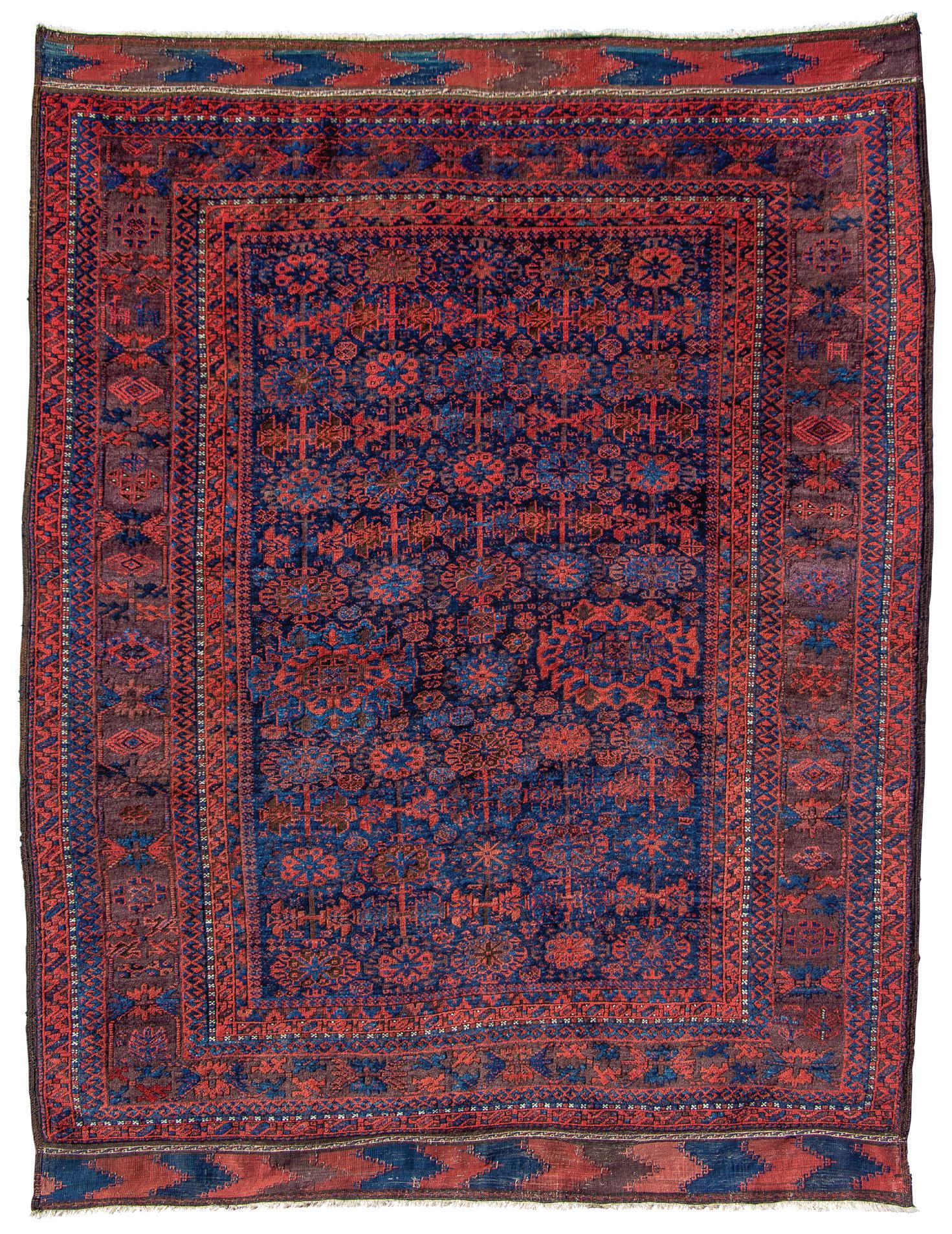

21. Baluch Main Carpet, Southwest Afghanistan. Featuring a design known in the Afghan marketplace as kalam dhani (pen holder) variations of this pattern are commonly thought to characterize classic examples of the type. Possibly related to the palmettes of Persian city rugs, others have called it a harshang pattern. Either derived from or related to the urban prototype, we see unusual details within the palmettes. The brilliant palette and choice of colors with a preponderance of the salmon orange/ red may suggest an origin closer to the Seistan region, placing it in southwest Afghanistan and the Chakhansur area. 52” x 101” (130cm x 252cm) Asymmetric knot open left, 6.5h x 9v = 58.5 kpsi. Colors (10): salmon orange/red, dark blue, medium blue, corrosive dark brown, natural ivory/white, red, dark aubergine, corrosive black, medium brown (flatwoven end), black.
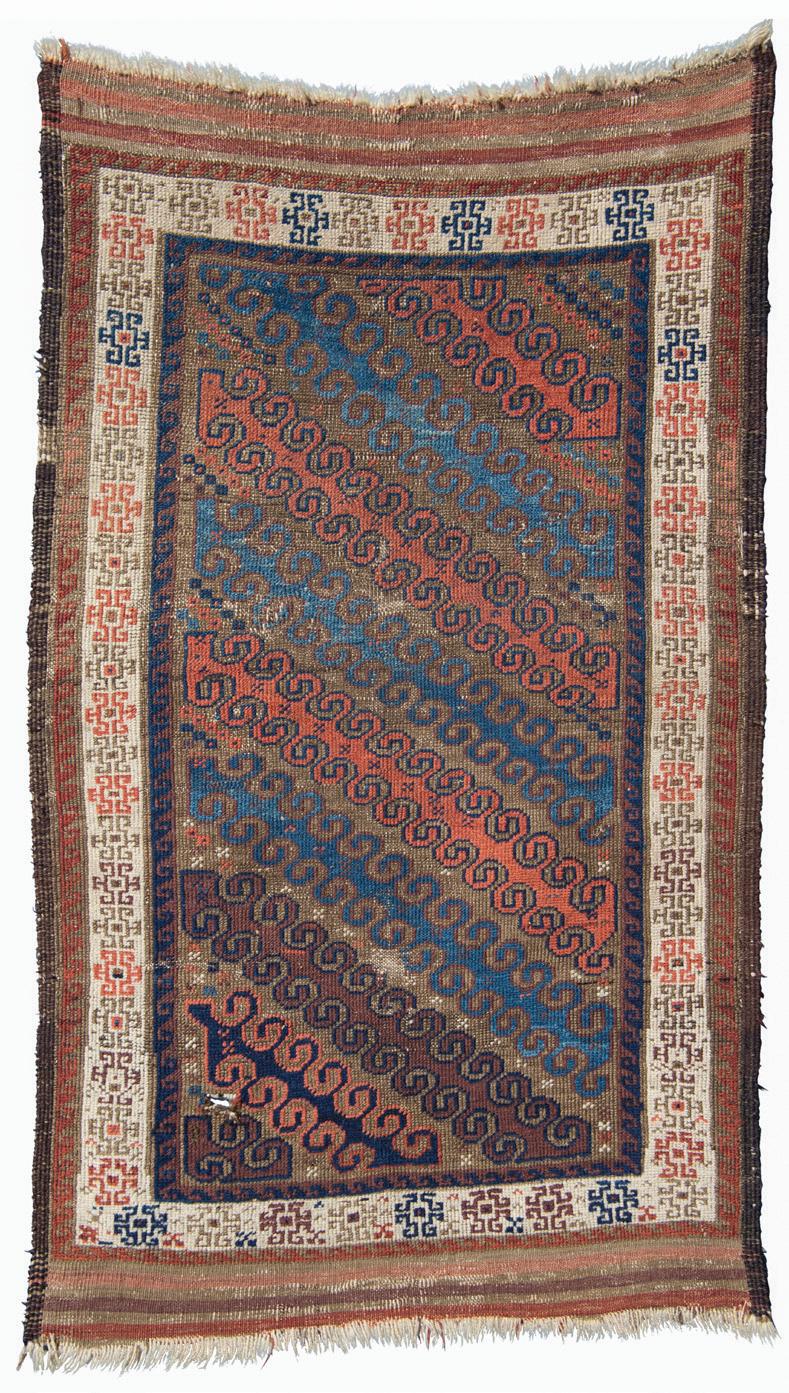

Published: Plate 21. Cole, T. FROM THE LAND OF THE SUN. THE RICHARD STEWART COLLECTION OF BALUCH RUGS, BAGS, AND TRAPPINGS. 2022. $2000-4000 Start: $1000
22. Baluch Rug, Northeast Persia / Northwest Afghanistan border area. Some may consider the field design to be a classic theme of the weaving group identified by Dewitt Mallary as Bahlul, woven with the distinctive symmetric or Turkish knot. The primary border with a white ground is apparently different and seldom (if ever?) seen. Given the vast majority of extant examples of this group featuring a symmetric or Turkish knot are found with a synthetic or chemical (i.e. late) red dye, no such dyes are present here, suggesting it is older than others. To some collectors, this is very important though many of the presumed later examples feature similar designs to those seen in what others believe are earlier examples. 27” x 47” (68cm x 118cm) Symmetric knot, 7.5 x 8v = 60 kpsi. Colors (11): brownish salmon/red, 2 brownish red (medium, light), 3 blue (dark, medium, light), corrosive olive. Flatwoven ends – non-corrosive olive, light brown, salmon red, purple.
Published: Plate 22. Cole, T. FROM THE LAND OF THE SUN. THE RICHARD STEWART COLLECTION OF BALUCH RUGS, BAGS, AND TRAPPINGS. 2022. $1000-1500 Start: $500
23. Baluch Rug, Northeast Persia / Northwest Afghanistan border area. A somewhat atypical Bahlul tribal rug, as the border is one commonly seen used throughout Khorassan. Rugs attributable to the Bahlul often include border elements uncommon elsewhere, occasionally medallions (see pls. 22, 24). The motifs on the camel brown wool field appear to be kotchanaks, a repeating fertility symbol seen in many Turkmen rugs but more often used as a secondary design. The colors are mixed, as one might expect with many Bahlul group rugs. 42” x 67” (105cm x 169cm) Symmetric knot, 9h x 11v = 99 kpsi. Colors (14): red, light red, 3 blue (dark, medium, light), light plum red, faded red, corrosive brown, camel brown, blue/black, light blue/green, grey (faded from light green, possibly fuchsine?), natural ivory/white. Published: Plate 23. Cole, T. FROM THE LAND OF THE SUN. THE RICHARD STEWART COLLECTION OF BALUCH RUGS, BAGS, AND TRAPPINGS. 2022. $1000-1500 Start: $500
24. Baluch Rug, Northeast Persia / Northwest Afghanistan border area. Another atypically patterned Baluch rug woven with a symmetric knot. The lattice layout is not one favored by this group though the medallions within are a staple of the design pool. The border pattern, too, reflects the taste of Bahlul group weavers – a repeating Turkic element. Too often, rugs of this group (there are few bags for some reason) often feature a chemical red dye, which is not the case here. The palette of some appears to have that “colder” look I associate with rugs from northeast Persia, while others are warmer, as is the case with this example, suggesting a possible origin closer to Herat in western Afghanistan.

38” x 57” (95cm x 142cm) Symmetric knot, 6.5h x 8v = 52 kpsi. Colors (9): natural camel wool, 2 blues (dark, medium), 2 light orange/reds, light purple, medium olive brown, dark brown, natural ivory/white. Published: Plate 24. Cole, T. FROM THE LAND OF THE SUN. THE RICHARD STEWART COLLECTION OF BALUCH RUGS, BAGS, AND TRAPPINGS. 2022. $1000-1500 Start: $500

25. Baluch Rug, Northeast Persia / Northwest Afghanistan border area. These rugs featuring a symmetric knot appear to belong to a single group based upon more than the knot type but often upon design as well as palette, too. While featuring what appears to be anomalous patterning consisting of three gols – each with an octagon containing an eight-pointed star as the center – possibly related to the gorbaghe gol more often seen in Turkmen weavings. The latch hooks of the primary gols echoed in the secondary designs throughout the field initially confuse an eye searching for an orderly design. The primary border appears to be an angular version of another pattern seen more often in Ersari rugs – one that some have likened to birds in flight but known in the Central Asian marketplaces as the badam or almond pattern. This example, though, is quite unusual, very different than most of this group. 43” x 74” (107cm x 185cm) Symmetric knot, 6.5h x 9.5v = 62 kpsi. Colors (8): 3 reds (with fading), 2 blues (w/abrash), corrosive olive, natural ivory/white, natural brown.
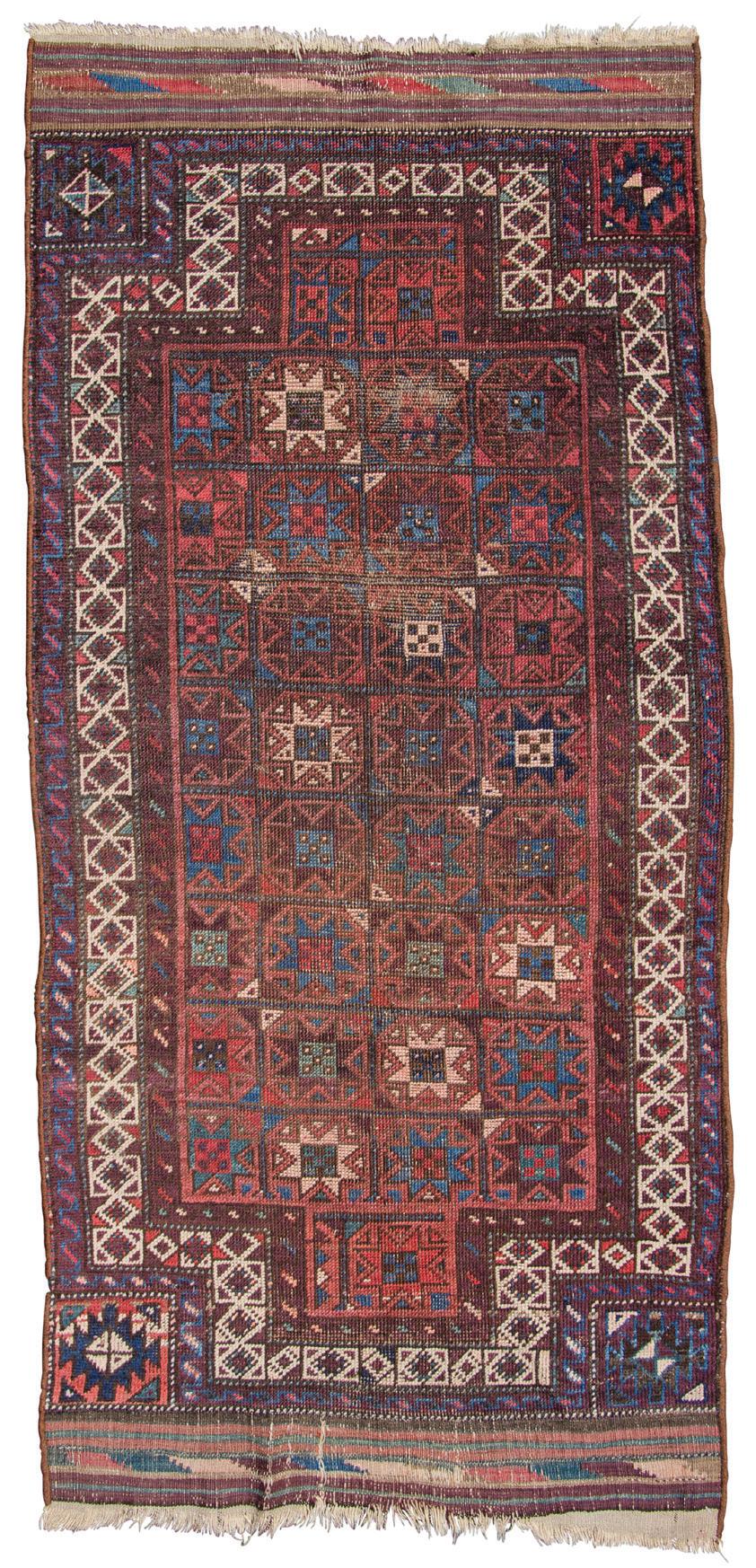
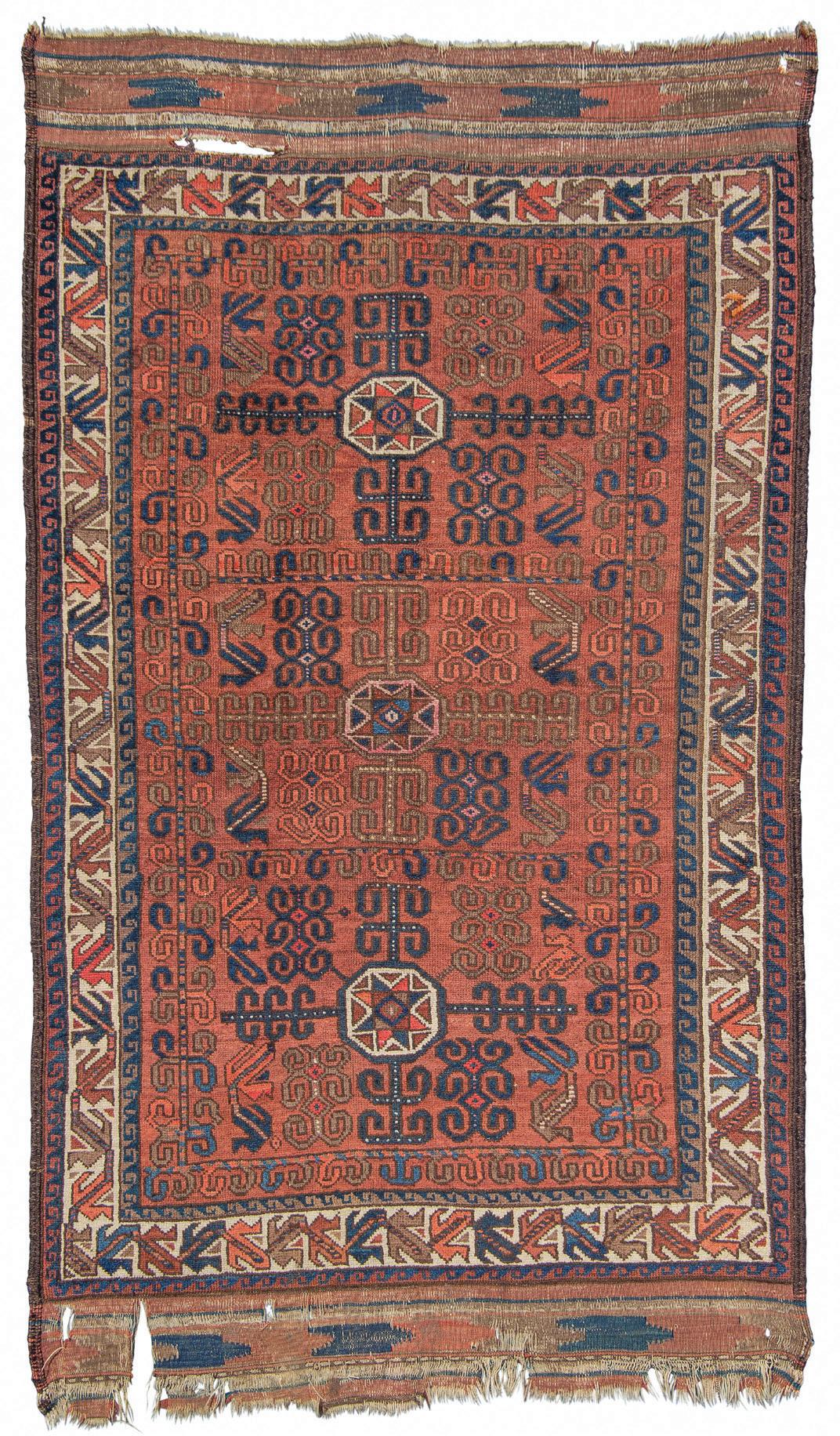
Published: Plate 25. Cole, T. FROM THE LAND OF THE SUN. THE RICHARD STEWART COLLECTION OF BALUCH RUGS, BAGS, AND TRAPPINGS. 2022. $1000-1500 Start: $500
26. Baluch Rug, Northeast Persia / Northwest Afghanistan border area. The double niche of these Bahlul type tribal rugs has been thought by some to define a funerary rug, though with little documentation. The overall wear here would be inconsistent with such use, and how a true funerary rug would make its way onto the market is a question left unanswered. 29” x 62” (72cm x 155cm) Symmetric knot, 7.5h x 6.5v = 49 kpsi. Color: light faded red, 2 blues (dark, medium), blue/green, aubergine, black/brown, natural ivory/white.
Published: Plate 26. Cole, T. FROM THE LAND OF THE SUN. THE RICHARD STEWART COLLECTION OF BALUCH RUGS, BAGS, AND TRAPPINGS. 2022. $1000-1500 Start: $500
27. Baluch Rug, Northeast Persia / Northwest Afghanistan border area. Distinguished by a symmetric (Turkish) knot, the rug may be attributable to the “Bahlul” weaving groups located in east Persia or west Afghanistan. The colorful palette, including 12 shades of different colors is unusual, more than what one normally finds in rugs from these weavers. Could it be older than others? Possibly. The design is obviously “different” with the field divided into two compartments, each with the serrated diamond motifs commonly called “Mushwani”. The reciprocal trefoil border framed by an outer (?) minor border of multi-colored gols is atypical. Given the selvedge is not original, it is unclear what or if there was once another minor border. With no published analogies, it is impossible to know for sure. The free hand drawing likely indicates the absence of a model from which the weaver was working, contributing to a visually exciting composition, further accentuated by the incomplete half gol at the top end of the field. While the change in patterning in the border pattern is an unusual feature, it is more interesting than beautiful. Why the weaver (or weavers) made this change remains unknown to us at this late date in time. 36” x 52” (90cm x 130cm) Symmetric knot, 9h x 7.5v = 67.5 kpsi. Colors (12): 4 red, 3 blue, blue/green, green, corrosive brown, olive brown (no corrosion evident), natural ivory/white. Published: Plate 27. Cole, T. FROM THE LAND OF THE SUN. THE RICHARD STEWART COLLECTION OF BALUCH RUGS, BAGS, AND TRAPPINGS. 2022. $1000-1500 Start: $500

28. Baluch Bag face, Northeast Persia. Though woven in the style of “Arab Baluch” rugs with an asymmetric knot, open right, this bag face appears to be more closely related to neighboring Afshar tribal groups in northeast Persia, and the only example of Khorassan Afshar/Baluch weaving in this collection – they are few and far between. The border elements appear to be reminiscent of a pattern seen in early stone seals excavated in Central Asia, possibly representing trees. The elaborate flatweave at the bottom end is well drawn, a very elegant end finish suggesting it may have been held in high esteem by the weaver. 28” x 27” (70cm x 67cm) Asymmetric open right, 8h x 11v = 88 kpsi. Colors (6): 2 blues (dark, medium), red, light reddish-purple, natural ivory/ white, corrosive brown. Published: Plate 28. Cole, T. FROM THE LAND OF THE SUN. THE RICHARD STEWART COLLECTION OF BALUCH RUGS, BAGS, AND TRAPPINGS. 2022. $500-1000 Start: $250

29. Baluch Bag Face, Northeast Persia. Another classic design type from the Baluch weavers of northeast Persia. The square medallion containing an alternating blue and white diamond is executed with a degree of elegant formality, as the serrated edges recall the details of silver jewelry from the region. The flowers within latch hook medallions surround the central pattern, too, are nicely drawn. With an abundance of tertiary patterning scattered on the blue ground as well as the classic “stars-and-bars” primary border, it is a visually impressive example. 35” x 33” (87cm x 82cm) Asymmetric knot open left, 7h x 10v = 70 kpsi. Colors: 2 blues (dark, medium), red, corrosive olive, natural white. Published: Plate 29. Cole, T. FROM THE LAND OF THE SUN. THE RICHARD STEWART COLLECTION OF BALUCH RUGS, BAGS, AND TRAPPINGS. 2022. $500-1000 Start: $250
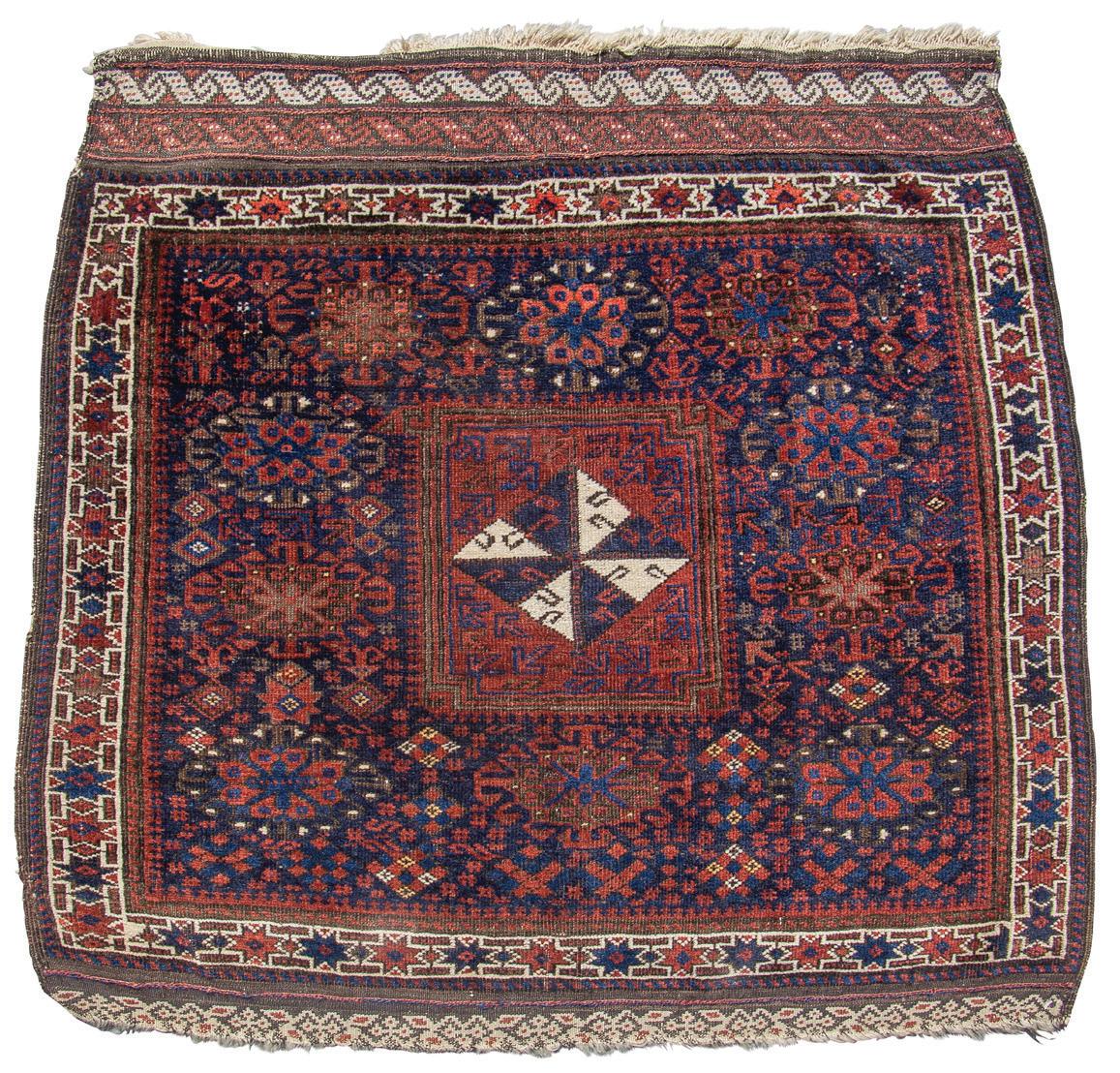
30. Baluch Bag Face, Northeast Persia. Fragmented with good reason, it is apparently older than many others of the design type. The handle is supple due to the fine knot count and good wool. The jagged diagonal lines connecting the flowers, rather than curvilinear tendrils, are well done, imparting a sense of movement – a degree of tension – enhancing the visual impact. The three different flower types separate it from those considered later which often feature only two. Apparently, this is a tribal rendering of the classic mina khani design type without quirky drawing, but a balanced artistic composition.
28” x 23” (70cm x 57cm) Asymmetric knot open left, 10h x 11v = 110 kpsi. Colors (9): red, dark blue, blue/ green, salmon red, corrosive medium brown, purple/ cochineal, medium brown (natural ?), natural ivory/ white, corrosive dark brown. Published: Plate 30.
Cole, T. FROM THE LAND OF THE SUN. THE RICHARD STEWART COLLECTION OF BALUCH RUGS, BAGS, AND TRAPPINGS. 2022. $500-1000 Start: $250

32. Bag Face, Northeast Persia. With the familiar layout of design featuring zoomorphic figures in the four corners of the field, the rectangular form to the field, rather than the more familiar octagon is an interesting feature. The devices in the primary border could have easily been used to surround a central octagon often present in other examples. 29” x 24” (72cm x 60cm) Asymmetric knot open left, 9h x 12v =108 kpsi. Colors (10): salmon red, 2 purple (medium/dark), 2 brown (medium, dark) 2 natural brown (medium, dark), light orange/ red (faded, slightly corrosive), corrosive light orange/red (unfaded), natural ivory/ white. Published: Plate 32. Cole, T. FROM THE LAND OF THE SUN. THE RICHARD STEWART COLLECTION OF BALUCH RUGS, BAGS, AND TRAPPINGS. 2022. $500-1000 Start: $250
31. Baluch Bag Face, Northeast Persia. A rather regal example of a well-known design type, with both striking color – boldly drawn – almost “over-sized” with the classic 2-1-2 arrangement of the gols or flower heads. Distinguished by clear color, with ample space for the precise drawing in addition to being somewhat larger than usual, it is an excellent example. 32” x 35” (80cm x 87cm) Asymmetric knot open left, 8h x 11v = 88 kpsi. Colors (7): salmon red, brown/red, dark blue, light blue, natural ivory/white, corrosive medium brown, corrosive light brown. Published: Plate 31. Cole, T. FROM THE LAND OF THE SUN. THE RICHARD STEWART COLLECTION OF BALUCH RUGS, BAGS, AND TRAPPINGS. 2022. $500-1000 Start: $250
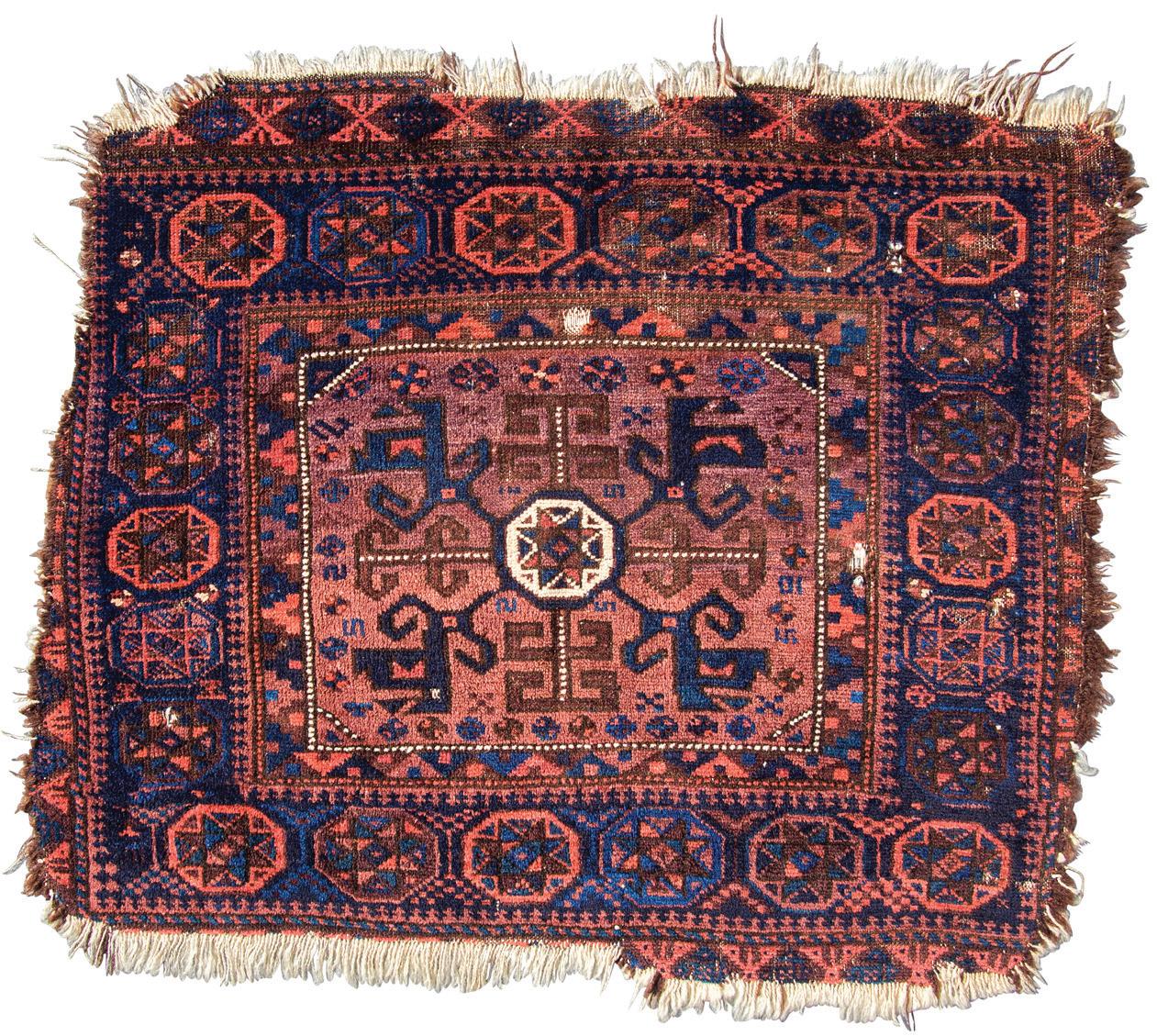
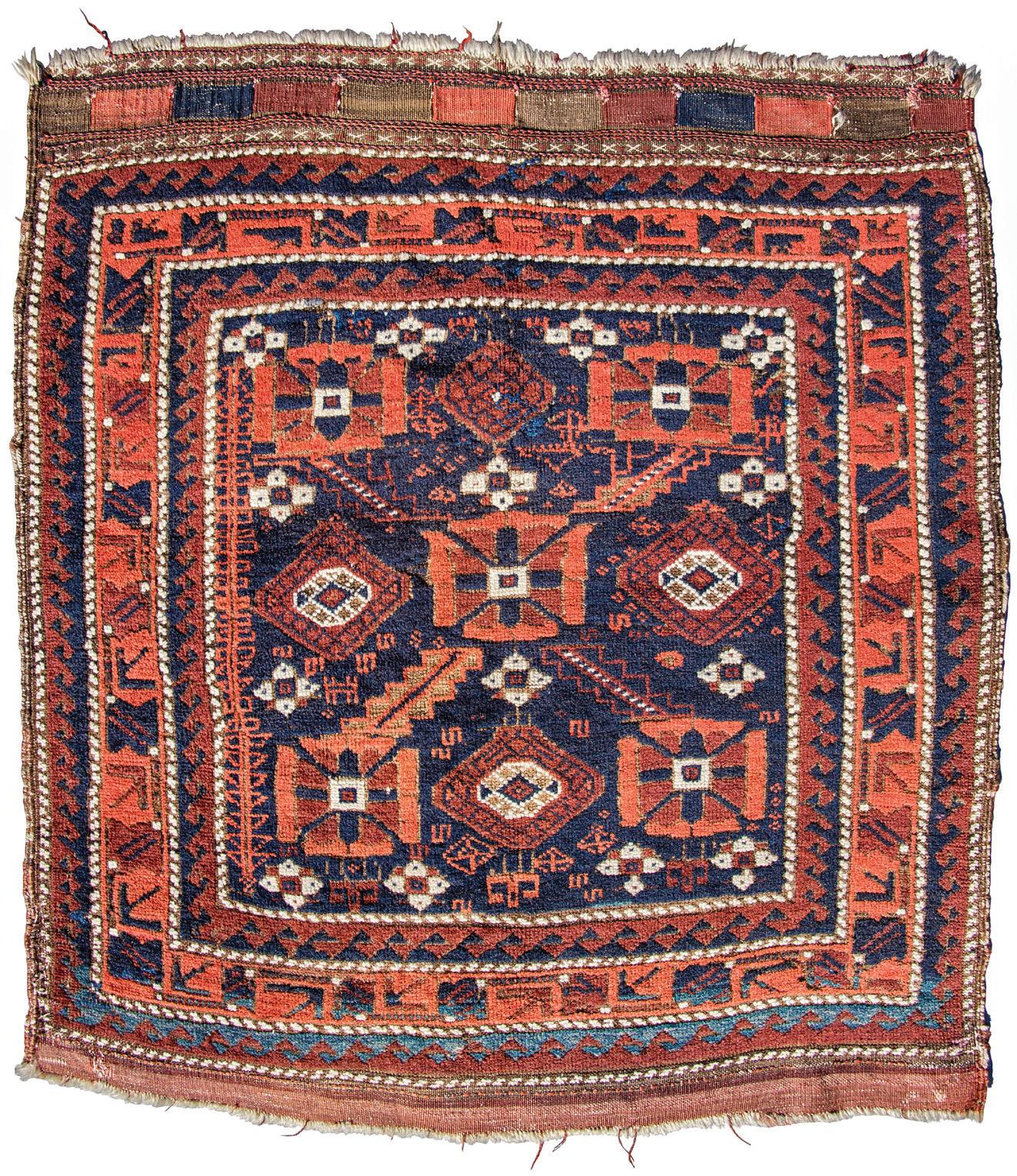
34. Baluch Bag Face, Northeast Persia. Among the most cherished and renowned weaving groups – the Taimuri – this bag face, though not the earliest of the group, is finely woven and may have been cherished by the weavers. A number of larger bag faces of this type have survived, probably due to the fact they may have been woven for special occasions while not serving a strictly utilitarian function. Though there are a few minor repairs, the damage may have been caused by animals (rodent or moths?) rather than by use. It is probably one half of a larger khorjin or saddle bag. 30” x 30” (75cm x 75cm) Asymmetric knot open left, 10h x 12v = 120 kpsi. Colors (7): red, brown/aubergine, corrosive brown, brown/red, dark blue, corrosive black, natural ivory/white. Published: Plate 34. Cole, T. FROM THE LAND OF THE SUN. THE RICHARD STEWART COLLECTION OF BALUCH RUGS, BAGS, AND TRAPPINGS. 2022. $500-1000 Start: $250
33. Baluch Bag face, Northeast Persia. The marketplace preference among Baluch collectors for rugs and bags from northeast Persia is known, and it is bags of this design type that have fascinated the cognoscenti for many years now. A few aficionados have gone so far as to suggest that some may date to the 18th century, based on little more than speculation. Baluch wool is notoriously soft and lustrous, hardly given to longevity in situ. The suggestion of animal forms in the quartered sections of the central medallion, more often drawn as an octagon rather than this square, may be derived from a much earlier Anatolian design. Though as old as some, the plush pile and nicely drawn flowers in the field distinguish it from the rest. 33” x 27” (82cm x 67cm) Asymmetric knot open left, 10h x 9v = 90 kpsi. Colors (7): red, blue, corrosive light aubergine, light reddish/orange, natural brown, olive/light brown, natural ivory/white. Published: Plate 33. Cole, T. FROM THE LAND OF THE SUN. THE RICHARD STEWART COLLECTION OF BALUCH RUGS, BAGS, AND TRAPPINGS. 2022.
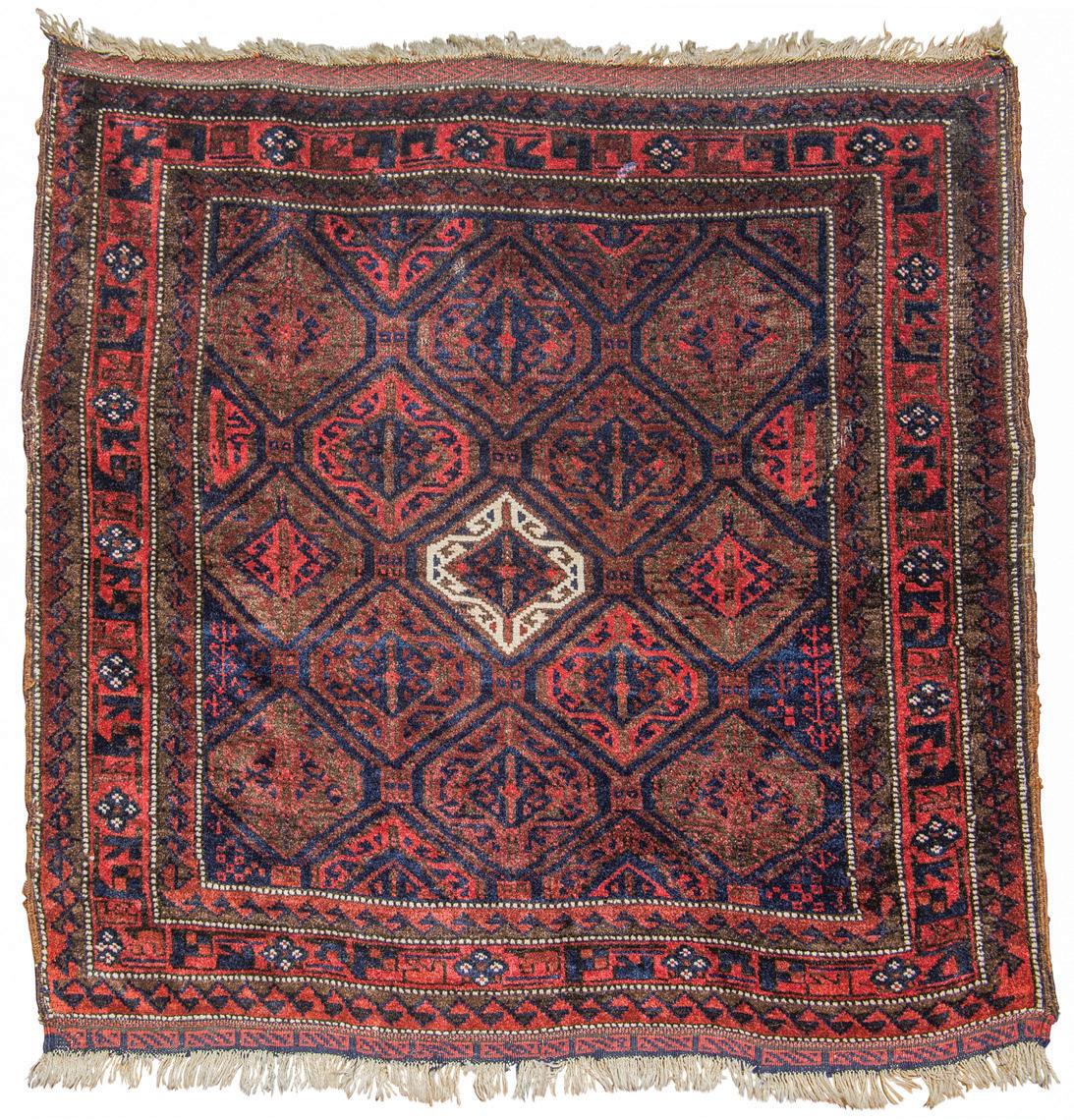
$500-1000 Start: $250
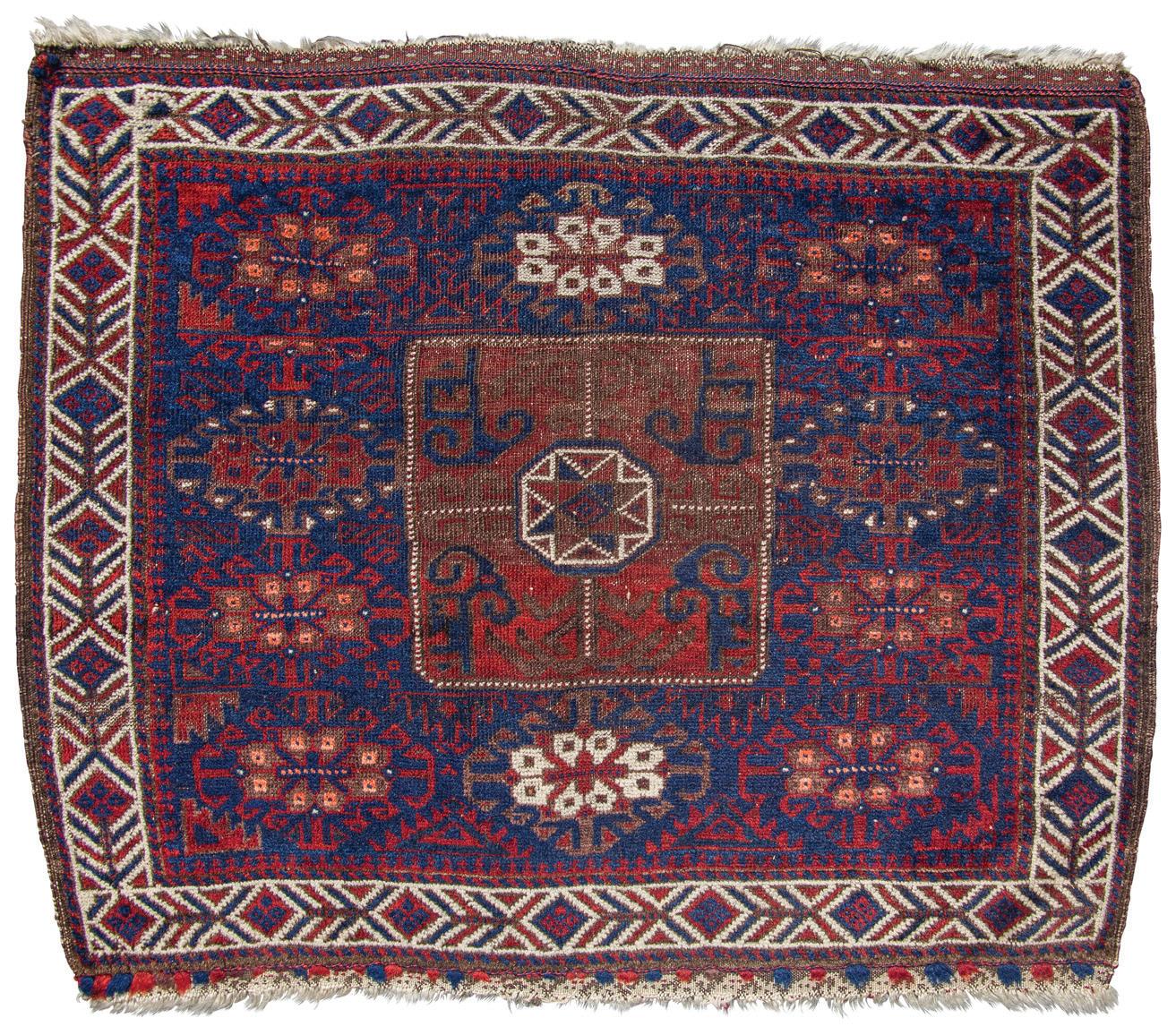
36. Baluch Bag Face, Northeast Persia. Some collectors prefer these rugs without silk, but its presence may suggest the bag (once part of a complete double bag/khorjin) was important to the weaver. Silk was an expensive import rather than a commonly available domestic product. Possibly purchased already dyed, it is unknown if the weaver knew some of the purple would fade as it has. While the zoomorphic figures in the quartered panels of the central octagon is a design type often seen, the diversity of patterns surrounding it including blossoms, medallions as well as a variety of tertiary elements is somewhat uncommon. The inner reciprocal trefoil border framing the field surrounded by the white ground primary border seems to be classic touch and the white ground primary border is one associated with those of northeast Persian origin. 30” x 30” (75cm x 75cm) Asymmetric knot open left, 8h x 12v = 96 kpsi. Colors (11): red, 2 blue (dark, medium), purple, natural ivory/white, purple overdye on brown wool, natural brown, corrosive medium brown, silk – purple, purple w/tip fade, natural undyed[?] tan silk.


Published: Plate 36. Cole, T. FROM THE LAND OF THE SUN. THE RICHARD STEWART COLLECTION OF BALUCH RUGS, BAGS, AND TRAPPINGS. 2022. $500-1000 Start: $250
35. Baluch Bag Face, Northeast Persia. A classic design type featuring zoomorphic figures in the quartered octagon. These animal forms may be closely related to an Anatolian precursor from centuries before. Some may wonder why and how some of the Baluch patterning could ever be related to rugs from a much earlier period, but history confirms the presence of Seljuq armies in Khorassan in the 11th century. While assuming a direct connection to surviving 19th century rugs is tenuous, the rugs tell a story, not all of which we are able to fully understand, leaving us to rightly speculate. 33” x 24” (82cm x 60cm)Asymmetric knot open left, 7h x 11v = 77 kpsi.Colors (8): brown/red, salmon/red, 3 blues (dark, medium, light), corrosive black, corrosive brown, natural ivory/white. Published: Plate 35. Cole, T. FROM THE LAND OF THE SUN. THE RICHARD STEWART COLLECTION OF BALUCH RUGS, BAGS, AND TRAPPINGS. 2022. $500-1000 Start: $250
37. Baluch Bag Face, Northeast Persia. Much has been written about the influence or, perhaps better stated, the appropriation of Turkmen design by Baluch weavers in northeast Persia. The central field pattern, known as the aina gol design, more often appears in Tekke Turkmen trappings and bags. The primary border, with the socalled “curled-leaf” motif, too, has been used by different Turkmen tribes, including the Tekke, Ersari and Yomut groups. Given the unusually fine weave, one might suppose the weavers held this bag in high esteem 24” x 24” (60cm x 60cm) Asymmetric knot open left, 12h x 13.5v = 162 kpsi. Colors (6): salmon red/brown, red, dark blue, aubergine, bleached ivory/white, natural light brown. Published: Plate 37. Cole, T. FROM THE LAND OF THE SUN. THE RICHARD STEWART COLLECTION OF BALUCH RUGS, BAGS, AND TRAPPINGS. 2022. $500-1000 Start: $250
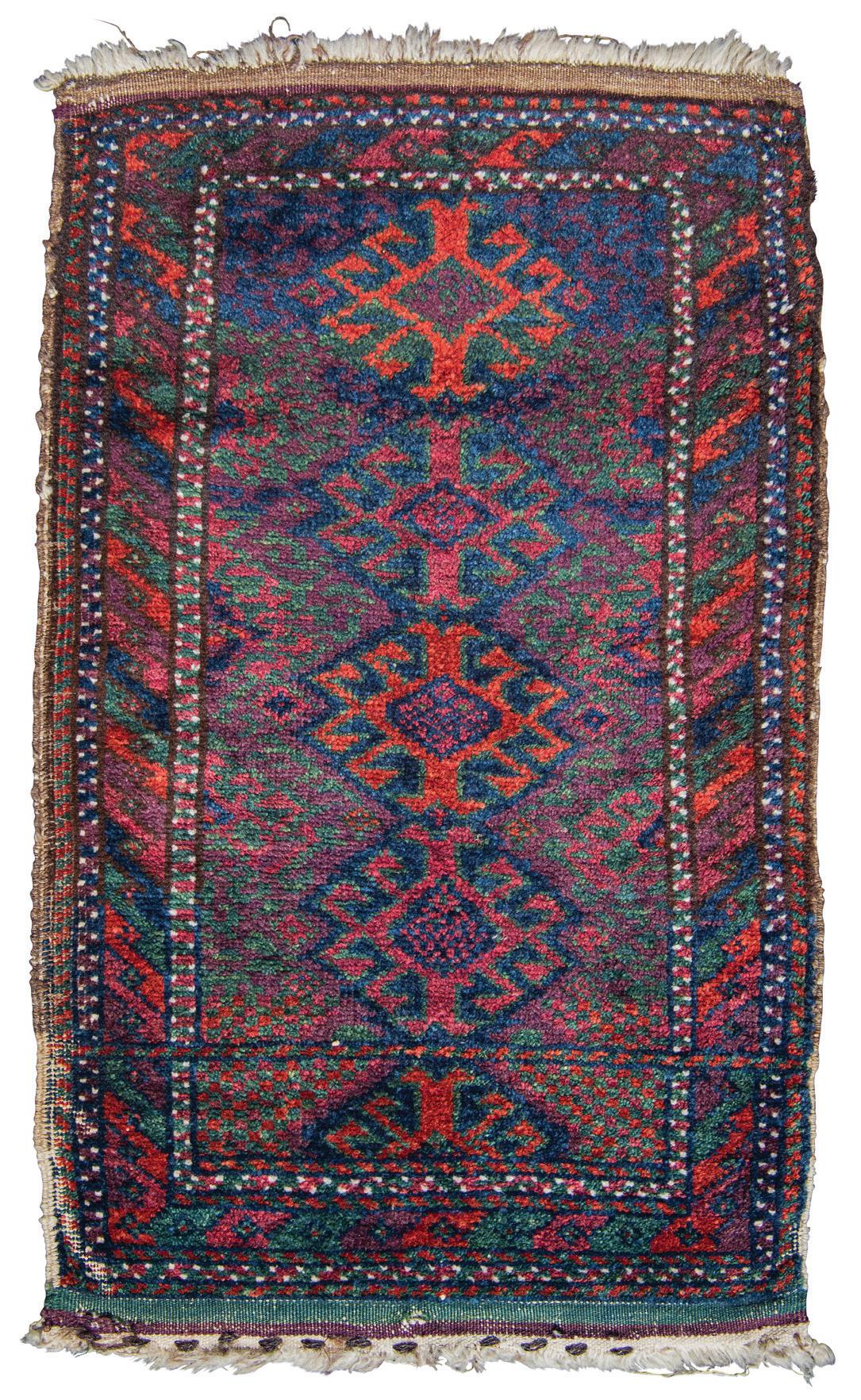
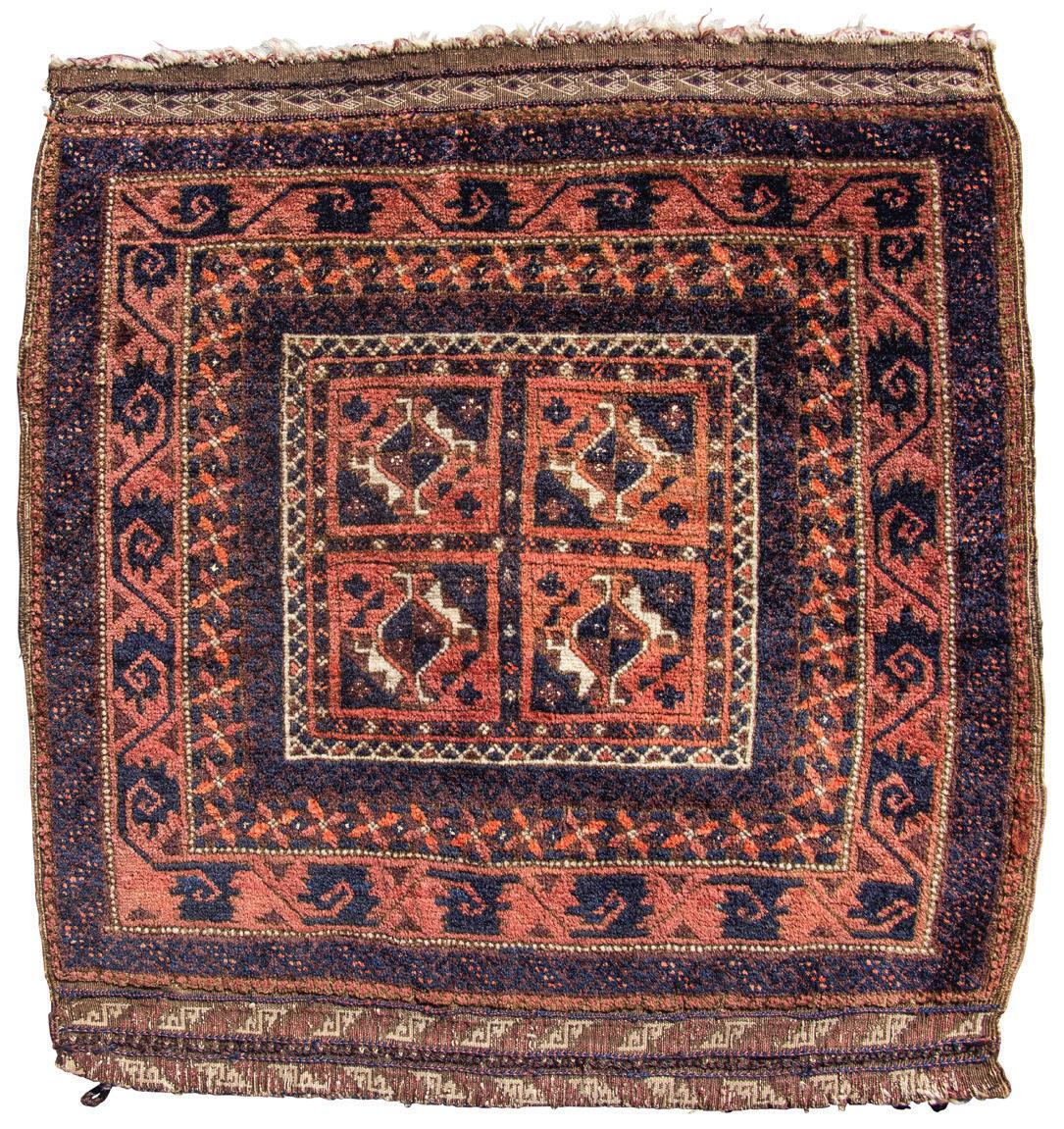
38. Baluch Balisht, Southeast Persia. A balisht from Southeast Persia which, according to Jerry Anderson (HALI 76), are made in pairs for the wedding ceremony/ dowry and used by the newly-wed couple. The division of the field with a horizontal line featuring a barber pole design is very rarely, if ever seen. One theory regarding the division of the field in this manner suggests it is done with intention and meaning. In the absence of fully articulated and/or documented significance, any attempt to extrapolate something meaningful from this is, at best, fanciful. The horizontal orientation of the confronting S elements of the primary border is an older feature, as is the absence of design elements drawn in white. All colors are very saturated. 17” x 28” (42cm x 70cm) Asymmetric knot open left, 7h x 10v = 70 kpsi. Colors (6): red, green, aubergine, blue, natural ivory/white, natural brown.
Published: Plate 38. Cole, T. FROM THE LAND OF THE SUN. THE RICHARD STEWART COLLECTION OF BALUCH RUGS, BAGS, AND TRAPPINGS. 2022. $400-600 Start: $200
39. Baluch Balisht, Southeast Persia. Though the field design is hardly unique – the ashik pattern may well be the most commonly seen – the colors are extremely unusual. The blue/blue-green dye appears without restraint and, as it is situated adjacent to a deeply saturated purple dye, the aesthetic is very different than normally seen. The absence of any black or olive outlining, too, is unusual; the vast majority of weavers throughout Persia, Central Asia and beyond will often separate one pattern (or color) from another. From the perspective of color, it is an unusual example while the larger scale reciprocal trefoil primary (?) border is a striking feature. The zig-zag minor border on a red ground flanking the field, too, is not common. 18” x 36” (45cm x 90cm) Asymmetric knot open left, 8h x 10v = 80 kpsi. Colors (4): red, blue/blue-green, purple, natural ivory/white. Published: Plate 39. Cole, T. FROM THE LAND OF THE SUN. THE RICHARD STEWART COLLECTION OF BALUCH RUGS, BAGS, AND TRAPPINGS. 2022. $400-600 Start: $200
40. Baluch Balisht, Southeast Persia. The colorful aesthetic seen in Baluch weavings from Southeast Persia (Seistan region) is very distinctive; both the range of colors and specific shades are not used elsewhere within the larger region in which the so-called Baluch weaving groups live. The maroon/red shade seen here is uncommon, even among the many examples of similar provenance as are stepped polygon motifs in the field, too. The absence of much white may be an earlier feature, possibly accounting for the drawing seen in the primary borders – S motifs – angling into towards the field from either side, that if extended, would intersect one another rather than form parallel lines. 17” x 35” (42cm x 87cm) Asymmetric knot open left, 8h x 10v = 80 kpsi. Colors (8): maroon/red, purple/brown, orange, blue/green, natural brown, natural ivory/white, 2 blues (dark, medium). Published: Plate 40. Cole, T. FROM THE LAND OF THE SUN. THE RICHARD STEWART COLLECTION OF BALUCH RUGS, BAGS, AND TRAPPINGS. 2022.

$400-600 Start: $200

41. Baluch Balisht, Southeast Persia. Though the orientation of the borders suggests age, it is not the oldest of the type, given the number of secondary borders as well as the appearance of white wool prominent in six places. Instead of the usual ashik motifs, the clear green latch hook medallions outlined in red are placed on a very dark blue ground. The wool is good, and the colors unfailingly saturated. 18” x 33” (45cm x 82cm) Asymmetric knot open left, 9h x 11v = 99 kpsi. Colors
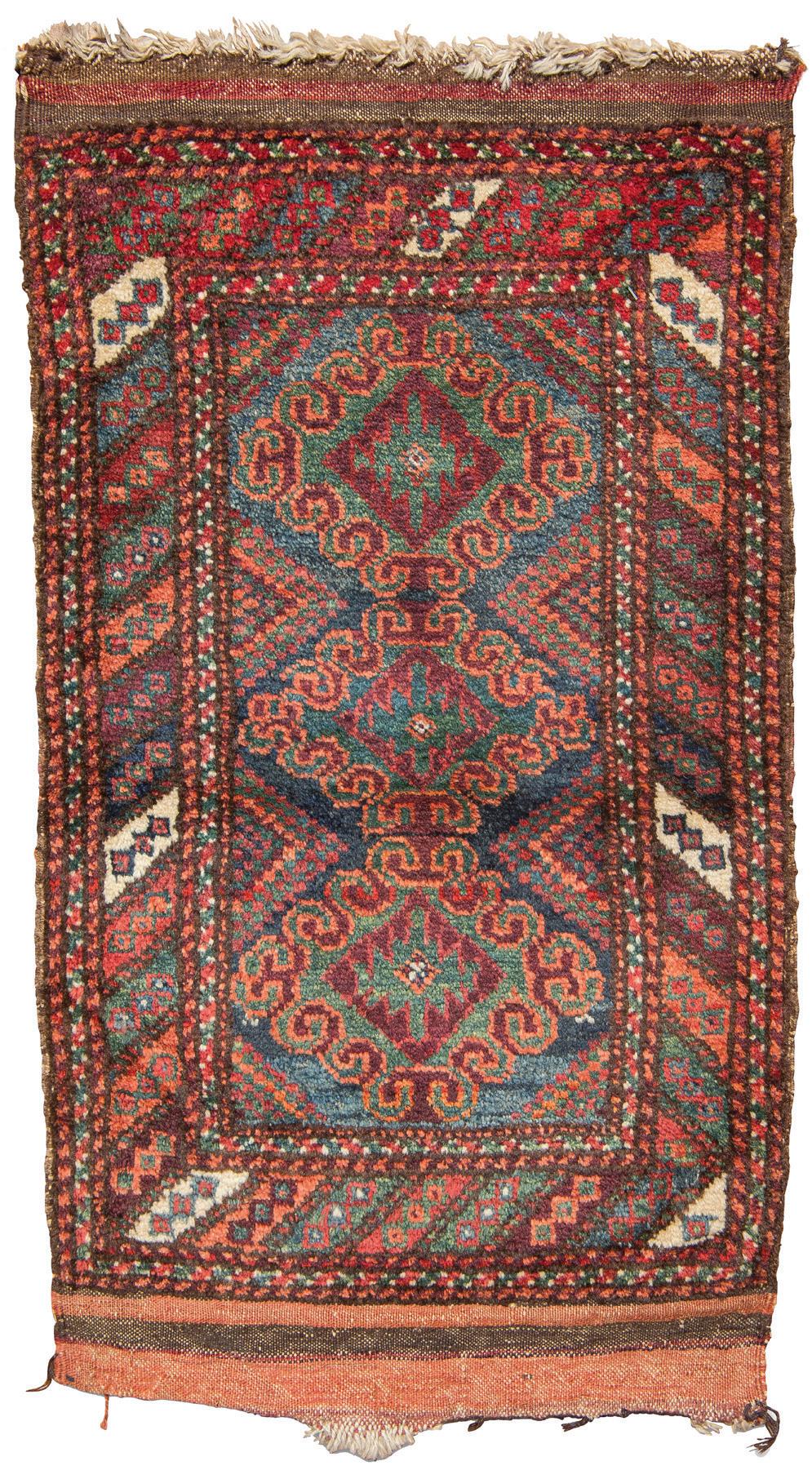

(8): red, dark plum red, dark blue, green, aubergine, natural dark brown, bleached ivory/white, dark blue/black. Published: Plate 41. Cole, T. FROM THE LAND OF THE SUN. THE RICHARD STEWART COLLECTION OF BALUCH RUGS, BAGS, AND TRAPPINGS. 2022.
$400-600 Start: $200
42. Baluch Balisht, Southeast Persia. Though the field pattern is hardly unknown, it is not common either. Featuring a beautiful combination of blue shades with blue/green and green, many find the palette very attractive. Balisht of this design type are often found with similar colors. Possibly woven by a small group committed to this type of palette, no one has really explored this possibility. While the unbleached natural ivory wool is prominently featured, suggesting it may not be quite as old as others, the border is well drawn, with the motifs within diagonal lines, which if extended, would cross one another rather than running parallel. 18” x 33” (45cm x 82cm) Asymmetric knot open left, 9h x 9v = 81 kpsi. Colors (8): 2 blues (medium, light), blue/ green, green, purple, brown-red, orange, natural ivory/white. Published: Plate 42. Cole, T. FROM THE LAND OF THE SUN. THE RICHARD STEWART COLLECTION OF BALUCH RUGS, BAGS, AND TRAPPINGS. 2022. $400-600 Start: $200
43. Baluch Balisht, Southeast Persia. A coarsely woven balisht with atypically rustic appearance that some might associate with age. The light grey/ blue ground color in the lower part of the field is uncommon. It may be a light blue dye applied onto grey wool. The remaining colors are all quite saturated, suggesting the dyer was experienced 15” x 26” (37cm x 65cm) Asymmetric knot open left, 7h x 9v = 63 kpsi. Colors (7): red, salmon red/ orange, blue, plum red, light grey/blue, natural dark brown, bleached ivory/white. Published: Plate 43. Cole, T. FROM THE LAND OF THE SUN. THE RICHARD STEWART COLLECTION OF BALUCH RUGS, BAGS, AND TRAPPINGS. 2022. $400-600 Start: $200
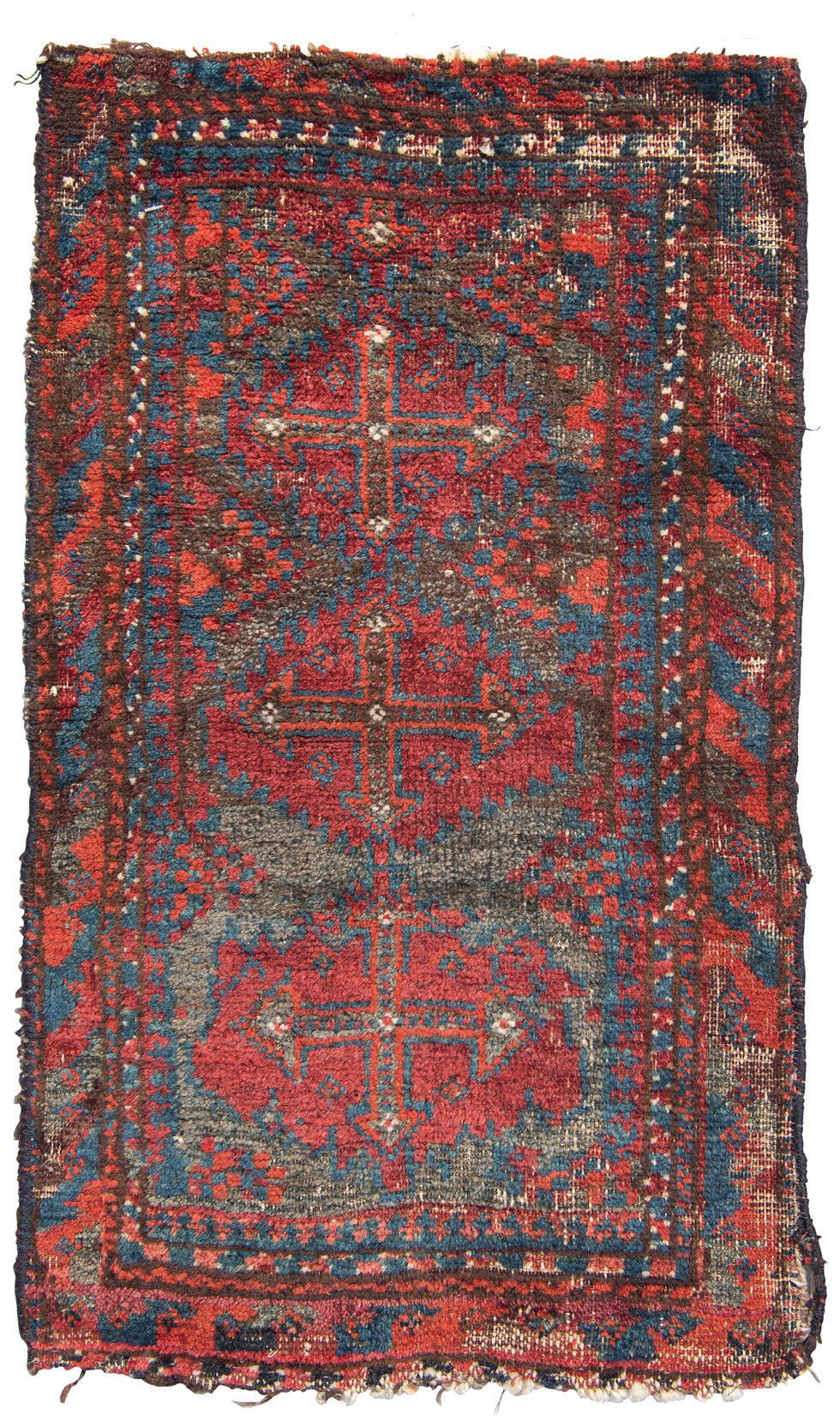
44. Baluch Balisht, Southeast Persia. A fully saturated palette with the minimal use of white wool suggesting it may be older than other examples from Seistan. With four, rather than the usual three, ashiks arranged on a dazzlingly saturated indigo blue field accented by green used liberally throughout, the diagonal orientation of the primary border element contributes to the visual appeal. 17” x 32” (42cm x 80cm) Asymmetric knot open left, 8h x 9v = 72 kpsi. Colors (6): brown-purple/red, blue, green, dark aubergine, natural black/brown, bleached ivory/white. Published: Plate 44. Cole, T. FROM THE LAND OF THE SUN. THE RICHARD STEWART COLLECTION OF BALUCH RUGS, BAGS, AND TRAPPINGS. 2022.
$400-600 Start: $200
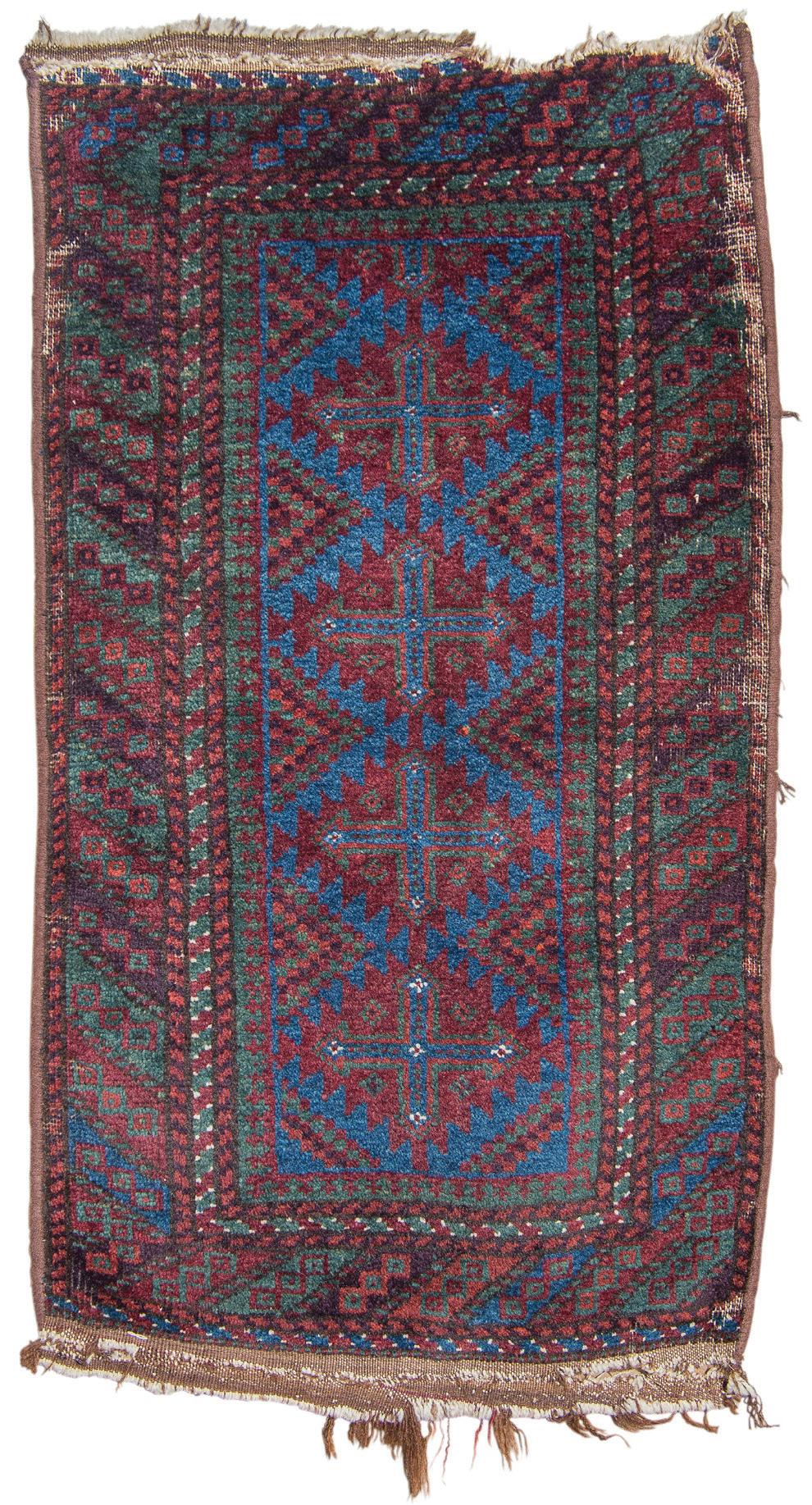
45. Baluch Balisht, Southeast Persia. The brilliant indigo blue ground color is quite different, with an electric, glowing appearance accentuated by the fine silky wool on to which it has been applied. The border system may very well indicate greater age than other analogous examples, with the diagonal designs angled into or towards the field and, if extended, would cross one another rather than remain parallel. The sparkling lustrous wool, saturated colors and relatively spacious handling of a design that tends to be crowded suggest it may be older than others of a similar design. 20” x 41” (50cm x 102cm) Asymmetric knot open left, 7h x 9v = 63 kpsi. Colors (8): red, red/orange, light purplish red, blue, green, purple, corrosive brown, natural ivory/ white. Published: Plate 45. Cole, T. FROM THE LAND OF THE SUN. THE RICHARD STEWART COLLECTION OF BALUCH RUGS, BAGS, AND TRAPPINGS. 2022. $400-600 Start: $200
46. Baluch Balisht, Southeast Persia. A colorful balisht featuring the palette of very best pile weavings from Southeast Persia. The overall boteh pattern is a classic format and oft repeated but seldom with the array of colors seen here. Apparently an older example, the primary border confirms this thought, with the “S” forms of that border angling into or towards the field which, if extended, the lines of these opposite borders would again cross one another rather than remain parallel. Too often discounted in the marketplace due to the diminutive size of the boteh motifs (and somewhat crowded appearance), this is an older example with a relatively fine weave and a diverse, contrasted and saturated palette. 20” x 39” (50cm x 97cm) Asymmetric knot open left, 7h x 10v = 70 kpsi. Colors (9): dark blue, red, orange/red, blue green, medium blue, natural medium olive/ brown, natural dark brown, dark aubergine, bleached ivory/ white. Published: Plate 46. Cole, T. FROM THE LAND OF THE SUN. THE RICHARD STEWART COLLECTION OF BALUCH RUGS, BAGS, AND TRAPPINGS. 2022. $400-600 Start: $200

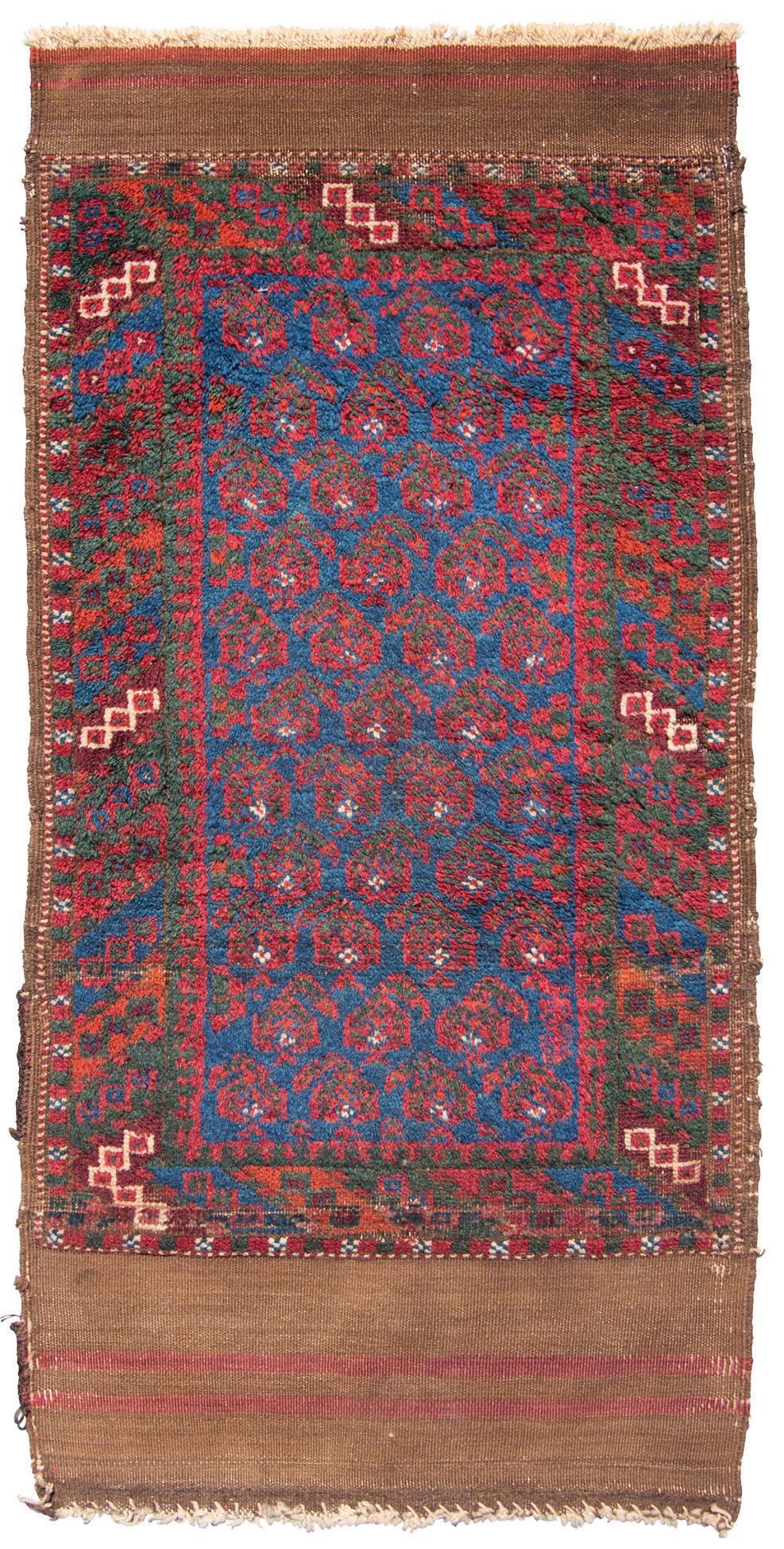
47. Baluch Balisht, Southeast Persia. The atypical field pattern is quite rare, featuring an orderly if not exactly drawn repeating design greatly enhanced by the smaller tertiary motifs floating on the camel wool ground. The dyes used are evenly saturated; the dyer appears to have been quite accomplished. 19” x 35” (47cm x 87cm) Asymmetric knot open left, 9h x 11v = 99 kpsi. Colors (7): purple-brown, rust red, green, blue, black (corrosive), natural ivory/white, camel wool. Published: Plate 47. Cole, T. FROM THE LAND OF THE SUN. THE RICHARD STEWART COLLECTION OF BALUCH RUGS, BAGS, AND TRAPPINGS. 2022. $400-600 Start: $200

48. Baluch Balisht, Southwest Afghanistan. Probably from Afghanistan, rather than Southeast Persia, a supposition based on the large secondary border with a white ground – a pattern seen much more often and possibly confined to the vocabulary of Afghan based weavers. The palette is saturated and consistent with a Seistan origin, as well as to neighboring tribes in Afghanistan. The latch hook medallion motifs of the field are more often seen with a camel brown ground color, rather than red, possibly indicating an Afghan origin. 20” x 34” (50cm x 85cm) Asymmetric knot open left, 7h x 8v = 56 kpsi. Colors (10): red, dark blue/green, dark blue, green, corrosive dark aubergine, medium aubergine (no corrosion), red/orange, medium blue, bleached ivory/white, natural brown. Published: Plate 49. Cole, T. FROM THE LAND OF THE SUN. THE RICHARD STEWART COLLECTION OF BALUCH RUGS, BAGS, AND TRAPPINGS. 2022. $400-600 Start: $200
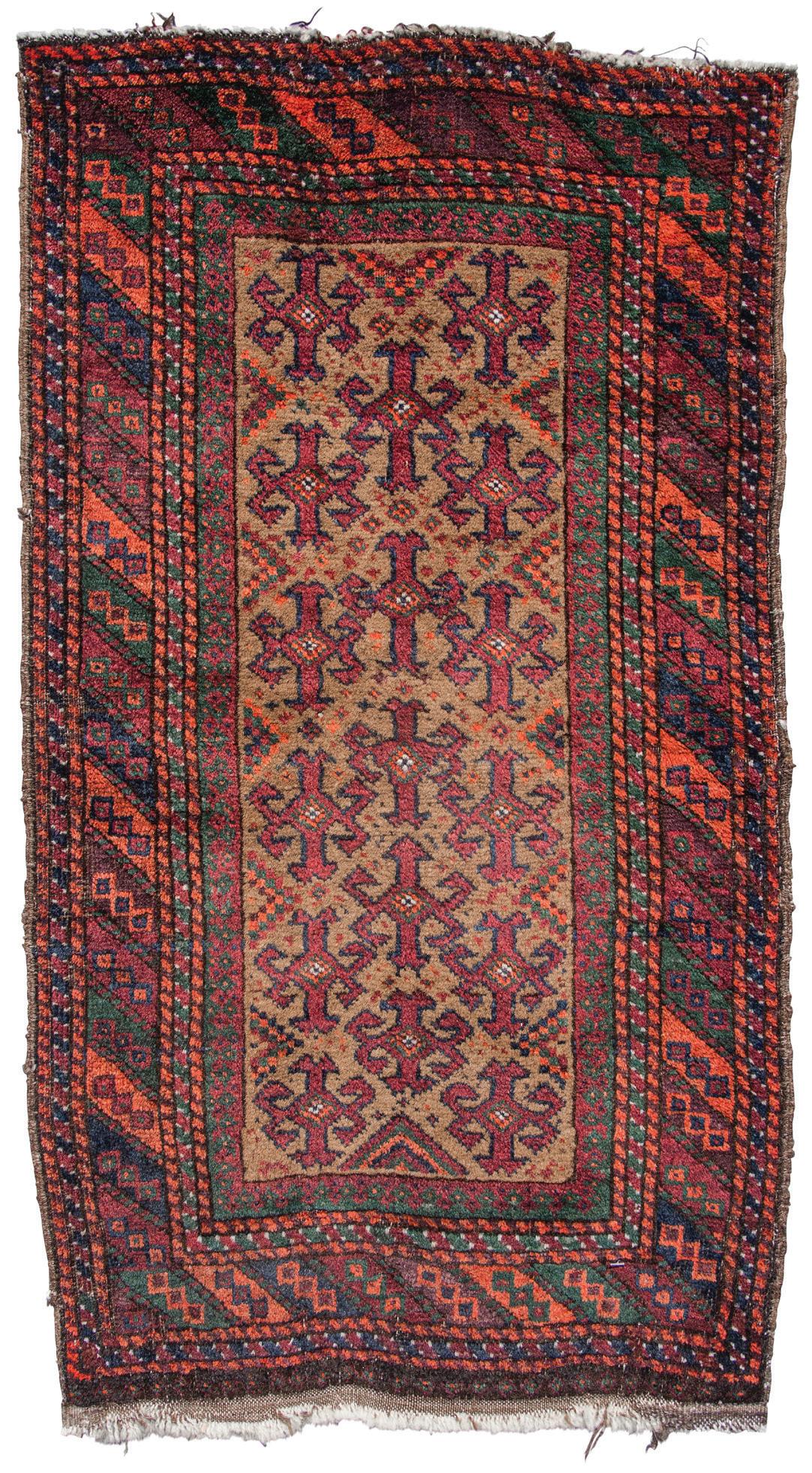
49. Baluch Balisht, Southeast Persia. The spacious handling of the field design is quite attractive and very different from most balisht woven by the sundry tribes of the region. The camel-colored ground provides a lovely contrast for the purple latch hook medallions. The kilim ends include patterning not often seen in examples from southeast Persia. 17” x 36” (42cm x 90cm) Asymmetric knot open left, 7h x 10v = 70 kpsi. Colors (7): medium red, purple/red, blue/green, blue, camel brown, natural medium brown, natural ivory/white. Published: Plate 48. Cole, T. FROM THE LAND OF THE SUN. THE RICHARD STEWART COLLECTION OF BALUCH RUGS, BAGS, AND TRAPPINGS. 2022. $400-600 Start: $200

50. Baluch Balisht, Southeast Persia. An interesting variation of the classic ashik pattern commonly seen in balisht from Southeast Persia. The colorful design in the center of each ashik may be a characteristic of a specific weaving group. The ground color is not camel wool, but dyed. The primary border is atypical but known, possibly suggesting a specific weaving group or area from which the weavers come. 19” x 34” (47cm x 85cm) Asymmetric knot open left, 9h x 9v = 81 kpsi. Colors (6): purple-brown, blue/green, blue, red, orange, bleached ivory/white, natural brown. Published: Plate 50. Cole, T. FROM THE LAND OF THE SUN. THE RICHARD STEWART COLLECTION OF BALUCH RUGS, BAGS, AND TRAPPINGS. 2022. $400-600 Start: $200
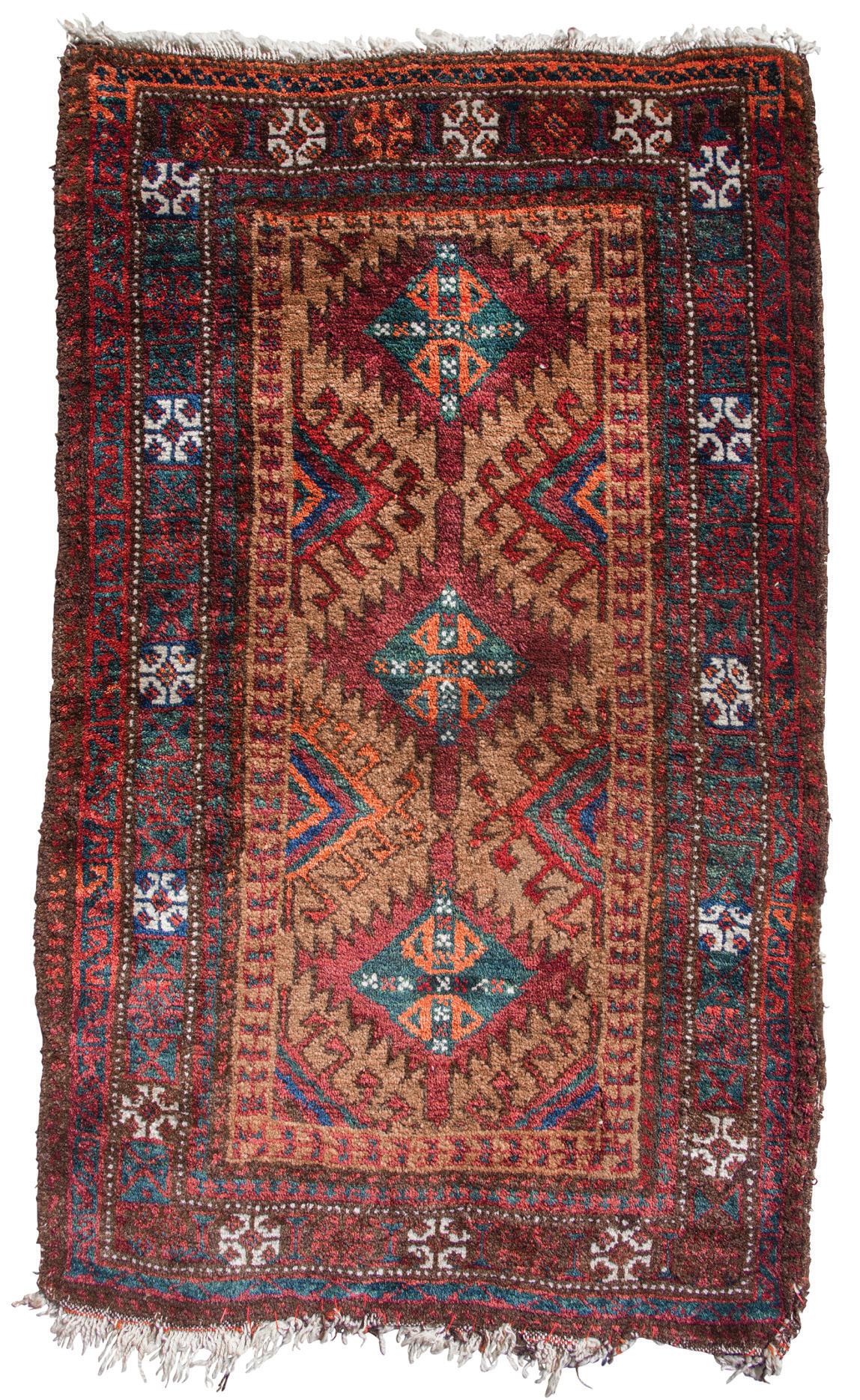
51. Baluch Balisht, Southeast Persia. An unusual medallion, possibly either related to or merely a provincial copy of the Turkmen gorbaghe gol. Such medallions are rarely (if ever) seen in rugs or bags from southeast Persia. The stepped outline framing the medallion at the bottom of the field is a nice touch, (intentional or not) imparting a sense of movement to the entire composition. 19” x 35” (47cm x 90cm) Asymmetric knot open left. 9h x 9v = 81 kpsi. Colors (7): reddish purple, golden brown, blue/green, dark blue, dark green, reddish orange, bleached ivory/white. Published: Plate 51. Cole, T. FROM THE LAND OF THE SUN. THE RICHARD STEWART COLLECTION OF BALUCH RUGS, BAGS, AND TRAPPINGS. 2022. $400-600 Start: $200
52. Baluch Balisht, Northeast Persia. There is a group of Baluch rugs identified in the Afghan marketplaces as salar khani, featuring a Turkmen inspired gol (medallion). Most are later than the cognoscenti choose to collect, and valued among dealers in situ rather than Western collectors. Upon close examination while counting colors, it became apparent this example is not one of those standard examples. The shape of the dark salmon red pattern in the center of the three medallions dominating the field is a motif found in Turkmen gols (medallions) specifically those of the Salor, perhaps accounting for the marketplace nomenclature – salar. The motif is reminiscent of one seen in Anatolian Holbein rugs dating to the 16th century. Though obviously and clearly Baluch, the palette is atypical for the standard fare from northeast Persia. The dominant ground color – purple – is rarely seen in such profusion, as the weaver eschewed the more familiar indigo blue dye. Damaged as it is with even wear, one might guess it is older than many other examples based on design and color. Whatever use and abuse it received, it was saved, finding its way to the marketplace, probably a cherished heirloom preserved for posterity as well as our enjoyment and speculation. 19” x 37” (47cm x 93cm) Asymmetric open left, 8h x 10v = 80 kpsi. Colors (9): dark salmon red, purple, gold, blue, 2 blue/green, dark salmon (corrosive), natural black, natural ivory/white, natural tan/light brown.

Published: Plate 52. Cole, T. FROM THE LAND OF THE SUN. THE RICHARD STEWART COLLECTION OF BALUCH RUGS, BAGS, AND TRAPPINGS. 2022. $400-600 Start: $200

53. Baluch Balisht, Afghanistan. Probably from Afghanistan, the field design is quite unusual with three “memling-gols” spanning the length of the field. The camel ground color is a dye rather than camel wool, as is often the case. The border system, with the primary reciprocal trefoil or rams horn motif is one seen only in those Baluch weavings from Afghanistan, rather than neighboring northeast or southeast Persia. The minor border outlined in natural ivory wool is thought to date these rugs, apparently to early 20th century and never (or rarely?) earlier. The wide multi-colored chevron minor border framing the field is atypical. The weave is unusually fine, finer than most would believe upon viewing it from a distance, possibly indicating it was considered special by the weaver and her family, thus well preserved for posterity. 20” x 33” (50cm x 82cm) Asymmetric knot open left, 10h x 13v = 130 kpsi. Colors (8): medium camel brown, purple, red, brown/red, 2 blue (dark, medium), corrosive dark brown/black, natural ivory/white. Published: Plate 53. Cole, T. FROM THE LAND OF THE SUN. THE RICHARD STEWART COLLECTION OF BALUCH RUGS, BAGS, AND TRAPPINGS. 2022. $400-600 Start: $200
54. Baluch Balisht, Northeast Persia. Though not as finely woven as one might expect the palette and design both suggest a Khorassan provenance. The primary border is unusual and rarely seen. 20” x 36” (50cm x 90cm) Asymmetric knot open left, 8.5h x 10v = 85 kpsi. Colors (6): red, dark blue, aubergine, purple/ brown, natural black, natural ivory/white.

Published: Plate 54. Cole, T. FROM THE LAND OF THE SUN. THE RICHARD STEWART COLLECTION OF BALUCH RUGS, BAGS, AND TRAPPINGS. 2022. $400-600 Start: $200
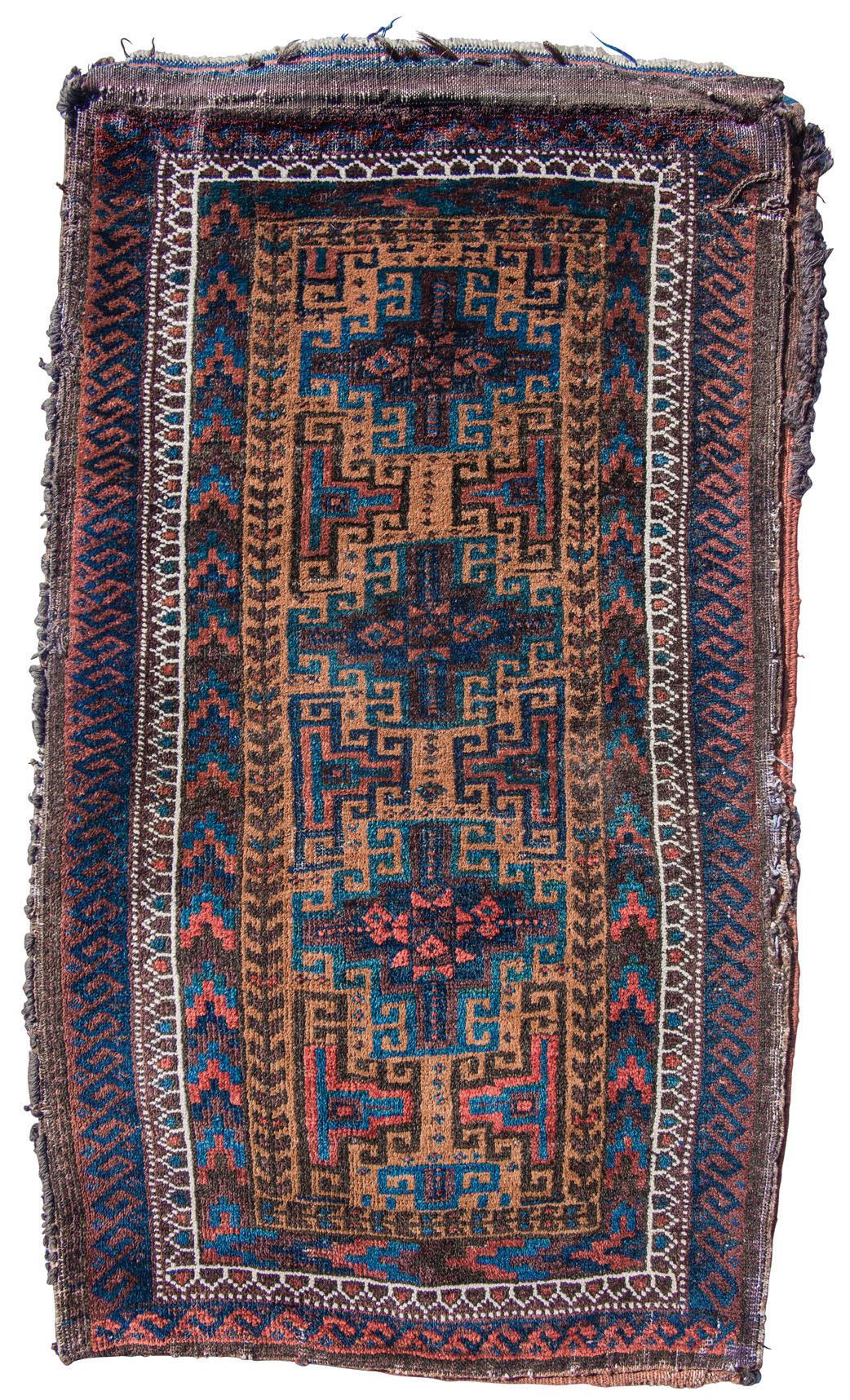
55. Baluch Balisht, Afghanistan. Normally, balisht distinguished by this field patterning and colors are thought to have been woven by the Baluch in the Seistan region. But the minor border (in white) immediately framing the field is one rarely if ever encountered in weavings from that area and seems to be one more closely associated with the “Baluch” groups from neighboring Afghanistan. The salmon red hue, too, is one more common to that area as well, rather than Southeast Persia where the red tones tend to be a darker shade. The reciprocal trefoil outer border surrounded by a barber pole minor on either side also appears to be an Afghan trait. The animals at the either end of the field are a nice touch and the apparent unscripted drawing is emphasized by the varying size of the triangular motifs jutting into the field from either side. 18” x 46” (45cm x 115cm) Asymmetric open left, 8h x 13v =104 kpsi. Colors (7): salmon red, dark blue, medium blue, light purple/brown (slightly corrosive), camel, natural black, natural ivory/white. Published: Plate 55. Cole, T. FROM THE LAND OF THE SUN. THE RICHARD STEWART COLLECTION OF BALUCH RUGS, BAGS, AND TRAPPINGS. 2022.
$400-600 Start: $200
56. Baluch Balisht, Northeast Persia / Northwest Afghanistan. A rare but not unknown design seen in used as a field design in both prayer rugs as well as balisht. The provenance is uncertain though it may very well have been woven in the border areas, given the absence of classic shades of red common to most Khorassan examples. The plum red shades may be an attribute of weavings from Afghanistan but the design and orderly manner in whwwich it has been put together seems to reflect a Khorassan approach. The motifs arranged in two columns may represent a highly evolved type, drawn with the practiced and precise hand of an accomplished weaver 15” x 35” (38cm x 88cm) Asymmetric knot open left, 10h x10v = 100 kpsi. Colors (9): camel wool, 2 plum red (dark, medium), dark aubergine (slightly corrosive), blue/green (corrosive), natural medium brown, corrosive black, corrosive blue/black (possibly over dyed), natural ivory/white. Published: Plate 56. Cole, T. FROM THE LAND OF THE SUN. THE RICHARD STEWART COLLECTION OF BALUCH RUGS, BAGS, AND TRAPPINGS. 2022. $400-600 Start: $200


57. Baluch Balisht, Northeast Persia / Northwest Afghanistan border area. Upon first viewing this balisht, one might expect it to share the usual structural features of most Baluch rugs – an asymmetric knot open to the left but it does not. Coarsely woven with a symmetric knot, one must wonder if it is an atypical example of the socalled “Bahlul” groups or merely an aberrant example woven by another group for domestic use. The outer minor border is exceptionally nice featuring the classic juxtaposition of a medium/light blue with a clear aubergine/purple dye. 15” x 31” (38cm x 77cm) Symmetric knot, 6h x 11v = 66 kpsi. Colors (7): 3 blues (dark, medium light), red, brownish aubergine, camel, natural ivory/white. Published: Plate 57. Cole, T. FROM THE LAND OF THE SUN. THE RICHARD STEWART COLLECTION OF BALUCH RUGS, BAGS, AND TRAPPINGS. 2022. $400-600 Start: $200

58. Baluch Balisht, Northeast Persia. Given the design, one might immediately assume it to be one of the oldest examples in the collection, representing a rare design type. The large flower heads of the only extant border system is extremely unusual, accentuated by corrosion with the colored petals of the flower standing in start relief. The field drawing of what is more often seen as a border in rugs from the Torbat-i-Heydari region is extremely well drawn, featuring a bird like (or raptor) image in the very center, above the flower head. Few balisht of this group remain extant, and the slightly depressed warp with a somewhat heavier handle (not an early feature) suggests the same origin as rugs featuring the mina khani pattern attributed to the Torbat area. In spite of the slightly depressed warp, the weave is exceptionally fine. Some may feel this structural feature dates it to a later part of the 19th century, and the colors confirm that feeling though the drawing is reminiscent of an earlier period. 14” x 28” (35cm x 70cm) Asymmetric knot open left, 13h x 15v = 195 kpsi. Colors (13): red, dark blue, aubergine, corrosive brown, gold/yellow, red/orange (tip faded), light red (slightly tip faded), red/purple (faded), grey (faded from purple, possibly fuchsine), bleached ivory/white, red/purple (slight corrosion), white silk, red/orange silk. Published: Plate 58. Cole, T. FROM THE LAND OF THE SUN. THE RICHARD STEWART COLLECTION OF BALUCH RUGS, BAGS, AND TRAPPINGS. 2022. $500-1000 Start: $250

59. Baluch Balisht, Northeast Persia. The so-called mina khani pattern is a popular one in the marketplace among collectors and dealers, perhaps due to its association with or origin from court carpets. The field design mimics the borders often seen in those rugs from the Torbati-Heydari region of northeast Persia. The field pattern in conjunction with the slightly depressed warps suggests it was woven in this area, though the distinctive goat hair wrapped selvedges are completely missing. The nearly abstract version of that classic border design placed in the field might indicate to many it is older than many we see, but the tip faded color red color may be derived from a synthetic dye. This group of balisht is rare, but all seem to include a questionable dye, possibly indicating a later date and workshop production. 14” x 30” (35cm x 75cm) Asymmetric knot open left, 12h x 11v = 132 kpsi. Colors (8): red, light red, dark brown (slightly corrosive), natural light brown/ tan, corrosive olive, yellow, tip faded red, camel wool. Published: Plate 59. Cole, T. FROM THE LAND OF THE SUN. THE RICHARD STEWART COLLECTION OF BALUCH RUGS, BAGS, AND TRAPPINGS. 2022. $500-1000 Start: $250
60. Baluch Balisht, Northwest Afghanistan. Possibly a very old example of a type that may have been made in northwest Afghanistan, adjacent to Turkmenistan. The palette includes a clear aubergine/purple hue as the ground color of the field – an unusual feature. The “gold” color in the medallions is camel wool with an obviously different appearance to the sheep wool used throughout. The minor border with a white ground framing the entire composition is one more closely associated with Afghan weavings. Analogous balisht (or rugs) have not been published suggesting it may very well be older than similar examples we may have seen, either in the marketplace or literature. 20” x 39” (50cm x 98cm) Asymmetric knot open left, 7.5h x 7v = 52.5 kpsi. Colors (11): aubergine, camel wool, red, 3 blue (dark, medium, light), natural dark brown, bleached ivory/white, light salmon orange/red, natural grey, natural ivory/white (flatwoven end). Published: Plate 60. Cole, T. FROM THE LAND OF THE SUN. THE RICHARD STEWART COLLECTION OF BALUCH RUGS, BAGS, AND TRAPPINGS. 2022. $500-1000 Start: $250

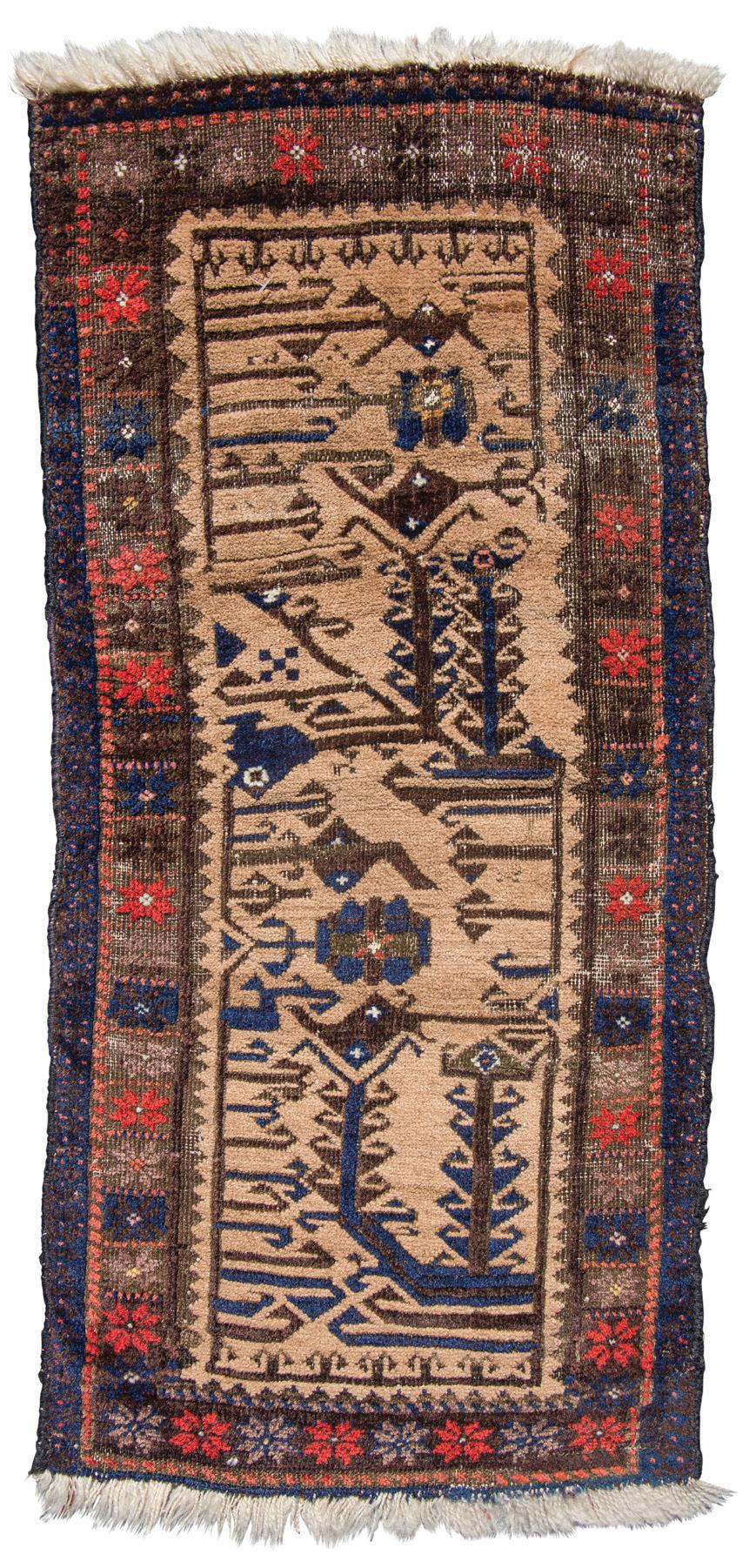
61. Baluch Balisht, Afghanistan / Northeast Persia. An unusual composition, other rugs or smaller bags of this design type must be very rare – a type that I cannot recall seeing in the past. Given the palette and the border patterns, it may be from western Afghanistan, though one might be tempted to view the tree pattern in the field as a more classic design type familiar to Khorassan based weavers, appropriated from the classic cypress tree design from northwest Persia. The reciprocal trefoil minor (?) border featuring an iridescent blue hue adjacent to a deeply saturated brownish purple/red appears more often among weavings possibly attributable to the Baluch of western Afghanistan but very few Afghan weavers were well acquainted with the cypress tree motif.
16” x 37” (40cm x 92cm) Asymmetric knot open left, 7.5h x 9v = 67.5 kpsi. Colors (6): light red, blue, corrosive brown, brownish purple/red, corrosive purple, camel, natural ivory/white (flatwoven ends). Published: Plate 61. Cole, T. FROM THE LAND OF THE SUN. THE RICHARD STEWART COLLECTION OF BALUCH RUGS, BAGS, AND TRAPPINGS. 2022. $500-1000 Start: $250
62. Baluch Balisht, Northeast Persia / Afghanistan. A balisht complete with the flatwoven back intact (pictured). The less than saturated palette may suggest an Afghan provenance as do the four compartmented design elements in the field. The outer minor border of boldly drawn reciprocal trefoil devices is more often seen in Afghan work, but the finely woven back is atypical for that region. Again, the primary border, often associated with Khorassan examples, has been appropriated from the design pool of the neighboring Turkmen weaving groups. 20” x 37” (50cm x 92cm) Asymmetric knot open left, 8h x 13v = 104 kpsi. Colors (6): camel wool, salmon red, light red/brown, dark blue, natural brown, natural ivory/white. Published: Plate 62. Cole, T. FROM THE LAND OF THE SUN. THE RICHARD STEWART COLLECTION OF BALUCH RUGS, BAGS, AND TRAPPINGS. 2022. $500-1000 Start: $250



63. Baluch Balisht, Southeast Persia. The unusual palette featuring more light blue than normally seen may suggest a southeast Persian attribution. The minor border in white is atypical. A clearly defined design of unusually generous proportions finished with a simple flatwoven end, it is a particularly pleasing example of the very common tree of life pattern. 20”; x 40” (50cm x 100cm) Asymmetric knot open left, 7.5h x 8v = 60 kpsi. Colors (8): deep salmon red, light blue, aubergine, deep camel brown/yellow, slightly corrosive black, bleached ivory/white, light blue/green, light salmon red. Published: Plate 63. Cole, T. FROM THE LAND OF THE SUN. THE RICHARD STEWART COLLECTION OF BALUCH RUGS, BAGS, AND TRAPPINGS. 2022. $400-600 Start: $200

64. Baluch Balisht, Northeast Persia. A formal and finely woven balisht from northeast Persia. The fine weave, lustrous wool and glowing indigo blue dyes are the obvious “hooks”, as the design is not particularly unusual though quite pleasing nevertheless. Given it has a knot count exceeding that of most bags or balisht from the area, it was undoubtedly treasured by its owners and may have been made for the sole purpose of domestic use rather than the general marketplace. 22” x 35” (55cm x 88cm) Asymmetric knot open left, 11h x 12v = 132 kpsi. Colors (5): red, blue, corrosive brown, natural black, natural ivory/white.
Published: Plate 64. Cole, T. FROM THE LAND OF THE SUN. THE RICHARD STEWART COLLECTION OF BALUCH RUGS, BAGS, AND TRAPPINGS. 2022. $400-600 Start: $200
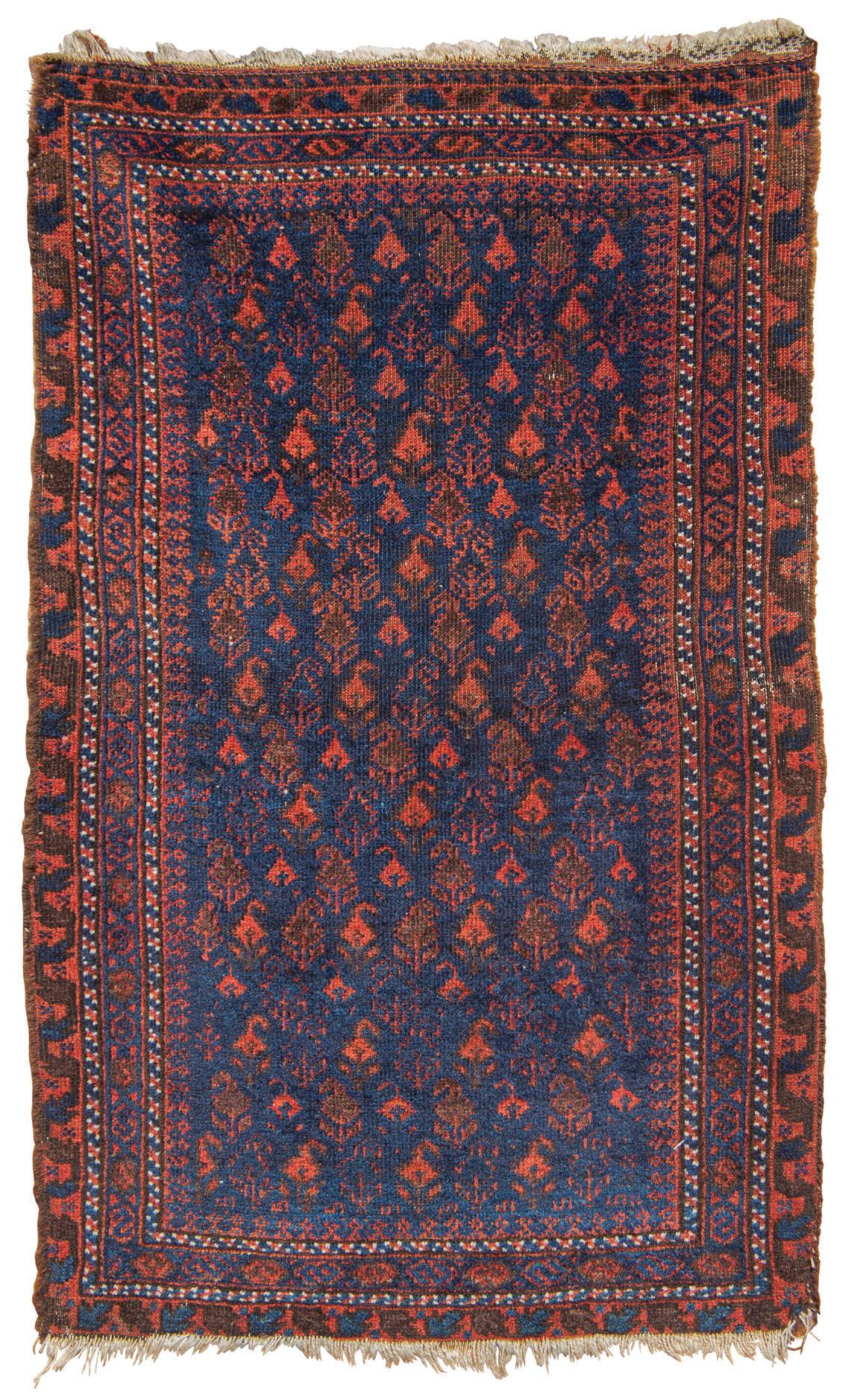
65. Baluch Balisht, Northeast Persia / Northwest Afghanistan. Possibly a Taimuri tribal weaving, probably from northeast Persia or northwest Afghanistan, it is a classic design type and one favored by collectors with good reason! If the field pattern is the so-called tree of life honoring ancestors with hopes for renewal and new-born children, it is not surprising it is regarded as a prestigious example. A carefully drafted composition, the weaver unerringly incorporated all aspects of a classic, well known field design framed by a series of borders – all of cultural significance to which we can hardly claim intimate knowledge. It seems wider than most balisht, suggesting it could have been intended for use as a small mat. 25” x 31” (62cm x 78cm) Asymmetric knot open left, 9h x 12v = 108 kpsi. Colors (8): red, dark purple/red, 2 blues (dark, medium), orange/red, corrosive olive, natural dark brown, natural ivory/white.
Published: Plate 65. Cole, T. FROM THE LAND OF THE SUN. THE RICHARD STEWART COLLECTION OF BALUCH RUGS, BAGS, AND TRAPPINGS. 2022. $500-1000 Start: $250

66. Baluch Balisht, Northeast Persia / Northwest Afghanistan. Balisht of this type are relatively uncommon, as the blue ground classic Taimuri aesthetic is more familiar in mats or prayer rugs (and, of course, the main carpets) than these pillow covers. Though larger than those from southeast Persia, the intended function seems clear. The reciprocal trefoil / ram horns primary border is unusual, and the outer minor border, too, is not often encountered in Khorassan examples, suggesting an origin further east – perhaps Afghanistan. The extremely fine weave, though, is atypical and it remains uncertain where it may have been woven. 21” x 39” (53cm x 98cm) Asymmetric knot open left, 9h x 12v = 108 kpsi. Colors – dark blue, medium blue, corrosive red, corrosive light red (slight tip fade), corrosive olive, natural brown, natural ivory/white.
Published: Plate 66. Cole, T. FROM THE LAND OF THE SUN. THE RICHARD STEWART COLLECTION OF BALUCH RUGS, BAGS, AND TRAPPINGS. 2022. $500-1000 Start: $250

67. Baluch Balisht, Northeast Persia. An elegant, somewhat larger than usual balisht from Khorassan based weavers. Commonly attributed to the Taimuri, the fine execution of design – both the field motifs and border – distinguish it from lesser examples. The brilliant medium blue coloring the central tree element provides a startling contrast with the deeply saturated dark indigo blue field. 19” x 30” (48cm x 75cm) Asymmetric knot open left, 9h x 13v = 117 kpsi. Colors (8): dark blue, medium blue, brownish red, light red, aubergine, light brown (corrosive), natural grey, bleached white. Published: Plate 67. Cole, T. FROM THE LAND OF THE SUN. THE RICHARD STEWART COLLECTION OF BALUCH RUGS, BAGS, AND TRAPPINGS. 2022. $500-1000 Start: $250
68. Baluch Balisht, Northwest Afghanistan / Northeast Persia. The drawing with a ribbon like appearance design of the two larger borders is quite well done – an effective visual “hook” attractively framing the dark blue field featuring motifs in red. This, too, may have been woven in northwest Afghanistan, possibly indicated by the very simple, rather than elaborate, flatwoven ends. The flower in the center of the gols at either end of the field are well drawn while these ribbon-like borders may be the ultimate indicator of the Afghan provenance. 25” x 40” (63cm x 100cm) Asymmetric knot open left, 7h x 10v = 70 kpsi. Colors (5): medium brownish red, blue, corrosive dark olive, bleached ivory/white, natural brown.
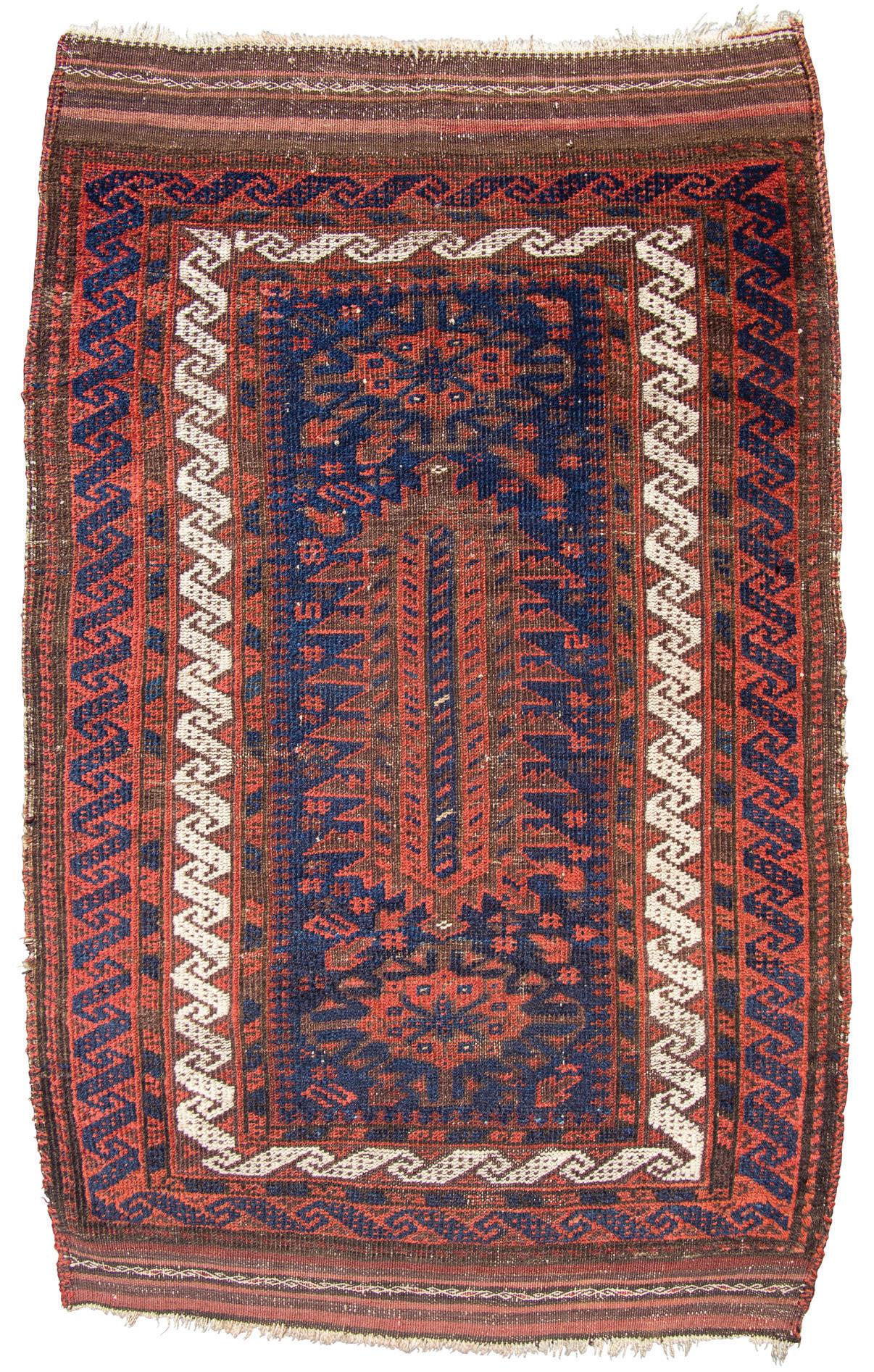
Published: Plate 68. Cole, T. FROM THE LAND OF THE SUN. THE RICHARD STEWART COLLECTION OF BALUCH RUGS, BAGS, AND TRAPPINGS. 2022. $500-1000 Start: $250
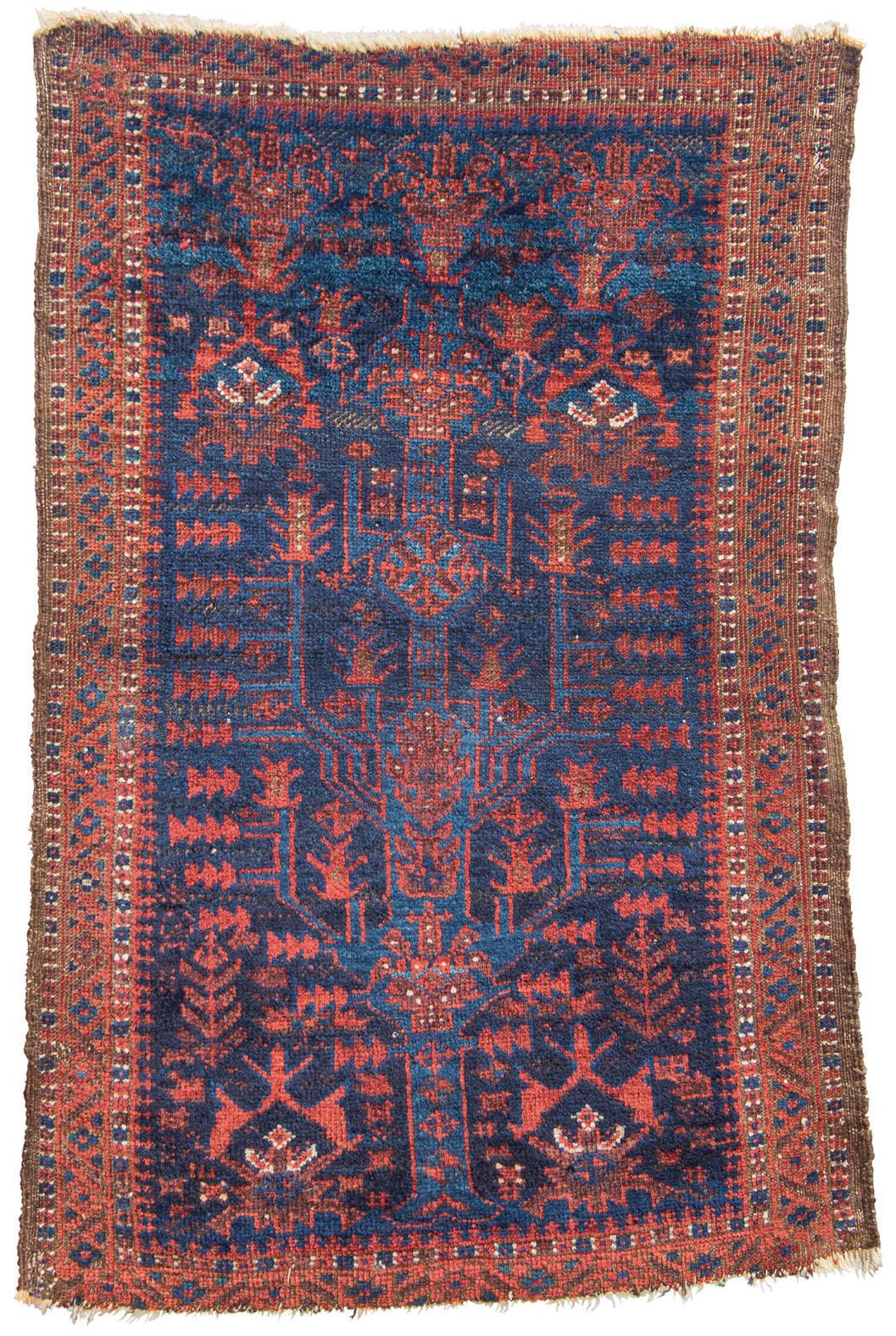
69. Baluch Balisht, Afghanistan / Northeast Persia. The palette and design type seem to suggest a relationship with more formal and finely drawn examples attributed by many to the Khorassan based weaving groups. But the three compartments in the field, and the less than saturated, somewhat muddy, red may indicate an Afghan provenance. The “trees” on either side of the field are those seen in blue ground main carpets attributable to Afghan based groups. The white ground secondary border, too, seems to be an Afghan feature. 21” x 38” (53cm x 95cm) Asymmetric knot open left, 11h x 11v = 121 kpsi. Colors (7): red (faded tips), light red/ brown, blue, yellow silk, faded purple silk, natural ivory/white, corrosive black. Published: Plate 69. Cole, T. FROM THE LAND OF THE SUN. THE RICHARD STEWART COLLECTION OF BALUCH RUGS, BAGS, AND TRAPPINGS. 2022. $500-1000 Start: $250
70. Baluch Balisht, Northeast Persia. Finely woven with detailed kilim ends intact, the handle is very supple, suggesting it maybe an older example from Khorassan. The innermost secondary border on the camel field is a nice touch while the ashik-like devices of the primary border, woven in salmon red, are classic, a known border pattern. 20” x 30” (50cm x 75cm) Asymmetric knot open left, 11h x 15v = 165 kpsi. Colors (6): salmon red, camel wool, dark blue, aubergine, corrosive black, bleached ivory/white.

Published: Plate 70. Cole, T. FROM THE LAND OF THE SUN. THE RICHARD STEWART COLLECTION OF BALUCH RUGS, BAGS, AND TRAPPINGS. 2022. $500-1000 Start: $250

71. Baluch Balisht, Northeast Persia. Initially, this appears to be “just another” so-called tree of life, camel ground balisht from northeast Persia, but with an array of colors. Though primarily a darker hue, they show well with proper light. The dark blue and blue/green are outstanding colors and the overall composition with a largescale design is well handled. The weave is unusually fine too, and it is complete with a dark aubergine plainweave back intact. 19” x 40” (48cm x 100cm) Asymmetric knot open left, 10h x 11v = 110 kpsi. Colors (7): plum red/brown, dark blue, blue/green, dark aubergine, corrosive black/brown, natural ivory/white, natural camel wool. Published: Plate 71. Cole, T. FROM THE LAND OF THE SUN. THE RICHARD STEWART COLLECTION OF BALUCH RUGS, BAGS, AND TRAPPINGS. 2022. $500-1000 Start: $250
72. Baluch Balisht, Northeast Persia. With dark and foreboding presence, a close examination of this balisht unexpectedly reveals six different dyes in addition to natural ivory/white wool. A cursory glance might leave the impression it is a later example with typically few contrasting colors. But the fine weave, attention to detail, specifically the reciprocal ram’s horn outer border and number of colors suggests it may very well be older. The fine knot count surpasses that seen in others considered more classic examples from the Khorassan region. 20” x 35” (50cm x 88cm) Asymmetric knot open left, 10h x 13v = 130 kpsi. Colors (7): dark purple/maroon, light salmon red, dark blue, purple over dye on brown wool, corrosive olive, natural dark brown, natural ivory/white. Published: Plate 72. Cole, T. FROM THE LAND OF THE SUN. THE RICHARD STEWART COLLECTION OF BALUCH RUGS, BAGS, AND TRAPPINGS. 2022. $500-1000 Start: $250
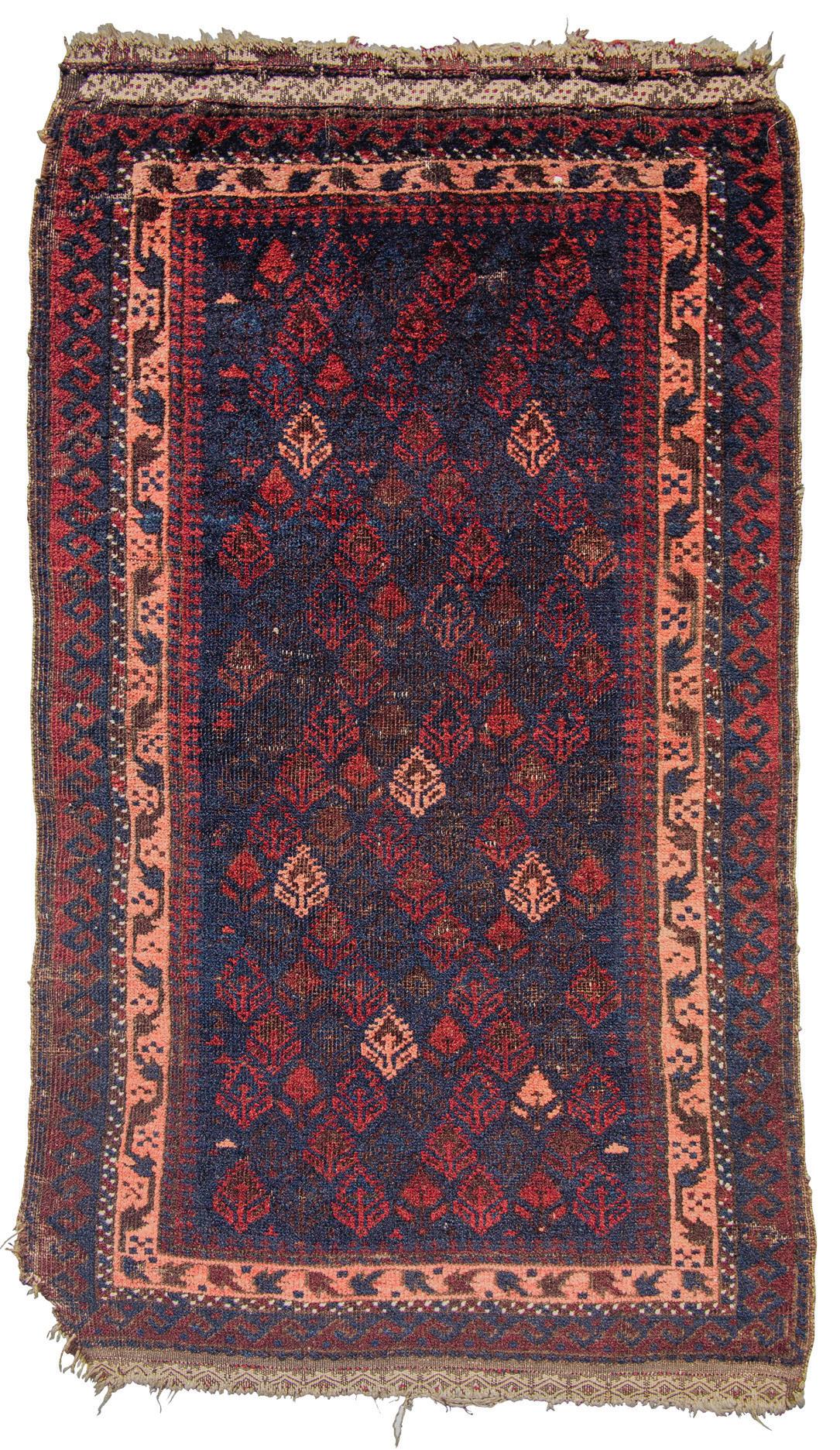

73. Baluch Bag Face, Northeast Persia / Afghanistan. An apparently older example of familiar type featuring what appears to be a cochineal dye used sparingly for some tertiary motifs on the left edge of the field. The two colors used for the primary designs create a harmonious balance, an effective manner to add some life to an otherwise static composition. The scale or size of these primary motifs, too, is eye dazzling – perfectly proportioned – providing a bold artistic statement woven from a memory rather than a graph. The outer border with a white ground might suggest an Afghan provenance. Cochineal is rarely found in any weavings from Afghanistan, which accounts for the question regarding possible provenance. 30” x 26” (75cm x 65cm) Asymmetric knot open left, 6h x 7v = 42 kpsi. Colors (7): orange/red, plum/aubergine, dark blue, brown (corrosive), light brown/olive (corrosive), natural ivory/white, cochineal (?).
Published: Plate 73. Cole, T. FROM THE LAND OF THE SUN. THE RICHARD STEWART COLLECTION OF BALUCH RUGS, BAGS, AND TRAPPINGS. 2022. $500-1000 Start: $250
74. Baluch Bag Face, Afghanistan. The warm palette and atypical “provincial” design indicates or at the very least suggests an Afghan origin. Consisting of eight pointed stars arranged on a deeply saturated indigo blue field framed by a border with an orange/red ground, the flatwoven closures at the top end are quite elaborately decorated, suggesting the weaving may have been intended or made for a special occasion. Such elaborately decorated closures with a supplemental design in each of the squares with different colored ground are carefully done, contrasted with the weave of the bag itself which is rather coarse – the type of finish associated with an Afghan provenance as seen in plate 90, a flat woven chanteh. 29” x 30” (72cm x 75cm) Asymmetric knot open left, 6.5h x 6.5v = 42.25 kpsi. Colors (6): 2 salmon red (dark, medium), 2 blues (medium, light), brown, natural ivory/white.
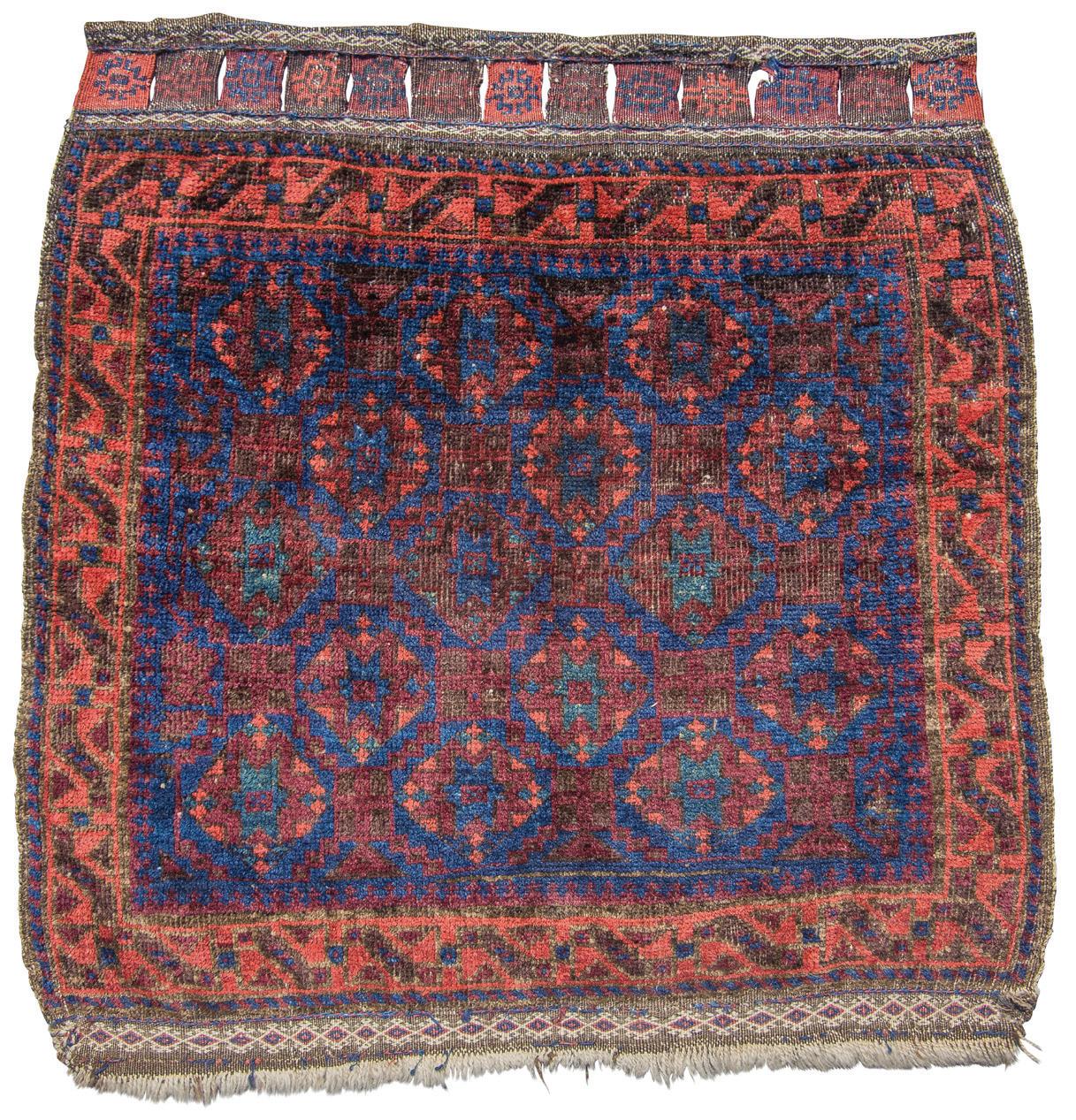
Published: Plate 74. Cole, T. FROM THE LAND OF THE SUN. THE RICHARD STEWART COLLECTION OF BALUCH RUGS, BAGS, AND TRAPPINGS. 2022. $500-1000 Start: $250

75. Baluch Bag Face, Afghanistan. Many collectors of Baluch material consider those from Afghanistan as “provincial”, summarily dismissing most in a cavalier fashion. This example, with seemingly a hodgepodge of patterns appropriated from well known “types”, is a very charming and older example. The hexagonal motifs, each containing an S (possibly representing a dragon?) form occur in more classic types, while the latch hook medallions scattered about the field are somewhat less than “perfect” in terms of symmetry, suggesting a free hand drawing. The scattered tertiary motifs, too, appear at the whim of the weaver rather than adhering to a codified aesthetic or graph. 20” x 20.” (50cm x 50cm) Asymmetric knot open left, 11.5h x 11.5v = 132 kpsi. Colors (7): 2 blues (dark, medium), red, orange/red, aubergine, reddish aubergine, natural ivory/white. Published: Plate 75. Cole, T. FROM THE LAND OF THE SUN. THE RICHARD STEWART COLLECTION OF BALUCH RUGS, BAGS, AND TRAPPINGS. 2022. $500-1000 Start: $250
76. Baluch Bag Face, Afghanistan. These “bird bags” are woven in both Afghanistan and northeast Persia though, oddly enough, are unknown in the Seistan region of Southeast Persia. The warm colorful palette, and relatively coarse weave suggest an Afghan provenance with an inviting orange/ red shade used as the ground color of the border in addition to outlining some of the birds. A common theme in many cultures from Anatolia to the Far East and China, the birds are often depicted bearing something on their backs, suggesting the myth of birds as intermediaries between earth and the heavens above. 25” x 20” (63cm x 50cm) Asymmetric knot open left, 8h x8v = 64 kpsi. Colors (7): maroon/ red, orange/red, dark blue, light blue, corrosive olive, slightly corrosive natural(?) brown, natural ivory/ white. Published: Plate 76. Cole, T. FROM THE LAND OF THE SUN. THE RICHARD STEWART COLLECTION OF BALUCH RUGS, BAGS, AND TRAPPINGS. 2022. $400-600 Start: $200


77. Baluch Bag Face, Afghanistan. Framed by the classic “stars and bars” border, a motif more familiar to and perhaps derived from an older Anatolian model, this example was probably woven in Afghanistan. The border invites precision while this version is hardly that. The somewhat coarse weave and palette assist to identify it as a provincial example from Afghanistan. If from Khorassan, one might expect a more traditional handling of the design, especially the border, as well as the dyes. 22” x 22” (55cm x 55cm) Asymmetric knot open left, 7h x 8v = 56 kpsi. Colors (7): red, light salmon red, medium aubergine, blue, dark aubergine, natural ivory/white, corrosive black. Published: Plate 78. Cole, T. FROM THE LAND OF THE SUN. THE RICHARD STEWART COLLECTION OF BALUCH RUGS, BAGS, AND TRAPPINGS. 2022. $400-600 Start: $200

78. Baluch Bag, Afghanistan. Most Baluch “bird” weavings are merely detached bag faces, but this example retains the flatwoven back as well as remnants of flatwoven end with braided goat hair that would have closed the bag. Probably from Afghanistan, it was apparently treasured by the weaver, as highlights appear with imported silk. Certainly not the earliest example, it may only retain the back and flatwoven closures for this reason. 20” x 22” (50cm x 55cm)
Asymmetric knot open left, 9h x 11v = 99 kpsi. Colors (9): dark salmon red, dark blue, natural ivory/white, corrosive olive/brown, gold/yellow, brown/red, purple/ red, camel brown, faded light red. Published: Plate 77. Cole, T. FROM THE LAND OF THE SUN. THE RICHARD STEWART COLLECTION OF BALUCH RUGS, BAGS, AND TRAPPINGS. 2022. $400-600 Start: $200

80. Baluch Bag Face, Afghanistan. The bird in the center outlined with white wool is not uninteresting, when viewed with that in pl. 77. Both weavings share the same border though the design on the body of the bird is very different. Though that in pl. 77 is a more detailed, somehow intriguing pattern, the simplicity of design here suggests an entirely different approach has been taken. The absence of contrast between the dark aubergine/purple dye (darker due to the fact it has been applied to brown wool rather than ivory/white wool) makes it difficult to see clearly those birds placed in the four corners. 24” x 20” (60cm x 50cm). Asymmetric knot open left, 8h x 10v = 80 kpsi. Colors (8): red, blue, aubergine/purple (over dyed on brown wool), light purple, yellow/gold, natural ivory/white, black/brown (corrosive), natural light brown.
Published: Plate 80. Cole, T. FROM THE LAND OF THE SUN. THE RICHARD STEWART COLLECTION OF BALUCH RUGS, BAGS, AND TRAPPINGS. 2022. $400-600 Start: $200

79. Baluch Bag, Face Afghanistan. Atypically dark for an Afghan weaving, the juxtaposition of dark aubergine and the saturated indigo blue field provides little contrast for the three complete and two partial birds (at the top end), a somewhat distracting feature. The owner wonders if these are intended to be viewed as “birds”, suggesting winged horses. Whatever they may be, given the long-standing mythology of birds as intermediaries between earth and the heavens above, they have been tentatively identified as such. The idea of winged horses is a prolific theme too, appearing in many forms in far east Asian, Turkic as well as Greek mythology. 21” x 19” (52cm x 48cm) Asymmetric knot open left, 8h x 10v = 80 kpsi. Colors (8): red, tip faded red (appearing to be gold, possibly fuchsine?), blue, light blue, aubergine (over dye of natural black wool), natural black, natural brown, natural ivory/ white (flatwoven end). Published: Plate 79. Cole, T. FROM THE LAND OF THE SUN. THE RICHARD STEWART COLLECTION OF BALUCH RUGS, BAGS, AND TRAPPINGS. 2022. $400-600 Start: $200

A colorful fragment of a bag face, exhibiting a rarely seen pattern that some might consider akin to similar motifs more commonly encountered in some Persian tribal weavings (see Rothberg, pl. 7) which, according to Elena Tsareva, may be related to the Turkmen gorbaghe gol. Whether this is true or merely the result of “independent invention” (a phrase coined by Elizabeth Barber), is unclear. The art is exceptionally “rustic”, apparently a very free hand drawing. The palette is unusually saturated, dominated by the brilliant salmon red in the central motif, a color some associate with older examples. The purple ground color is quite saturated as well, not commonly seen in such profusion. Missing all border systems along with the closures at the top end, nevertheless it appears it was once part of a khorjin, given the size of the field. 19” x 17” (47cm x 42cm) Asymmetric knot open left, 6h x 9v = 54 kpsi. Colors (7): red, salmon red, blue/green, purple, light salmon red/orange, natural tan, natural ivory/white. Published: Plate 82. Cole, T. FROM THE LAND OF THE SUN. THE RICHARD STEWART COLLECTION OF BALUCH RUGS, BAGS, AND TRAPPINGS. 2022. $200-400 Start: $100

81. Baluch Bag, Afghanistan. A modest and quite colorful example of Baluch weaving from west Afghanistan. The colorful, warm palette suggests an Afghan provenance, and the primary border design with hexagons containing S (or dragon?) motifs within, too, is a feature confined to Afghan weavings. The coarser weave also conforms to other examples from Afghanistan. 17” x 14” (43cm x 35cm) Asymmetric knot open left, 6h x 9v = 54 kpsi. Colors (8): blue, blue/green, red/orange, red, purple-brown, natural ivory/ white, olive, corrosive brown. Published: Plate 81. Cole, T. FROM THE LAND OF THE SUN. THE RICHARD STEWART COLLECTION OF BALUCH RUGS, BAGS, AND TRAPPINGS. 2022. $300-500 Start: $150
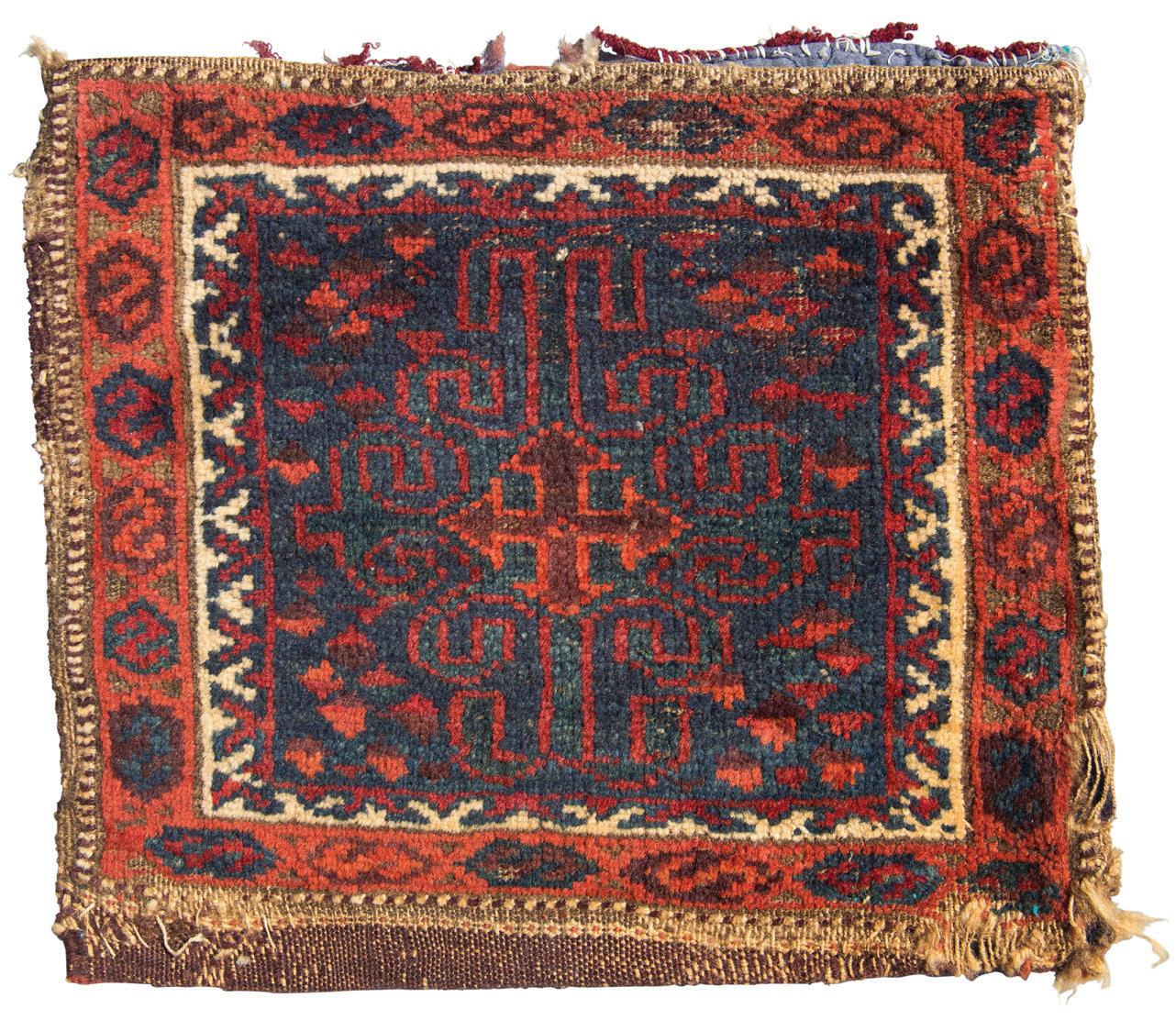
83. Baluch Saddle Bags (separated/fragmented), Afghanistan. Both sides of what was once a complete khorjin (saddle bag), the less than formal though classic design type is somehow not an unexpected feature of these bags from western Afghanistan. The boldly drawn latch hook medallion again features the juxtaposition of a glowing blue dye with a deeply saturated purple/brown hue, echoed again in the border with the bold reciprocal trefoil border. The wool is very high quality, extremely silky and lustrous, as well as left a bit longer, imparting an animal pelt-like feel to the hand. Exhibiting obvious signs of use with some wear in the lower right corner, it is likely an authentic weaving made for domestic use rather than local trade. 22” x 24” (55cm x 60cm) Asymmetric knot open left, 8h x 8v = 64 kpsi. Colors (6): 2 blues (light, medium), red, purple/brown, dark blue-blue/ green, corrosive olive. Published: Plate 83. Cole, T. FROM THE LAND OF THE SUN. THE RICHARD STEWART COLLECTION OF BALUCH RUGS, BAGS, AND TRAPPINGS. 2022. $400-600 Start: $200
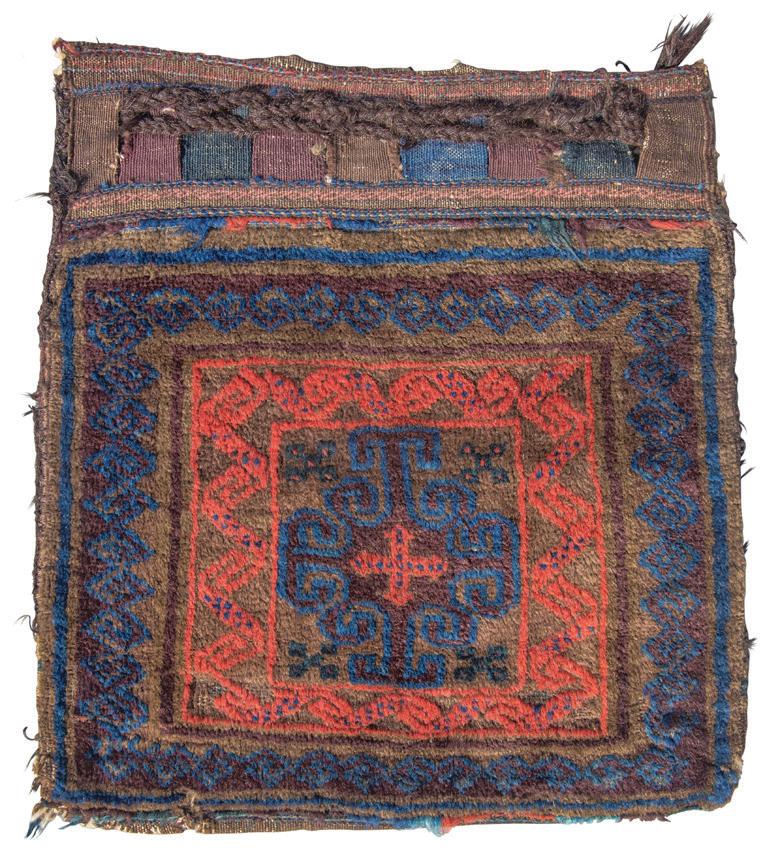

84. Baluch Bag Face, Afghanistan. An oft repeated design used by nearly all the Baluch weaving groups of western Afghanistan, with fewer in northeast Persia (and none from Seistan). More often encountered on bags, rather than rugs, it is possible it is derived from an earlier aesthetic, as the large S forms in the quartered octagons may represent dragons or another serpentine creature. The palette is warm and inviting, a classic feature of the best from those groups located in western Afghanistan. 19” x 22” (48cm x 55cm) Asymmetric knot open left, 7h x 9v = 63 kpsi. Colors (8): red, dark blue, light salmon red/orange, dark aubergine, medium blue, natural dark brown, bleached ivory/white, light olive/brown (flatwoven end). Published: Plate 84. Cole, T. FROM THE LAND OF THE SUN. THE RICHARD STEWART COLLECTION OF BALUCH RUGS, BAGS, AND TRAPPINGS. 2022. $400-600 Start: $200

86. Baluch Chanteh, Afghanistan. Chanteh are small personal bags, thought to have been made by women for themselves as storage receptacles for personal objects. With a memling gol as the central ornament in the field framed by a border with elements woven in white, it is a classic mélange of design seen only in Afghanistan, rather than Khorassan or southeast Persia. The palette, too, reflects the aesthetic of the groups gathered in western Afghanistan. It is finely woven and was probably a treasured family heirloom at one time. 15” x 13” (.37m x .32m) Asymmetric knot open left, 9h x 11v = 99 kpsi. Colors (8): medium salmon red, medium/light blue, aubergine, blue/green, dark blue, natural dark brown, natural light brown, bleached ivory/white. Published: Plate 86. Cole, T. FROM THE LAND OF THE SUN. THE RICHARD STEWART COLLECTION OF BALUCH RUGS, BAGS, AND TRAPPINGS. 2022. $300-500 Start: $150

85. Baluch Bag Face, Afghanistan. Another example of this classic design type favored by some of the “Baluch” weavers from Afghanistan. The central latch hook medallion is often identified as “Mushwani” in the marketplace but given the very different structures and origins for rugs and bags of this design type, it is amazing the misnomer continues to be indiscriminately cast about in the literature. It is unfortunate that the only two references to “Mushwani” weavings in the literature make no reference to design or color, and only described as “coarsely woven”. The colors are all derived from natural dyestuffs; the dark maroon/red, though, is seldom seen suggesting a singular provenance from where few weavings have come to our attention. 27” x 29” (67cm x 72cm) Asymmetric knot open left, 6.5h x 8v = 52 kpsi. Colors (5): dark maroon red, orange red, blue, blue/green, olive brown. Published: Plate 85. Cole, T. FROM THE LAND OF THE SUN. THE RICHARD STEWART COLLECTION OF BALUCH RUGS, BAGS, AND TRAPPINGS. 2022. $400-600 Start: $200
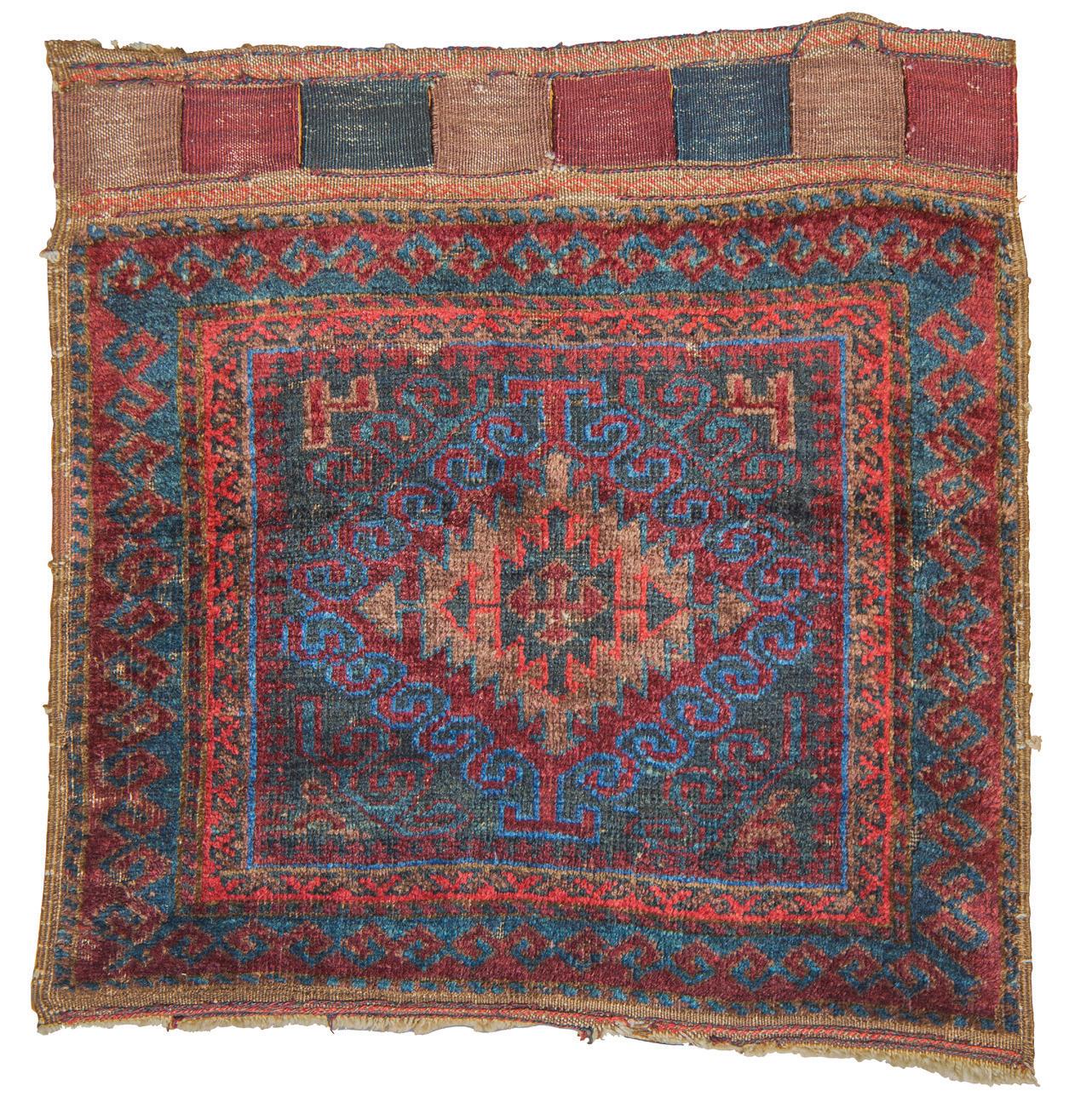
88. Baluch Bag face, Afghanistan. One half of a khorjin (saddle bag), this weaving is probably from southwest Afghanistan. The colorful palette with the radiating latch hook medallion design suggests a Seistan origin, but there is no evidence of the pile “shoulders” that would have joined the two sides of a complete saddle bag, a typical characteristic of saddle bags from that area. The border, too, is not common to rugs or bags from Seistan but the embroidered finish on the kilim end (top) is shared by groups, apparently located on both sides of the border. The less than strict division of related groups located on either side of a porous political border probably accounts for the crossover characteristics.
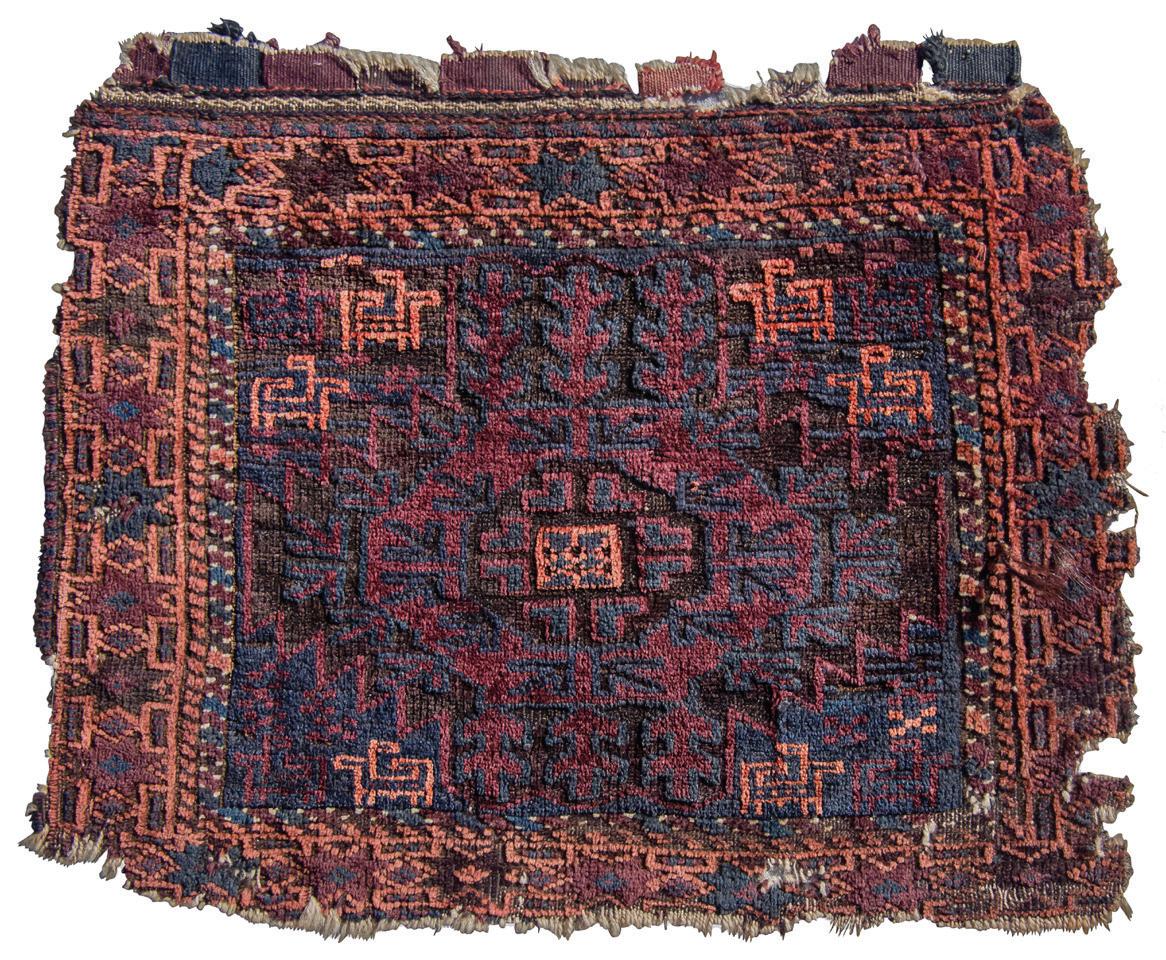
20” x 25” (50cm x 62cm) Asymmetric knot open left, 11h x 9v = 99 kpsi. Colors: dark aubergine, red, dark green, blue, natural black, bleached ivory/white. Published: Plate 88. Cole, T. FROM THE LAND OF THE SUN. THE RICHARD STEWART COLLECTION OF BALUCH RUGS, BAGS, AND TRAPPINGS. 2022. $300-500 Start: $150
87. Baluch Bag Face, Afghanistan. The medallion dominating the field appears to be one bearing a relationship with the gorbaghe gol of the Turkmen with six animals, horned ibex, flanking it. Though the colors lack contrast, the dark blue and dark purple/aubergine are used without a third color to outline the motifs – an interesting feature. The classic “stars and bars” border is drawn well enough though the weaver encountered problems successfully resolving the design in the corners, notably the upper left. 22” x 18” (55cm x 45cm) Asymmetric knot open left, 6.5h x 11v = 71.5 kpsi. Colors (7): dark blue, dark aubergine/purple, light salmon red, light orange/salmon red (faded), corrosive dark brown/ black, corrosive dark aubergine, natural ivory/white.
Published: Plate 87. Cole, T. FROM THE LAND OF THE SUN. THE RICHARD STEWART COLLECTION OF BALUCH RUGS, BAGS, AND TRAPPINGS. 2022. $300-500 Start: $150
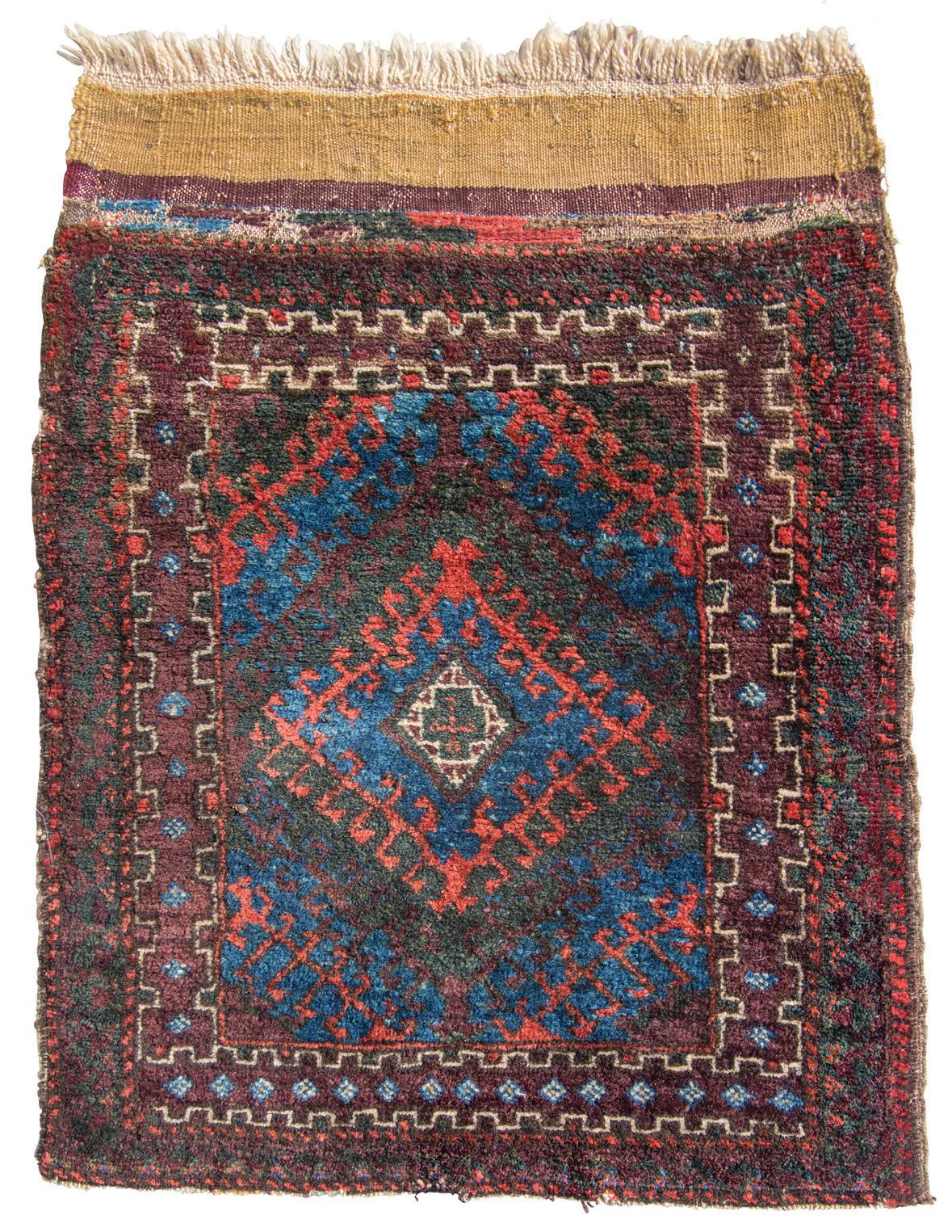
89. Baluch Bags (separated/fragmented khorjin/saddle-bag), Afghanistan. A charming pair of bags, once part of a complete khorjin (saddle bag), with a beautiful, saturated array of colors with a warm and visually engaging palette, typical of the Afghan aesthetic. The classic stars and bars border (on the white ground) is drawn in such a manner as to indicate a free hand, rather than woven from a graph. 17” x 17” (43cm x 43cm) Asymmetric knot open left, 6h x 8v = 48 kpsi. Colors (10): dark red, light red, green, dark blue, medium blue, corrosive aubergine, natural brown, dark blue/green, medium light blue/green, corrosive brown. Published: Plate 89. Cole, T. FROM THE LAND OF THE SUN. THE RICHARD STEWART COLLECTION OF BALUCH RUGS, BAGS, AND TRAPPINGS. 2022. $400-600 Start: $200

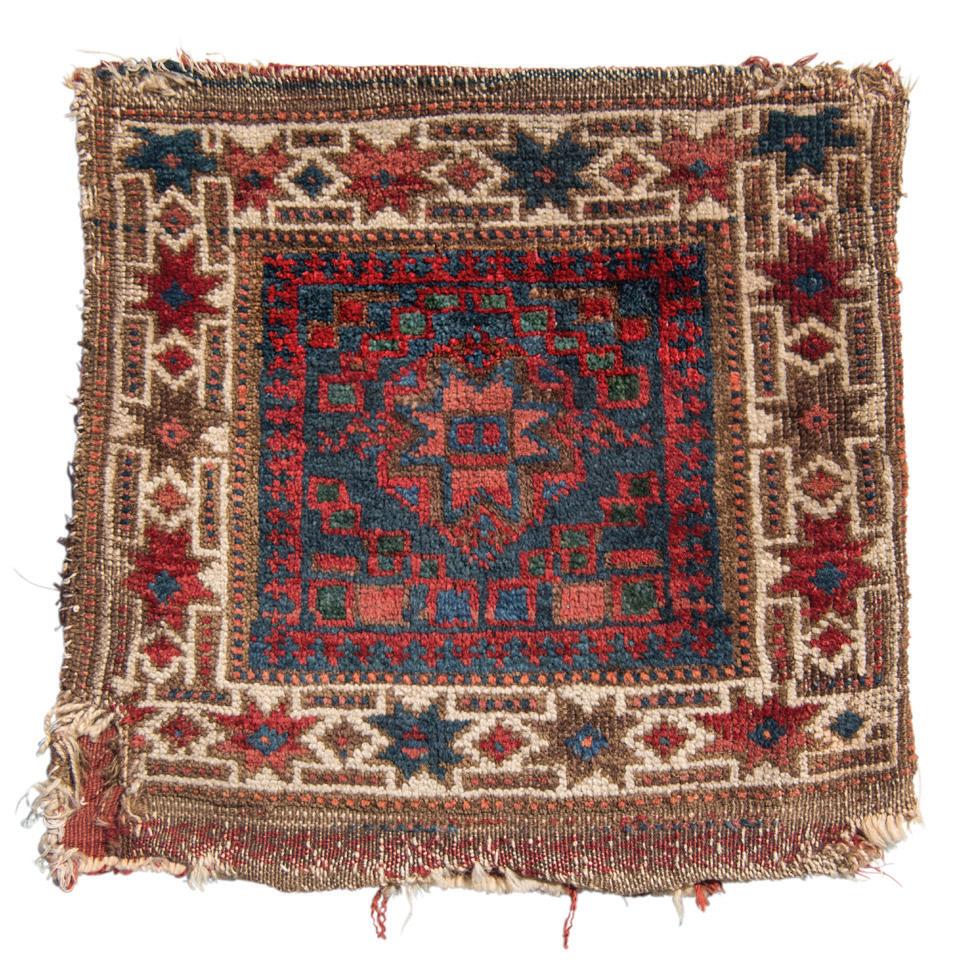
90. Baluch Bag, Afghanistan. A common type of flatweave work and design from Afghanistan, the weave is extremely dense and tight. The decorated closures at the top end are a firm indicator for the Afghan provenance, also seen on the closures of pile bags from the same area. As common as these are, no firm tribal attribution other than “Baluch” is ever offered by dealers in the Kabul marketplace. 12” x 13” (30cm x 33cm)Colors (5): natural ivory/white, dark blue, aubergine, blue/green, medium red. Published: Plate 90. Cole, T. FROM THE LAND OF THE SUN. THE RICHARD STEWART COLLECTION OF BALUCH RUGS, BAGS, AND TRAPPINGS. 2022. $300-500 Start: $150
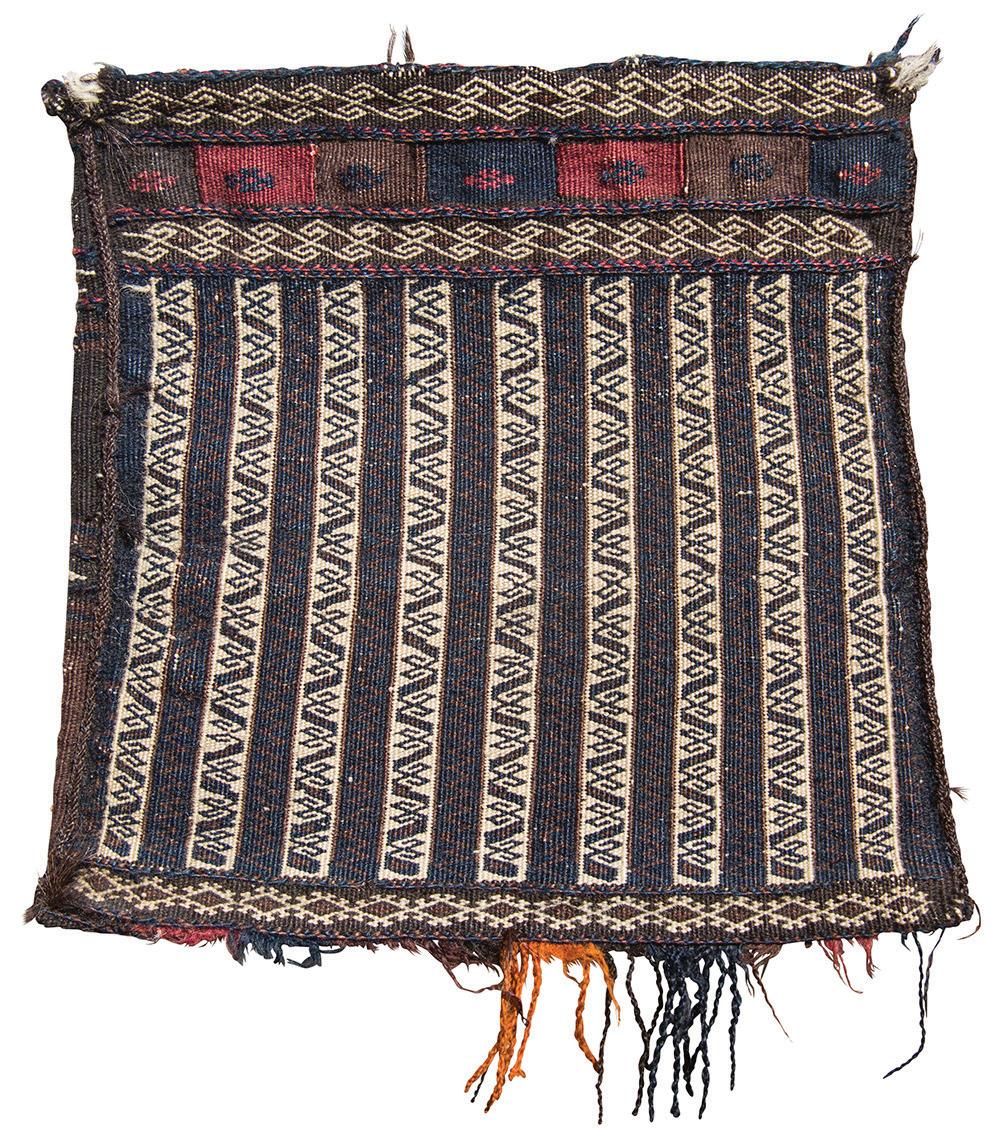
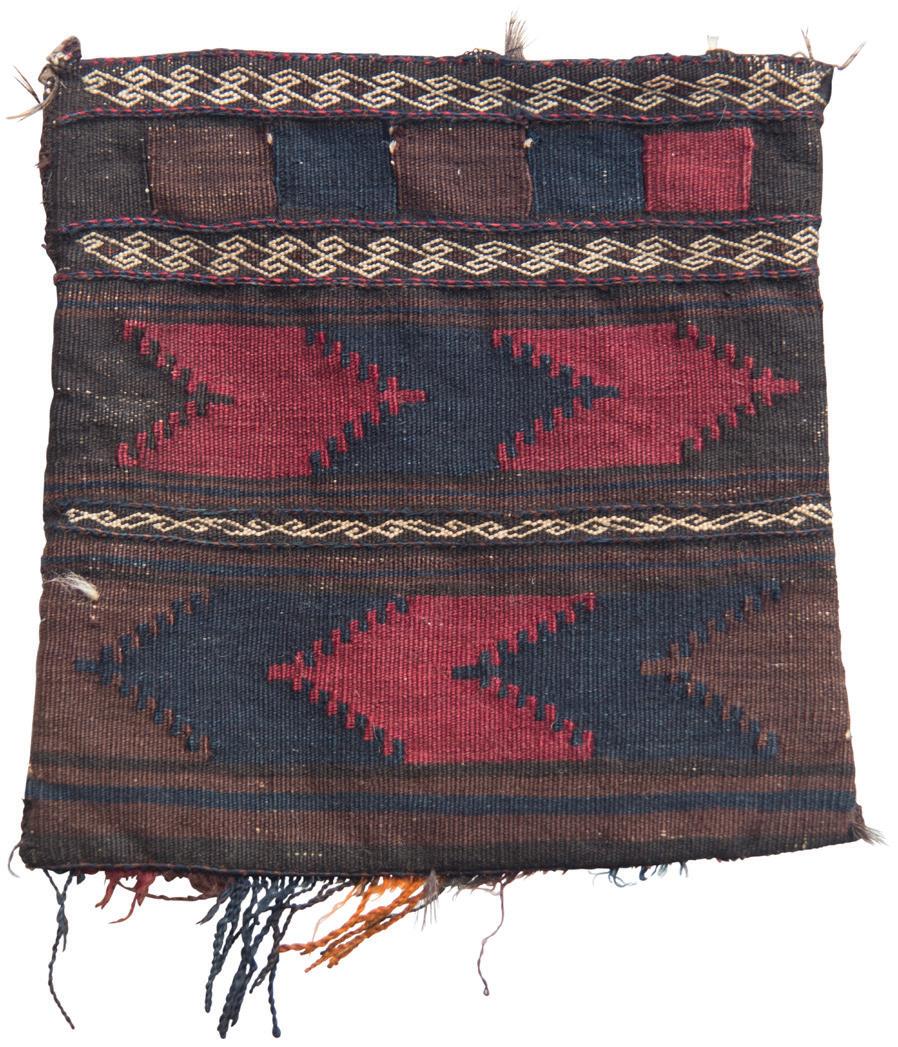
91. Baluch Chanteh, Northeast Persia. While not immediately recognizable as such, this weaving is a chanteh (or personal bag) splayed open. The weavers cleverly knew how to handle the directional “tree” design, making it upside down in the lower half so that when folded in half and used, the pattern would retain its correct orientation viewed from either side. 14” x 25” (35cm x 63cm) Colors (7): blue, purple-brown, brown, red, natural black, natural brown, natural ivory/white.
Published: Plate 91. Cole, T. FROM THE LAND OF THE SUN. THE RICHARD STEWART COLLECTION OF BALUCH RUGS, BAGS, AND TRAPPINGS. 2022. $300-500 Start: $150
92. Baluch Chanteh, Afghanistan. Though tempting to attribute this chanteh to weavers in Khorassan, the palette is warmer, possibly suggesting an Afghan provenance. The zig-zag design (blue on a red ground) is more often seen in Afghan weavings. Somehow, the palette seems more in keeping with what some believe is an Afghan provenance. The bag is complete, with evidence of closures at both ends as it would have been folded in half and bound on the sides. 9” x 19” (23cm x 48cm) Colors (5): plum red, light orange, dark blue, aubergine, dark brown.

Published: Plate 92. Cole, T. FROM THE LAND OF THE SUN. THE RICHARD STEWART COLLECTION OF BALUCH RUGS, BAGS, AND TRAPPINGS. 2022. $200-400 Start: $100

93. Baluch Chanteh, Afghanistan. This is a simple flatwoven chanteh or personal bag that, in all likelihood, was made for domestic use rather than intended for trade. Perhaps not as old as some might prefer, the design is timeless, probably pre-dating any extant examples. The vividly contrasted zig-zag lines are visually engaging feature as it, too, is a free hand drawing with no attempt to make a vibrant, perfectly balanced composition. 9” x 9” (23cm x 23cm) Colors (5): dark brown, natural white/ivory, Braided end finish: red, 2 blues (dark, medium). Published: Plate 93. Cole, T. FROM THE LAND OF THE SUN. THE RICHARD STEWART COLLECTION OF BALUCH RUGS, BAGS, AND TRAPPINGS. 2022. $400-600 Start: $200
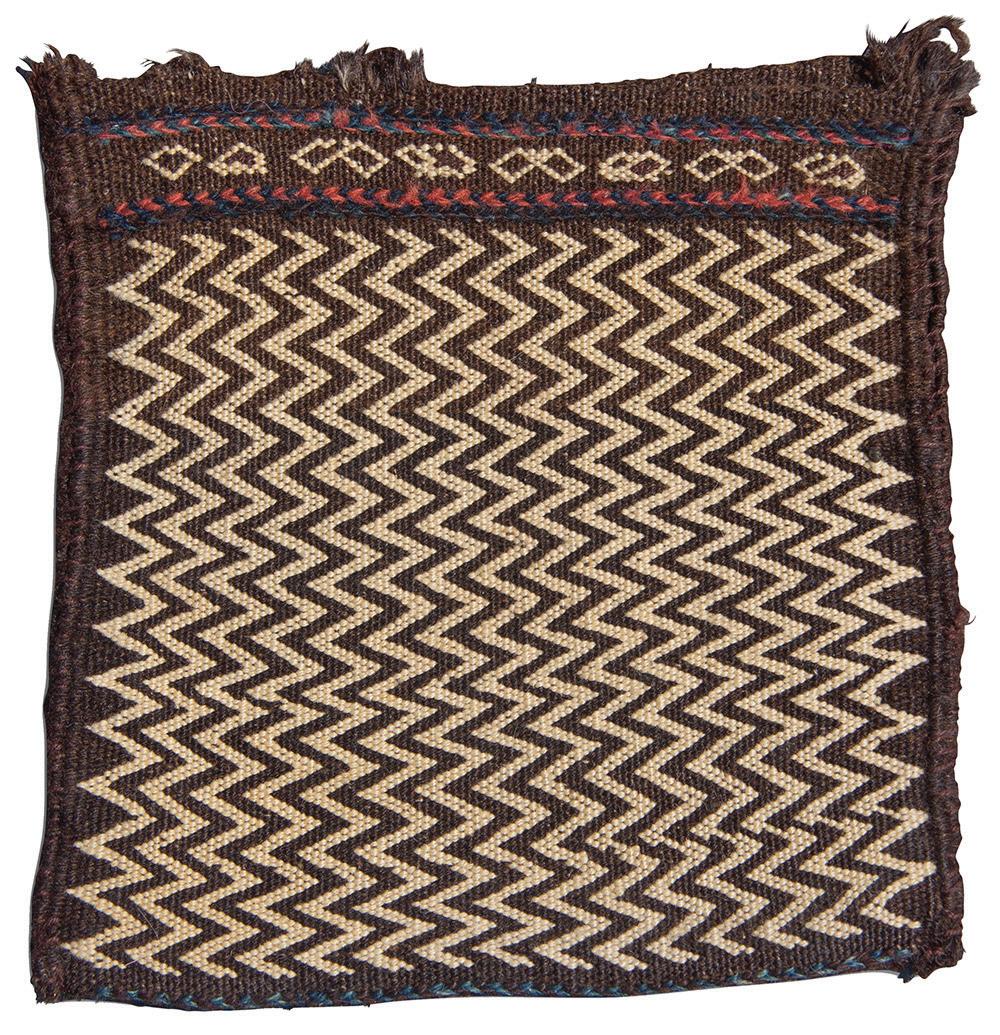
94. Baluch Storage Bag, Afghanistan. Possibly the face of a pushti or storage bag from western Afghanistan rather than a balisht. The coarser weave and palette is consistent with an Afghan attribution, which would imply the function as well. Missing the back and flatwoven ends, it is impossible to know for sure, but most pushti include a similar end finish as found in khorjin/saddle bags from the same region (see pl. 77). The distinctive palette seems to be employed by weavers in Afghanistan – as the plum/aubergine ground color does not appear in Baluch weavings from either northeast or southeast Persia. The wool and handle recall similar examples referred to in the Afghan marketplace as Taimani. 18” x 32” (45cm x 80cm) Asymmetric knot open left, 5.5h x 10v = 55 kpsi. Colors (9): dark plum red, blue, yellow, red, light red, blue/green, natural dark brown, corrosive light brown, natural ivory/white. Published: Plate 94. Cole, T. FROM THE LAND OF THE SUN. THE RICHARD STEWART COLLECTION OF BALUCH RUGS, BAGS, AND TRAPPINGS. 2022. $200-400 Start: $100
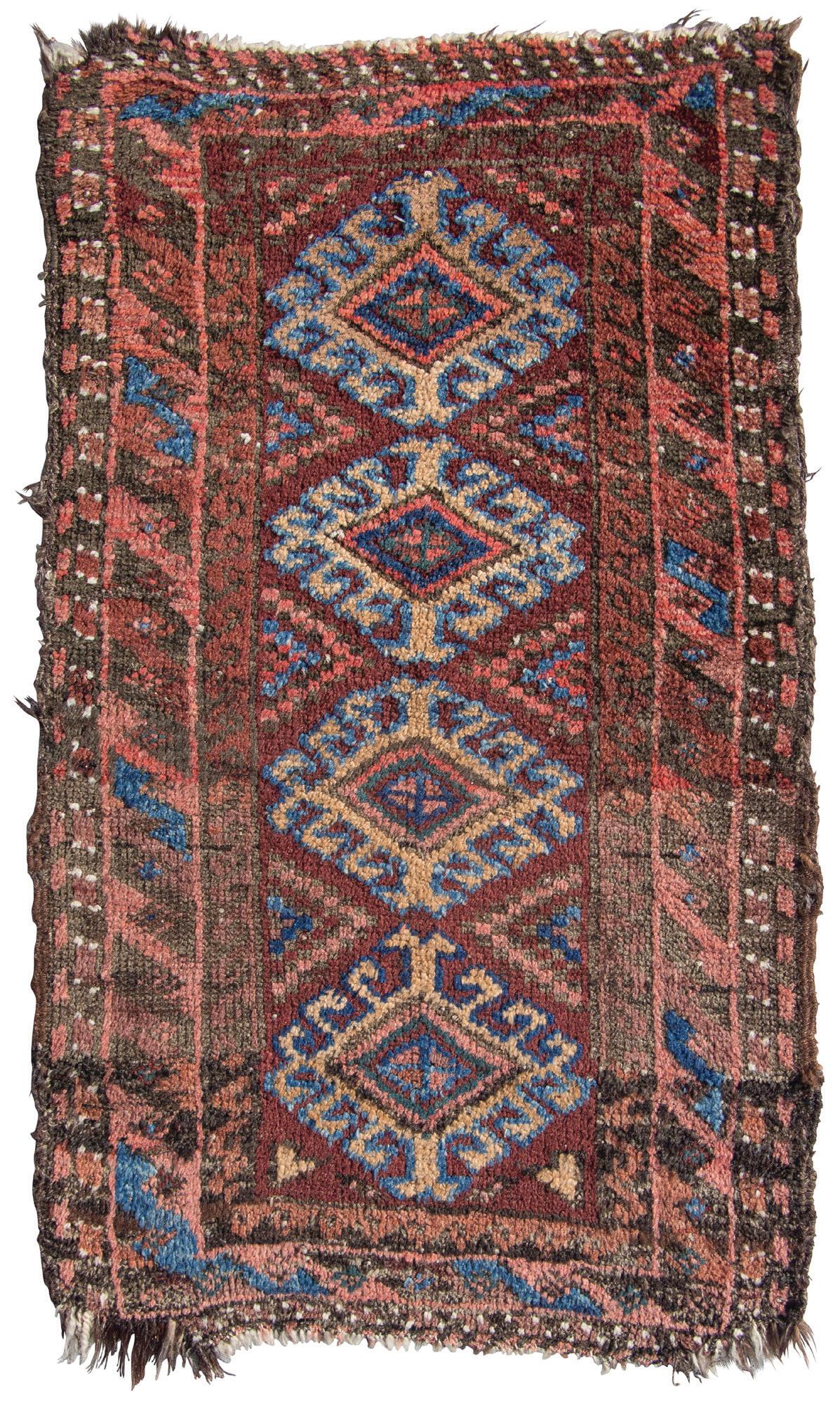
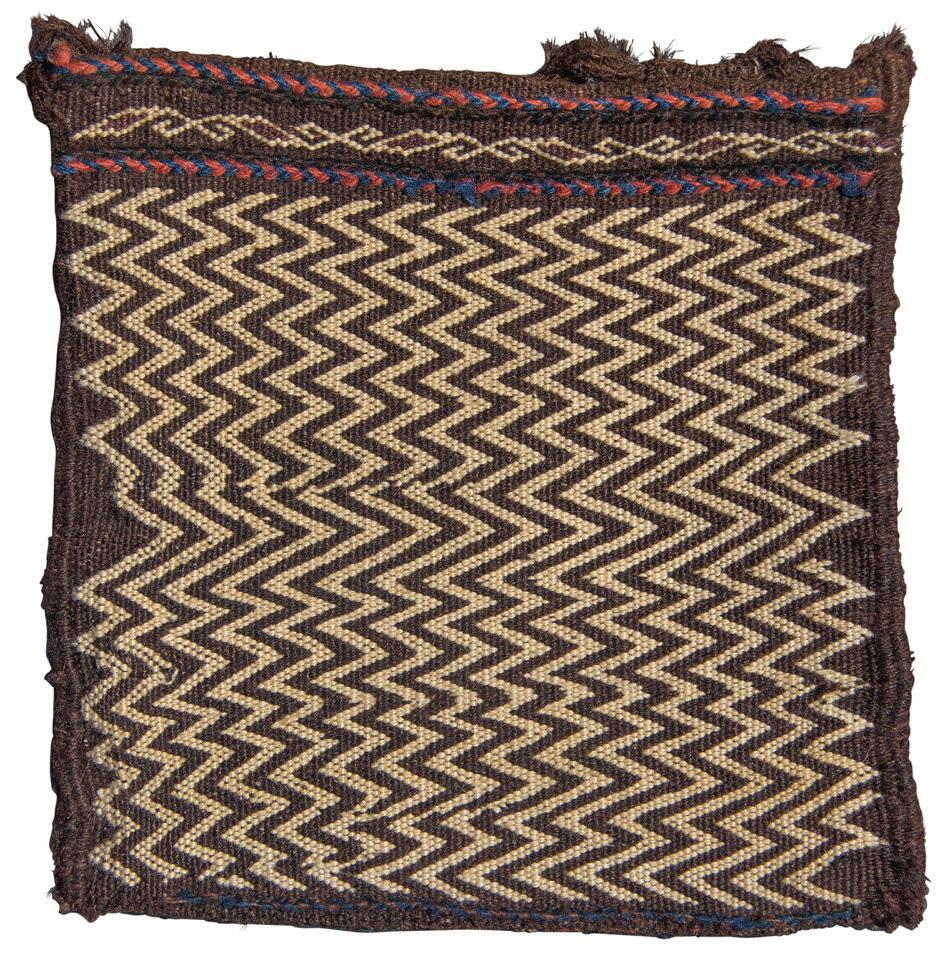
95. Baluch Trapping, Afghanistan. A charming example from Afghanistan, with a classic border element uncharacteristically appearing as the primary field design. Given the whimsical freehand drawing coupled with the warm and inviting palette, it is safe to assume this is from Afghanistan. The primary border is one more often seen in rugs as a secondary border system. It is no wonder Boucher, among others, believes weavings of this type were made for domestic use, and never intended for commercial purposes. 12” x 21” (30cm x 52cm) Asymmetric knot open left, 9h x 13v = 117 kpsi. Colors (6): salmon red, dark blue, medium blue, aubergine, corrosive light brown, natural white. Published: Plate 95. Cole, T. FROM THE LAND OF THE SUN. THE RICHARD STEWART COLLECTION OF BALUCH RUGS, BAGS, AND TRAPPINGS. 2022. $200-400 Start: $100
96. Trapping Northeast Persia. The fine weave and silk highlights at the center suggest this was made as part of the dowry to showcase the weaving skills of a woman. The palette is typical of larger flatweaves or kilims commonly attributed, true or not, to the Taimuri groups of northeast Persia. 8” x 21” (20cm x 52cm).


Published: Plate 96. Cole, T. FROM THE LAND OF THE SUN. THE RICHARD STEWART COLLECTION OF BALUCH RUGS, BAGS, AND TRAPPINGS. 2022.
$200-400 Start: $100
97. Baluch Trapping, Afghanistan. Some may argue that regarding white as a color is a bit of a stretch. With that said though, the white wool seen here is “lower” than the dyed areas surrounding it suggesting it was treated as such and bleached. It is thought that natural wool was perhaps not light enough (?) for the intended design has been bleached prior to weaving, contributing to the corroded appearance as the fibers have been weakened by the process. The colors are exceptionally vibrant with a deeply saturated red and blue green in addition to a clear aubergine (purple) dye. Often overlooked in the marketplace, these trappings and bands were probably produced for domestic use rather than for trade in the local marketplaces. 11” x 31” (28cm x 78cm) Asymmetric knot open left, 9h x 9v = 81 kpsi. Colors (7): 2 reds (dark medium), blue/green, blue, aubergine, corrosive brown, bleached ivory/white. Published: Plate 97. Cole, T. FROM THE LAND OF THE SUN. THE RICHARD STEWART COLLECTION OF BALUCH RUGS, BAGS, AND TRAPPINGS. 2022. $200-400 Start: $100
98. Baluch Trapping, Afghanistan. A little-used animal trapping, possibly made for dowry. The large-scale compartmented design appears to be derived from or related to a ubiquitous fertility symbol (kotchanak) seen used in rugs throughout Central Asia. Again, the white ground border, often appearing as a minor border in rugs from the area, is the primary one in this trapping. Though in good condition with an orange hue (probably a natural dye), it may be older than it first appears, as it has been well preserved for posterity. 9” x 33” (23cm x 83cm) Asymmetric knot open left, 7h x 8v = 56 kpsi. Colors (11): 2 red (dark, medium), 2 blue (dark, medium), corrosive olive, aubergine, 2 corrosive browns (dark, medium), natural ivory/white. Published: Plate 100. Cole, T. FROM THE LAND OF THE SUN. THE RICHARD STEWART COLLECTION OF BALUCH RUGS, BAGS, AND TRAPPINGS. 2022. $200-400 Start: $100

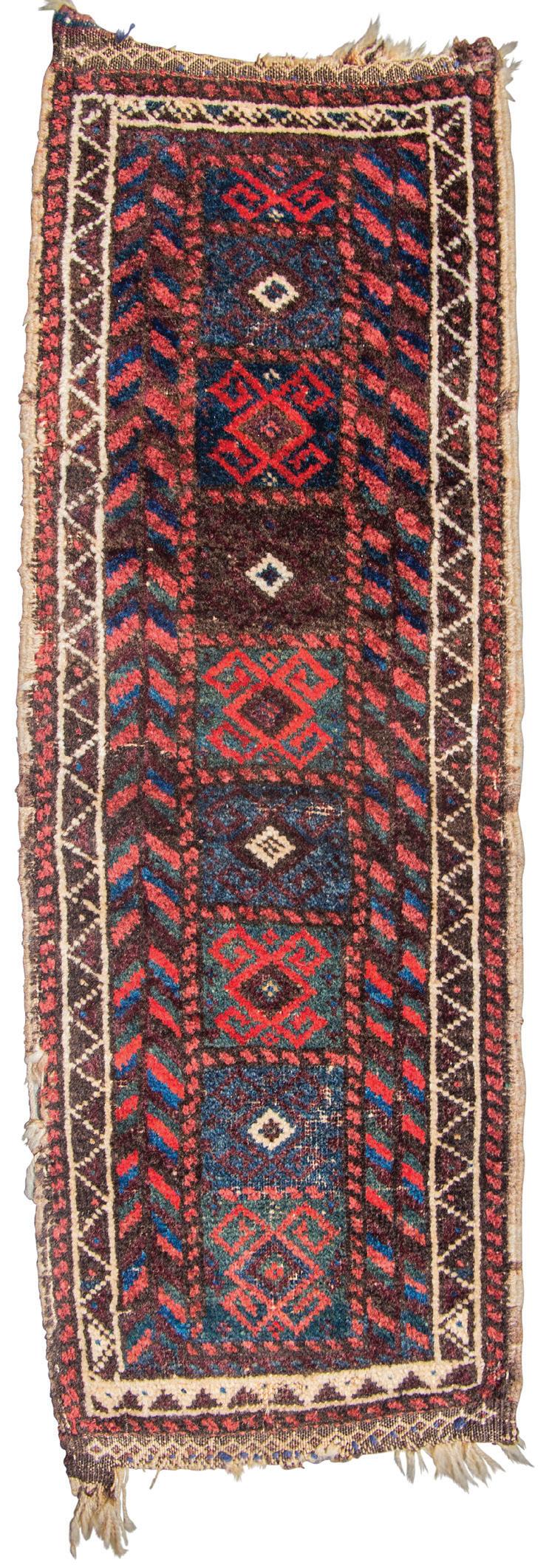
99. Baluch Trapping, Afghanistan. A provincial example of a Baluch pile trapping from Afghanistan featuring misdrawn eightpointed stars within octagons. The colors are clear and true while the flatweave finish at either end is a classic feature used by weavers in western Afghanistan. 10” x 16” (25cm x 40cm) Asymmetric knot open left, 8.5h x 8.5v + 72.5 kpsi. Colors (8): 2 red (dark, light), blue, aubergine, white, olive, bleached ivory/white, natural ivory/white (kilim end). Published: Plate 98. Cole, T. FROM THE LAND OF THE SUN. THE RICHARD STEWART COLLECTION OF BALUCH RUGS, BAGS, AND TRAPPINGS. 2022. $200-400 Start: $100

100. Baluch Trapping, Northeast Persia. A finely woven small weaving, presumably made as part of or complete animal trapping. The curvilinear shape may suggest it was “pulled” while used, stretching the woolen structure to one side - the curve to the left is the result. The field color, now yellow, was once a reddish hue. Presumably a fuchsine dye (invented in Europe circa 1857) which found its way to Asia within 25 years or so and continued to be imported through the end of the 19th century, it was an expensive import, usually appearing as a highlight rather than in such profusion as seen here. The high knot count per square inch in conjunction with this dye suggests it may have been made for a special occasion. The design, too, is very special, apparently derived from or influenced by patterning seen in ancient Anatolia (see detail, opposite page). So true to what may be the prototype, it leads one to wonder how and why it is seen in a late 19th century Baluch weaving from northeast Persia. 8” x 20” (20cm x 50cm) Asymmetric knot open left, 12h x 13v = 156 kpsi. Colors (6): yellow (fuchsine changed from red), corrosive dark brown, corrosive reddish purple/brown, natural brown, dark blue, red (tip faded). Published: Plate 99. Cole, T. FROM THE LAND OF THE SUN. THE RICHARD STEWART COLLECTION OF BALUCH RUGS, BAGS, AND TRAPPINGS. 2022. $300-500 Start: $150

101. Baluch Salt Bag, Afghanistan. A rather posh weaving with soft lustrous wool, these salt bags were never intended for daily use as receptacles for rock salt, but more likely woven for dowry or another special celebration. While perhaps not the oldest extant example, it is difficult to know exactly when it was made. The condition is pristine, which suggests to some it is later, but the colors are all derived from natural dyes and the quality of weave and wool are consistent with earlier material – not the oldest examples but certainly “old enough”. The contrasting colors contributing to a lively palette are not an attribute of late material nor is the soft lustrous wool. The absence of symmetry in the diagonal rows of stepped polygons without strictly adhering to alternating colors contributes to the art, perhaps intended for family use (dowry?). The yellow dye has, for the most part, remained fast without fading – a clear lemon-yellow shade often associated with older examples from the region.
19” x 22” (23cm x 55cm) Asymmetric knot open left, 7h x 10v = 70 kpsi. Colors (6): red, dark blue, medium blue, natural ivory/white, natural grey/brown, yellow. Published: Plate 101. Cole, T. FROM THE LAND OF THE SUN. THE RICHARD STEWART COLLECTION OF BALUCH RUGS, BAGS, AND TRAPPINGS. 2022. $300-500 Start: $150
102. Kurd, Northeast Persia. With the unusual design, the atypical presence of two knot types (excluding the repair in the center), and odd size, (for what purpose was it made?) it may perhaps be attributable to the “Kurd” Baluch of Khorassan. The primary border is one associated with Kurdish rugs and bags, and seldom used by other weavers from the area, though the Arab groups flirt with this design type. The dark brown animal hair-like warps are atypical as well and, for the most part, unknown in Baluch rugs or bags. The wool, though, has the specific “feel” of a Baluch, hence to term it as woven “in the Baluch style” might be accurate. Featuring four anthropomorphic figures depicted in white, the design is also very atypical. 27” x 31” (68cm x 78cm) Asymmetric knot open left and symmetric knot, 7h x 8v = 56 kpsi. Colors (9): natural light olive/brown, corrosive dark brown, light salmon red, medium red, medium blue, bleached ivory/white, corrosive medium brown, natural medium brown, corrosive aubergine. Published: Plate 102. Cole, T. FROM THE LAND OF THE SUN. THE RICHARD STEWART COLLECTION OF BALUCH RUGS, BAGS, AND TRAPPINGS. 2022. $300-500 Start: $150
103. Kurd, Quchan region northeast Persia. Some might doubt this is a Baluch weaving. The knot count and presence of both asymmetric and symmetric knotting, as well as cotton warps is, to say the least, atypical. Though, in feeling (literally, the wool is very soft and lustrous as one expects with Baluch weavings) and appearance (other than the end finish evident at the top end), it seems to be just that – made “in the Baluch style”. The design, too, appears to be a Baluch “take”, including eyes in the confronting animal heads flanking a pole from which they are suspended. The warps consist of hand-spun cotton – a marker (according to Dr. Murray Eiland in his studies of Chinese rugs) of some age, i.e. approximately mid 19th century. The fourcord selvedge, too, is a mystery, relegated in Baluch studies as one seen only in those weavings from the Torbat-i-Heydari region, but with a different finish here – a loosely wrapped brown wool, rather than the tightly bound dark and coarser wool or goat hair (?). But for what purpose was it made – perhaps as a chanteh missing the other half? We may never know for sure. 14” x 20” (35cm x 50cm) Asymmetric knot open left, symmetric knotting (border only), 4h x 6v = 24 kpsi. Colors (6): 3 blues (dark, medium, light), red, camel wool, natural brown. Published: Plate 103. Cole, T. FROM THE LAND OF THE SUN. THE RICHARD
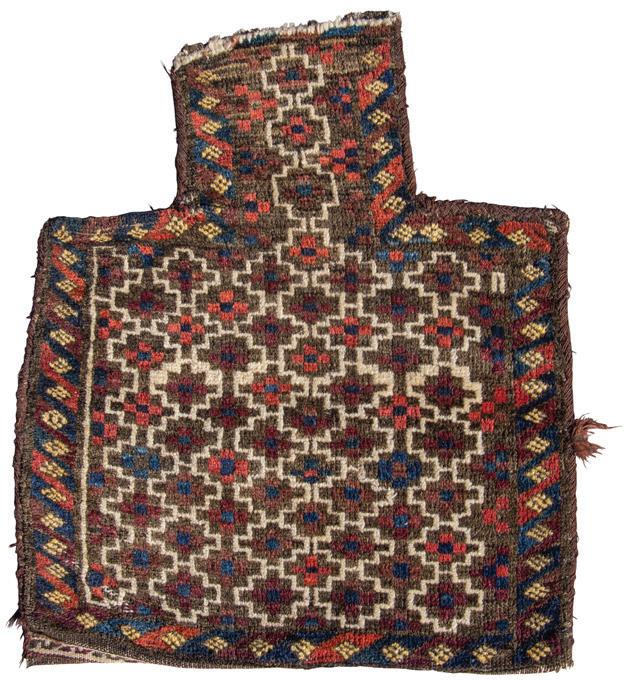
STEWART COLLECTION OF BALUCH RUGS, BAGS, AND TRAPPINGS. 2022. $300-500 Start: $150
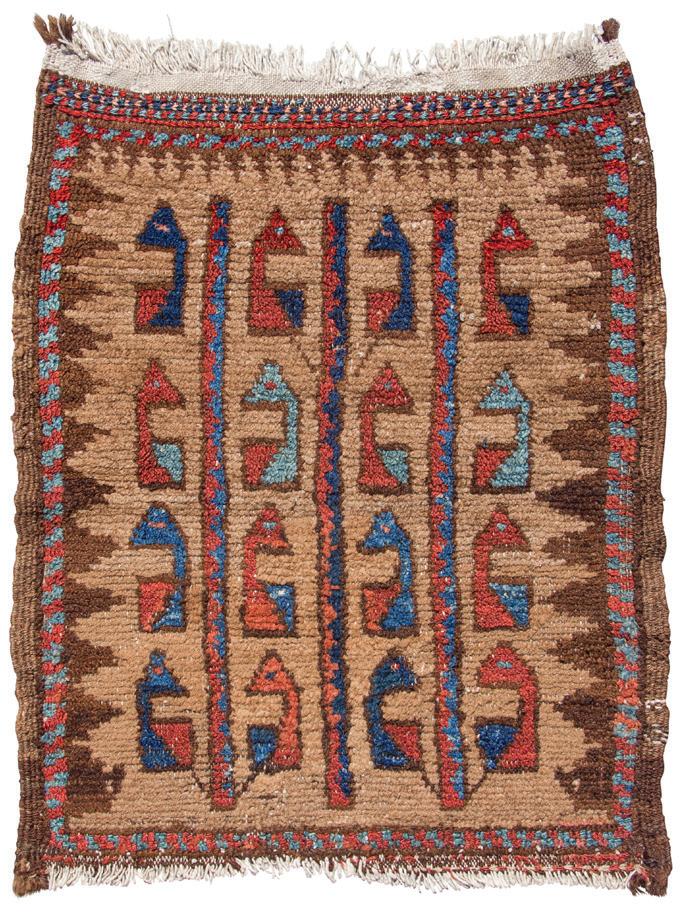

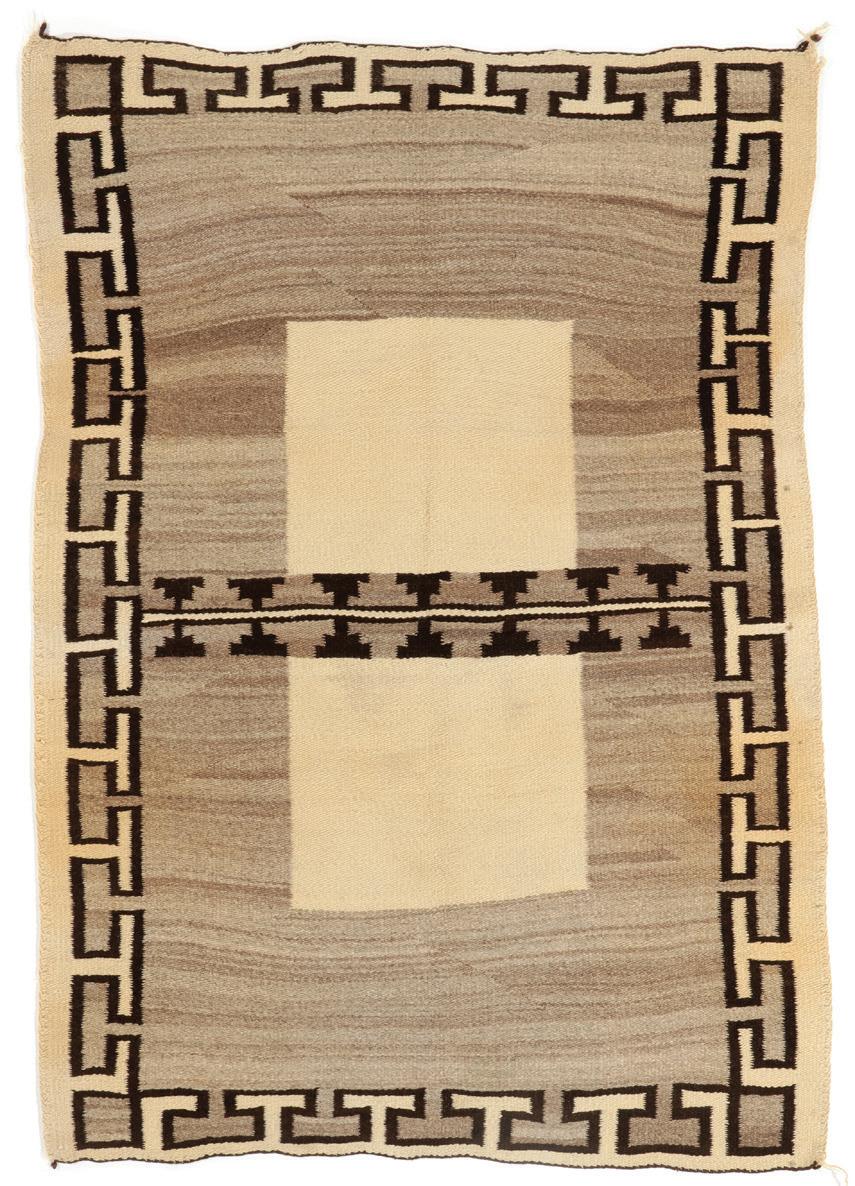
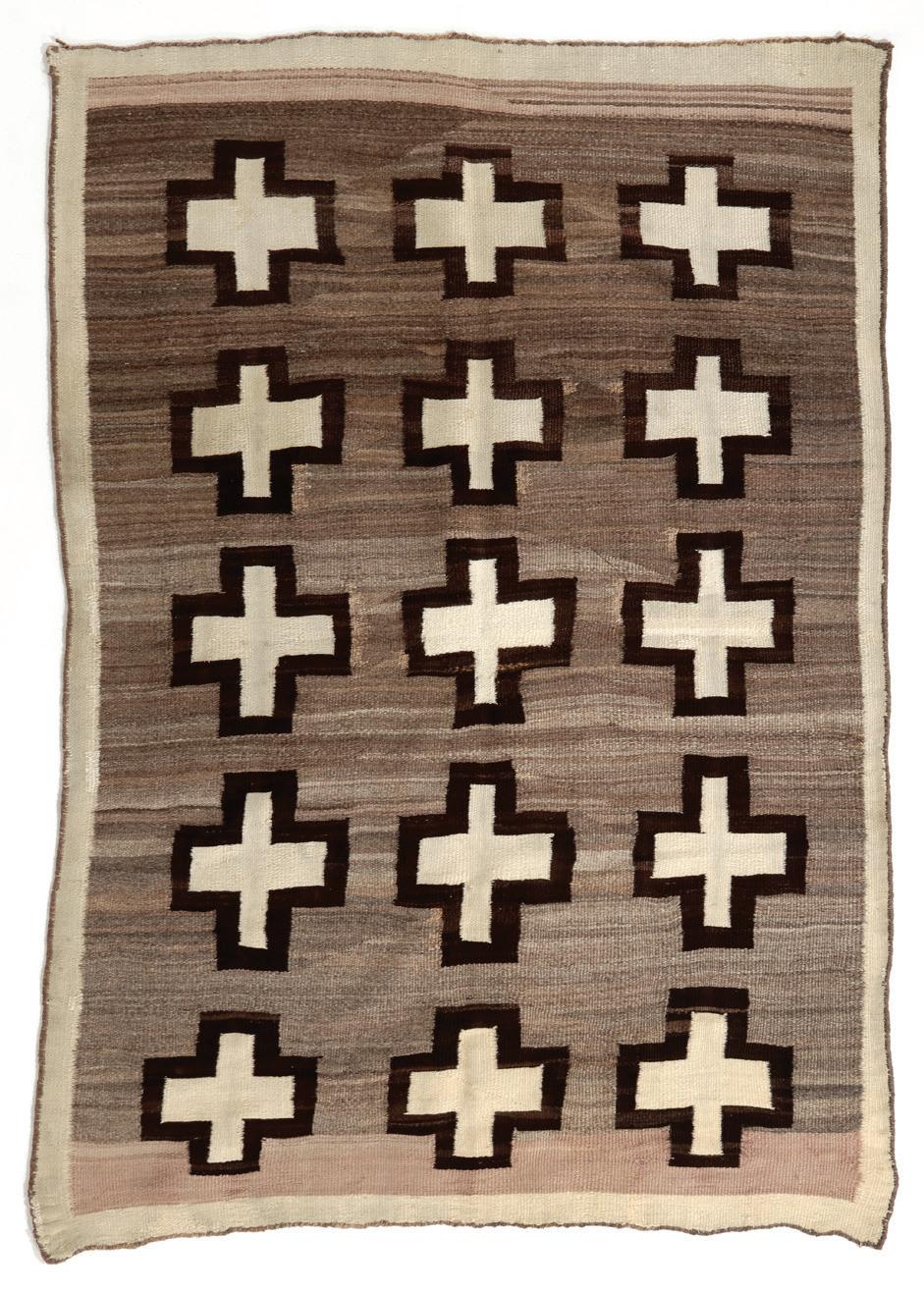


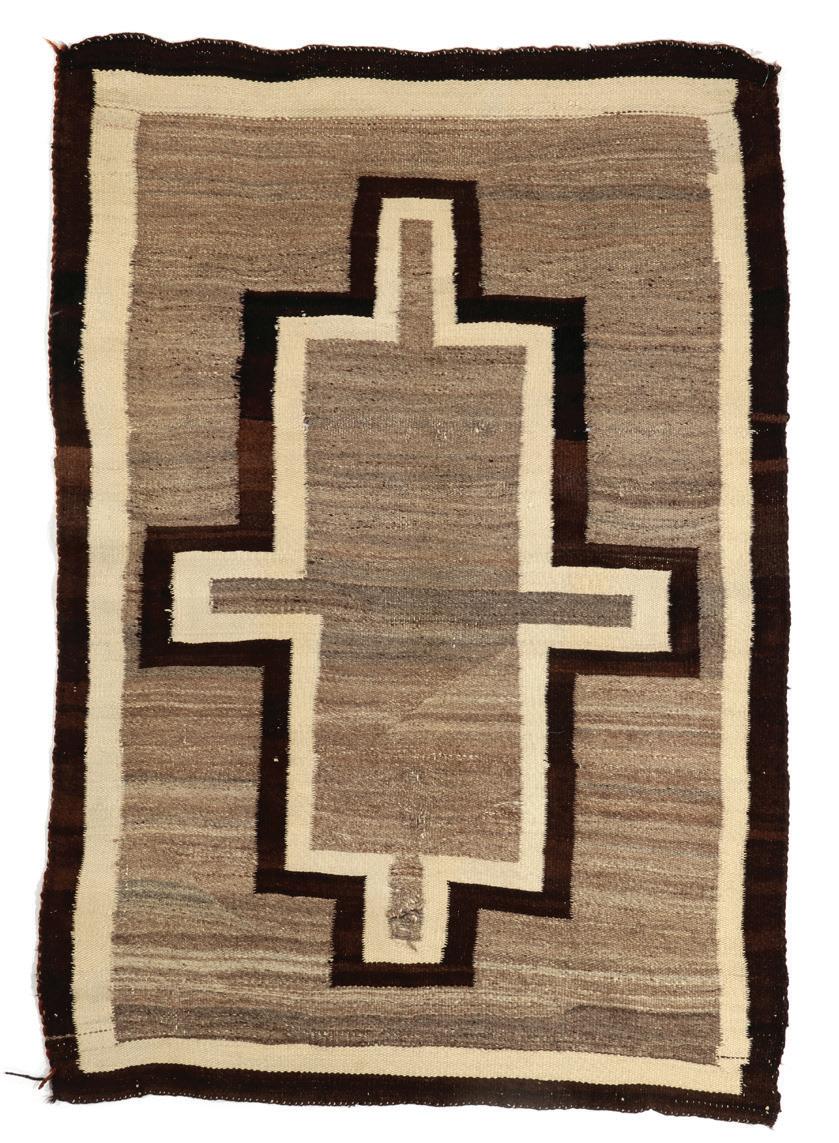
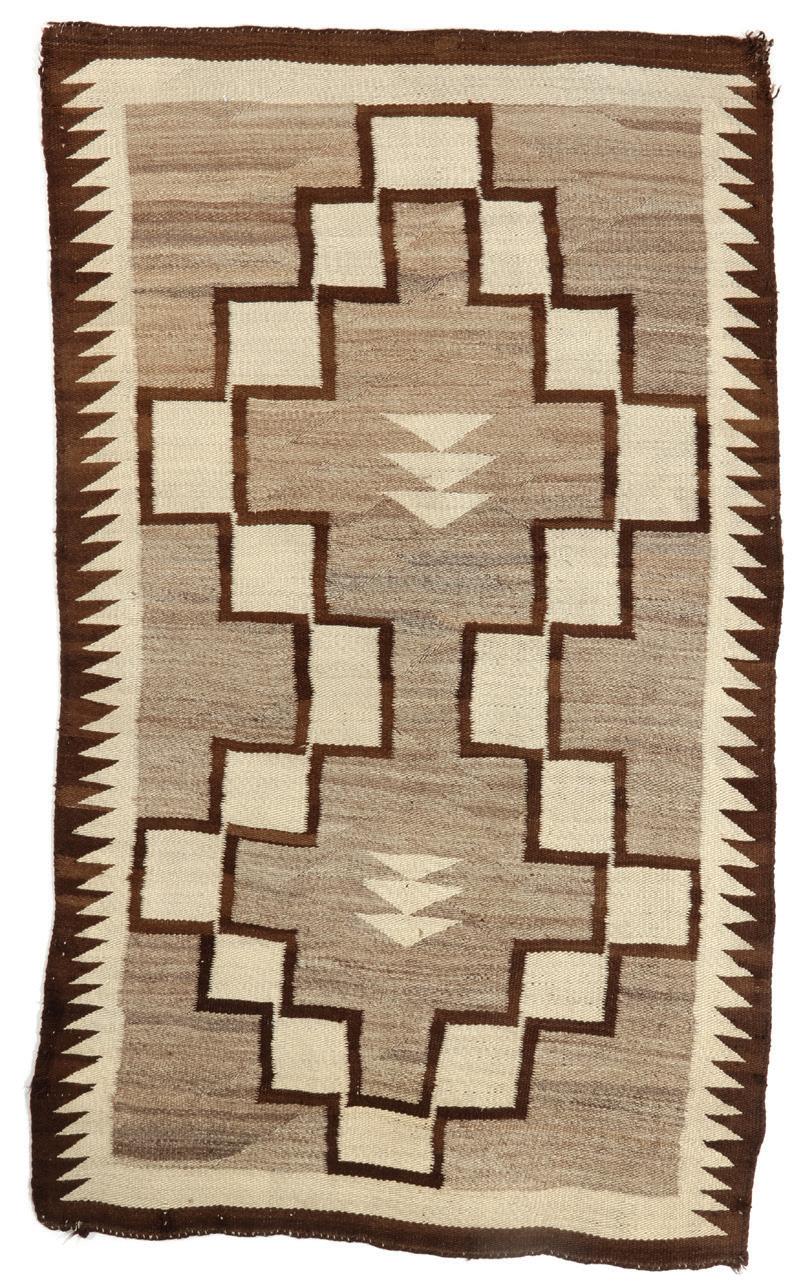
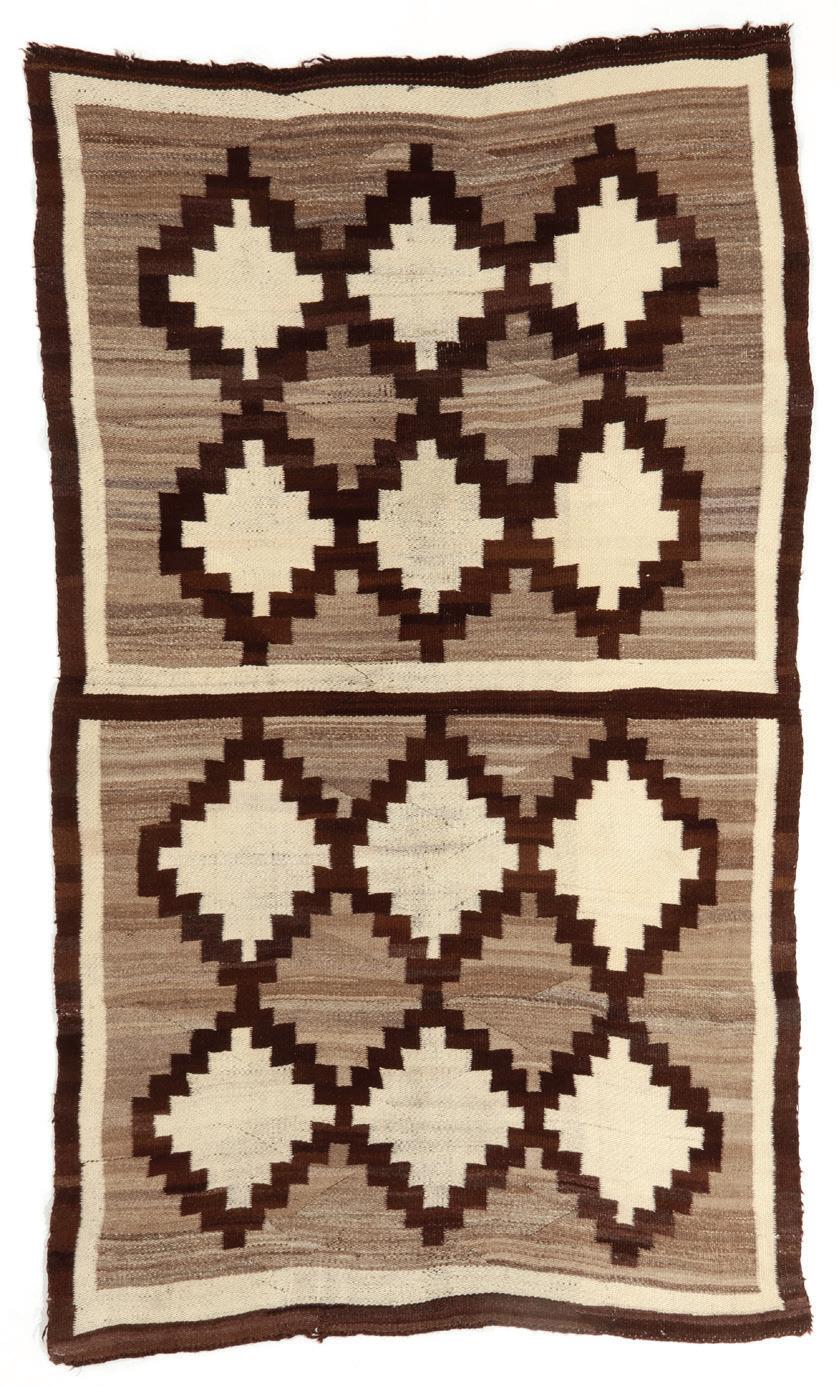




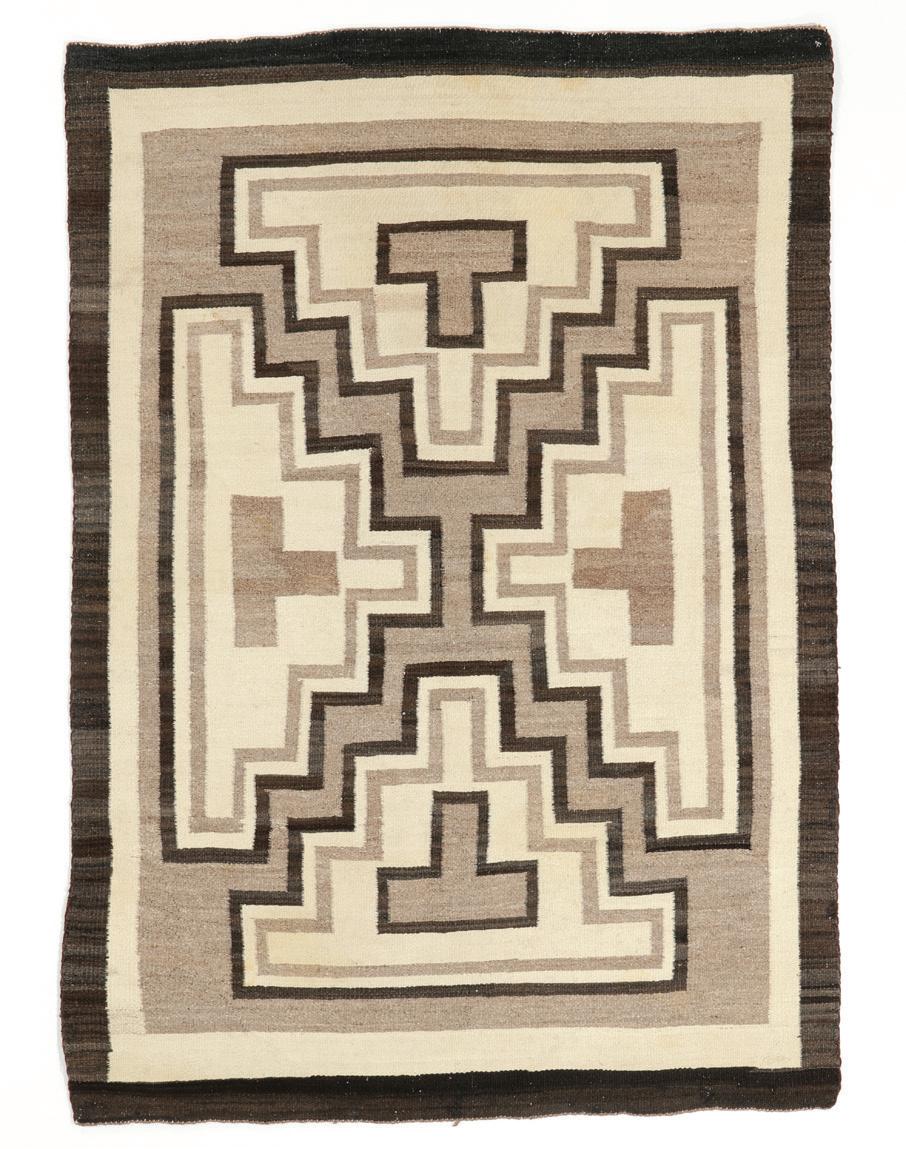
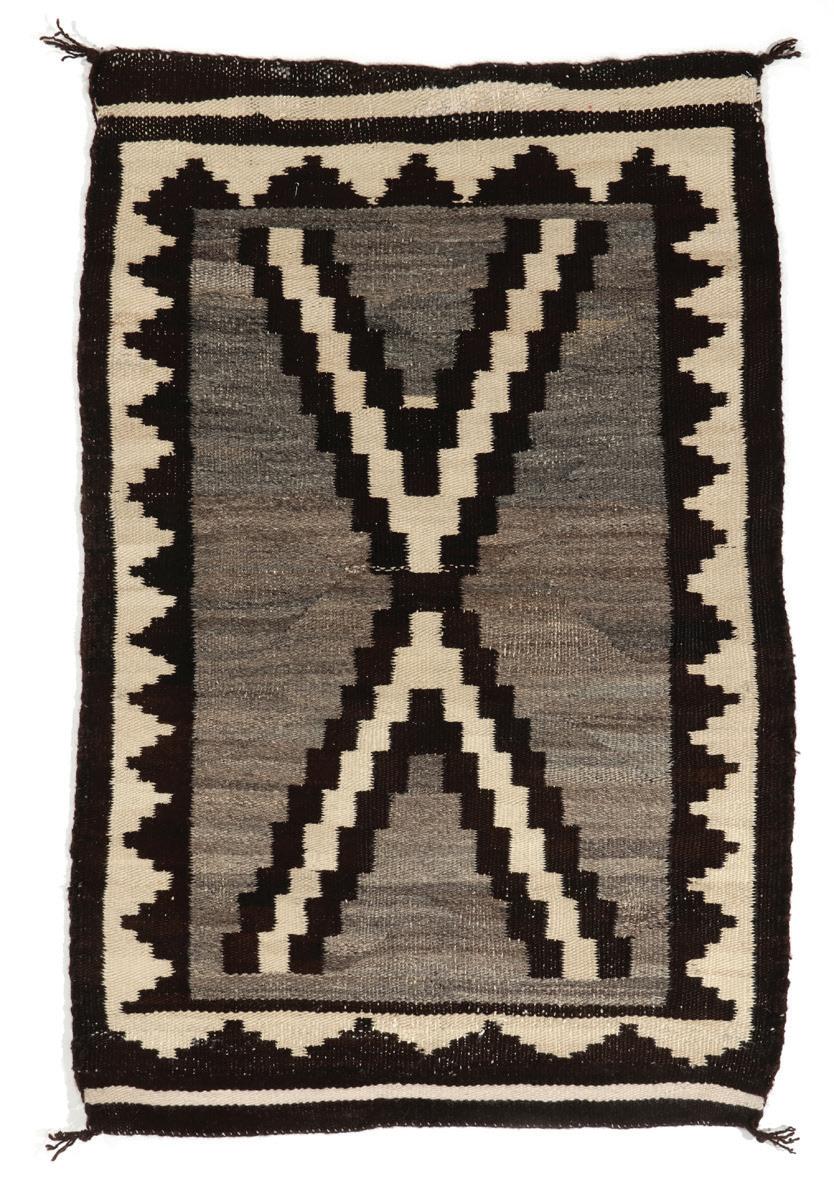

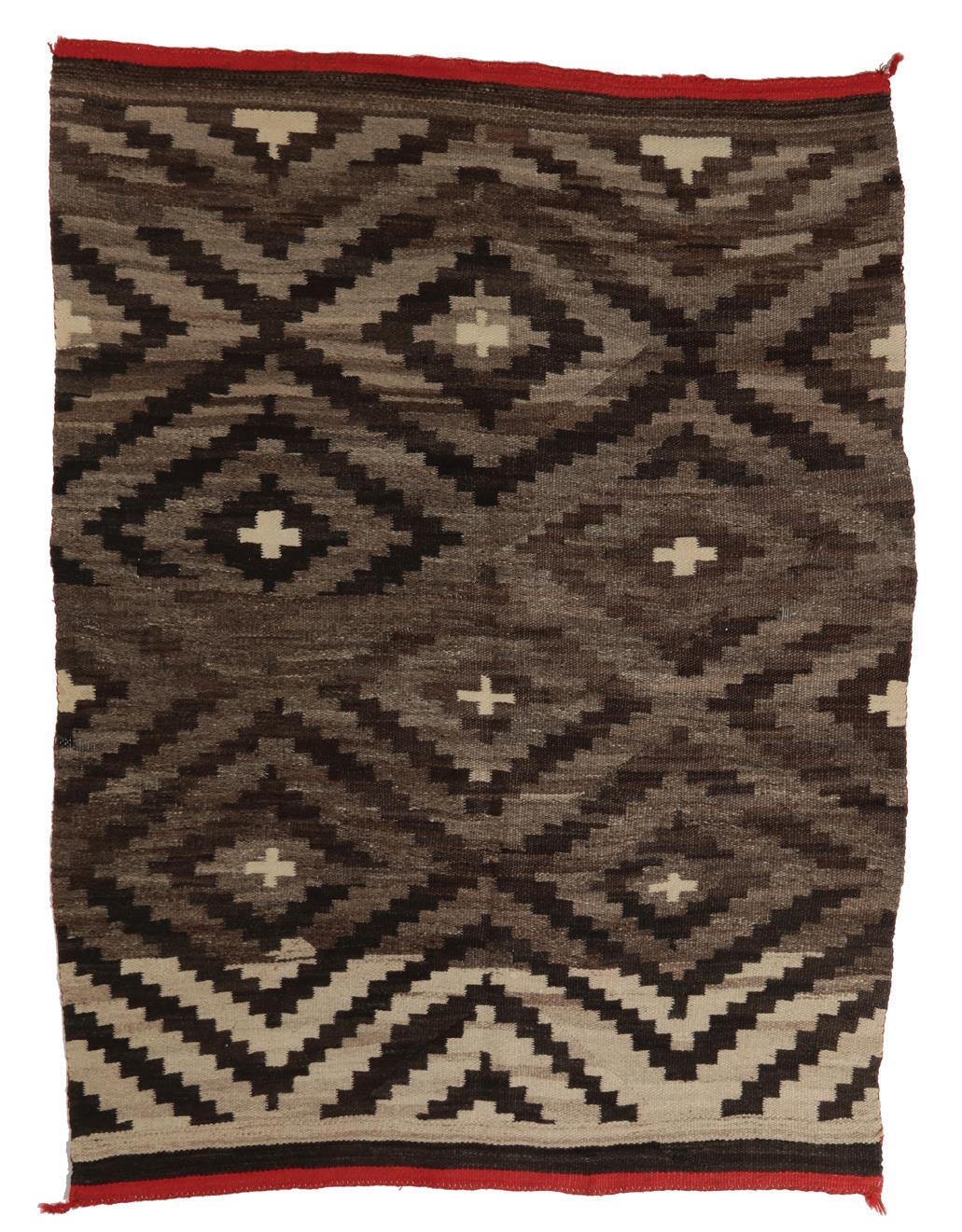

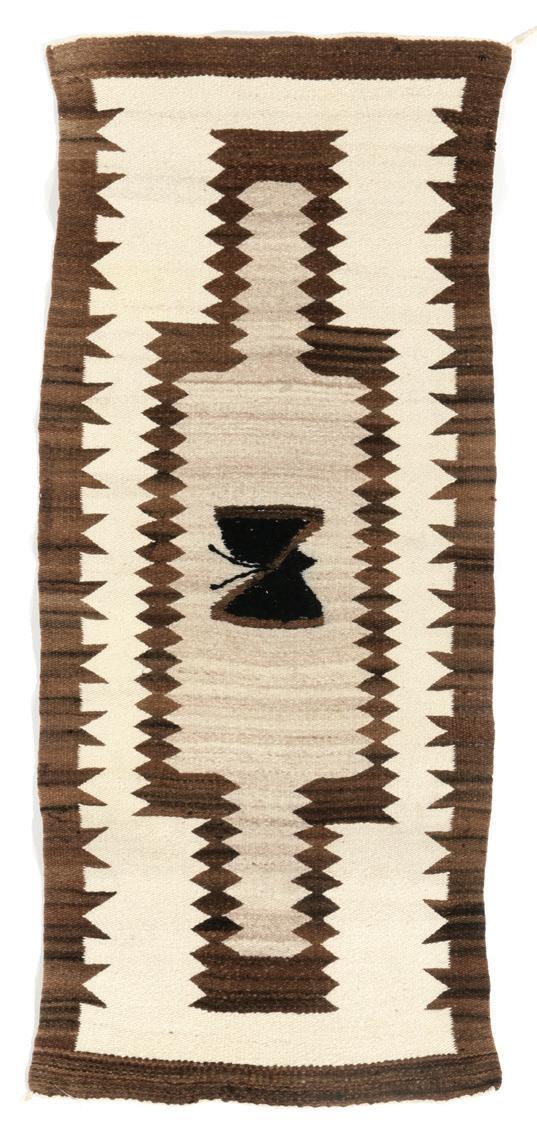

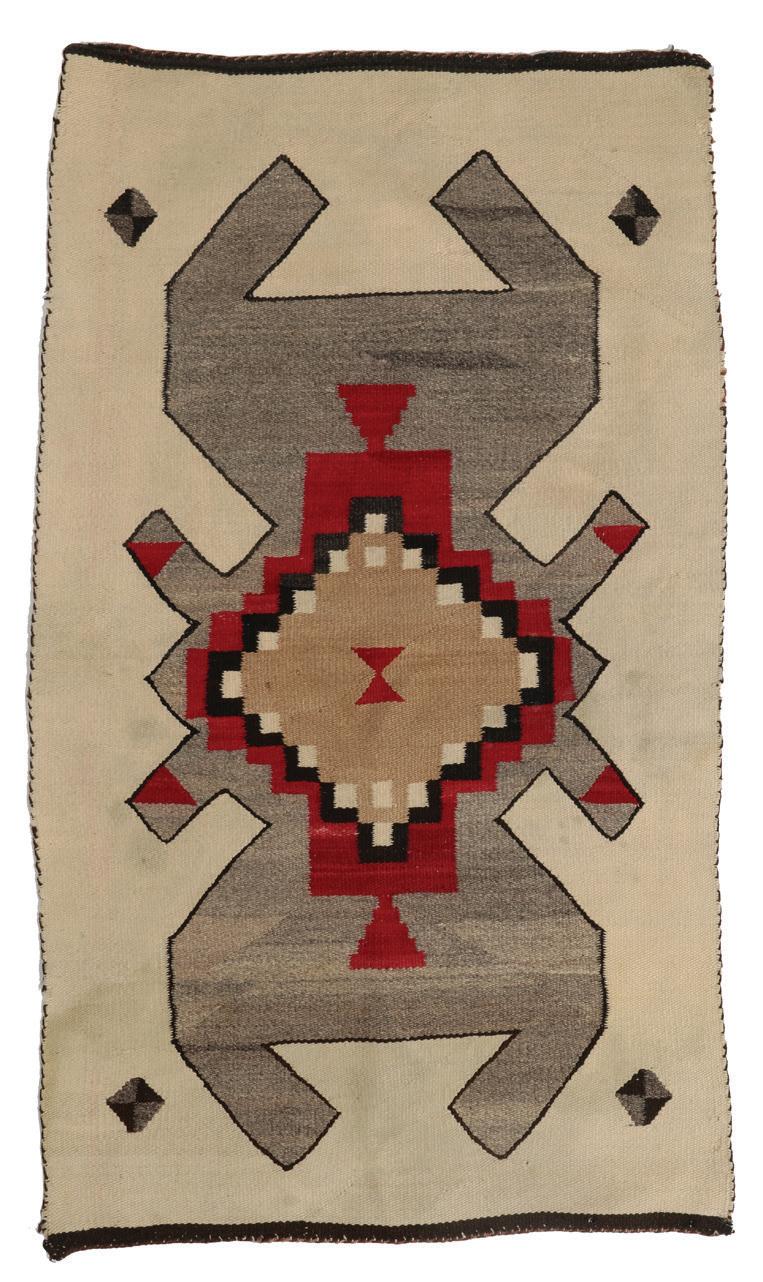

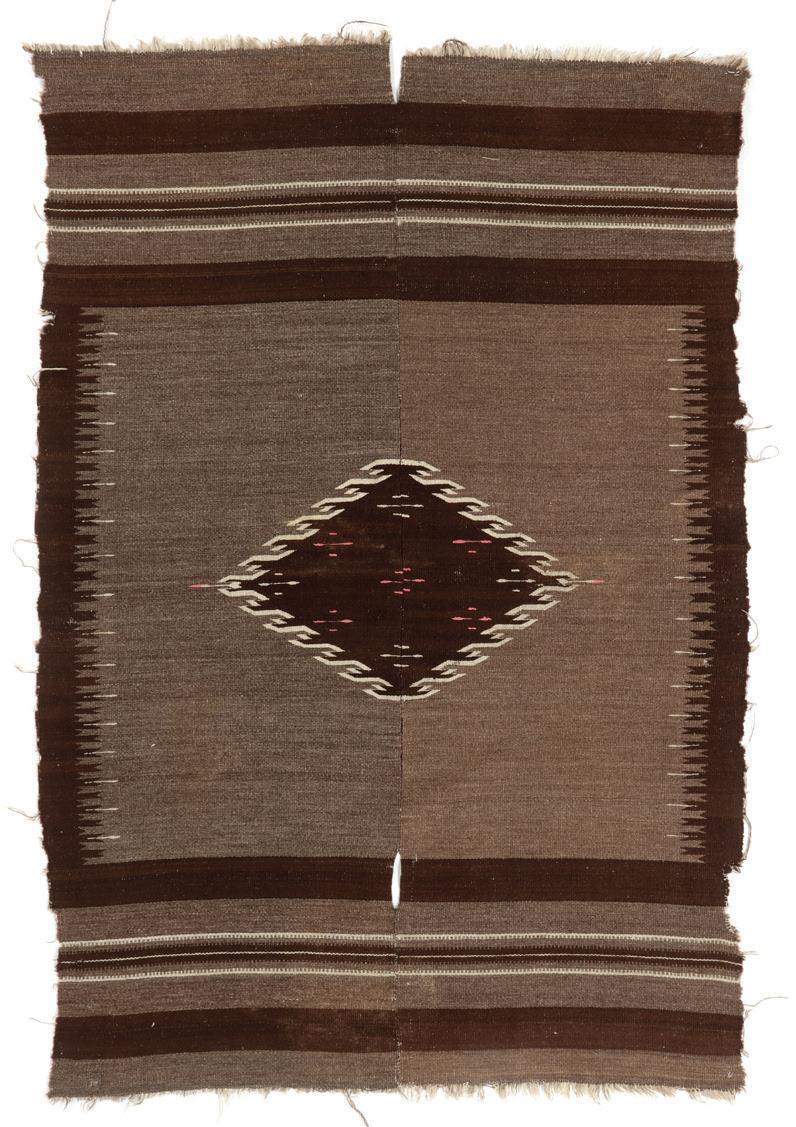
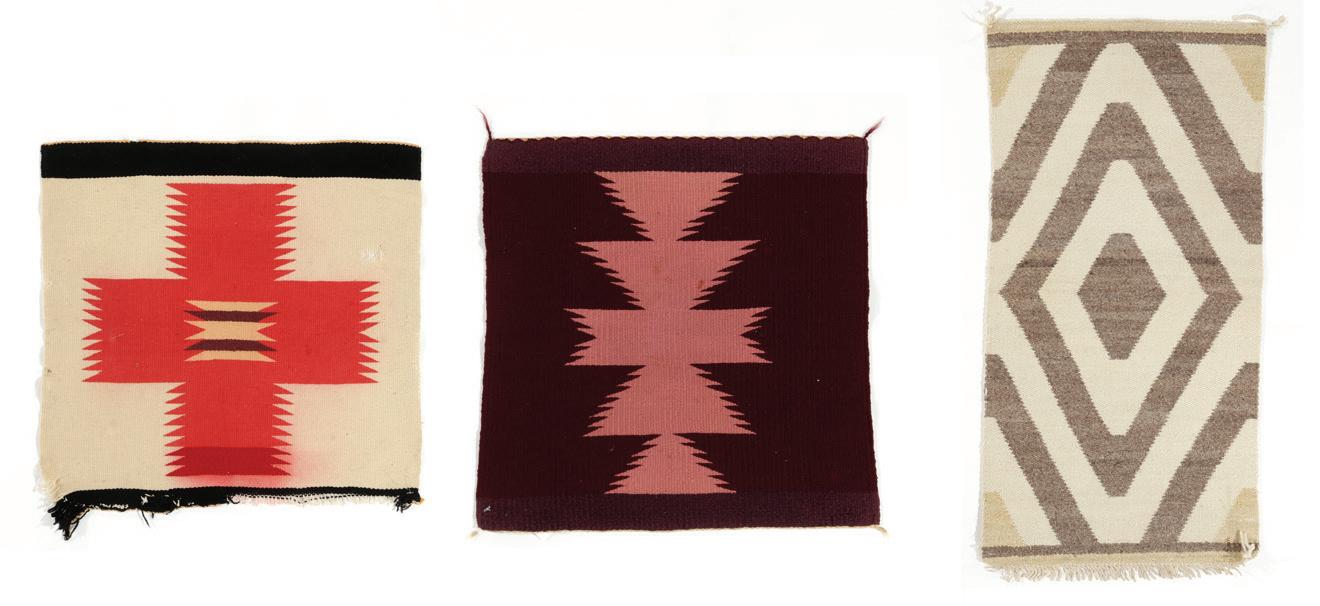

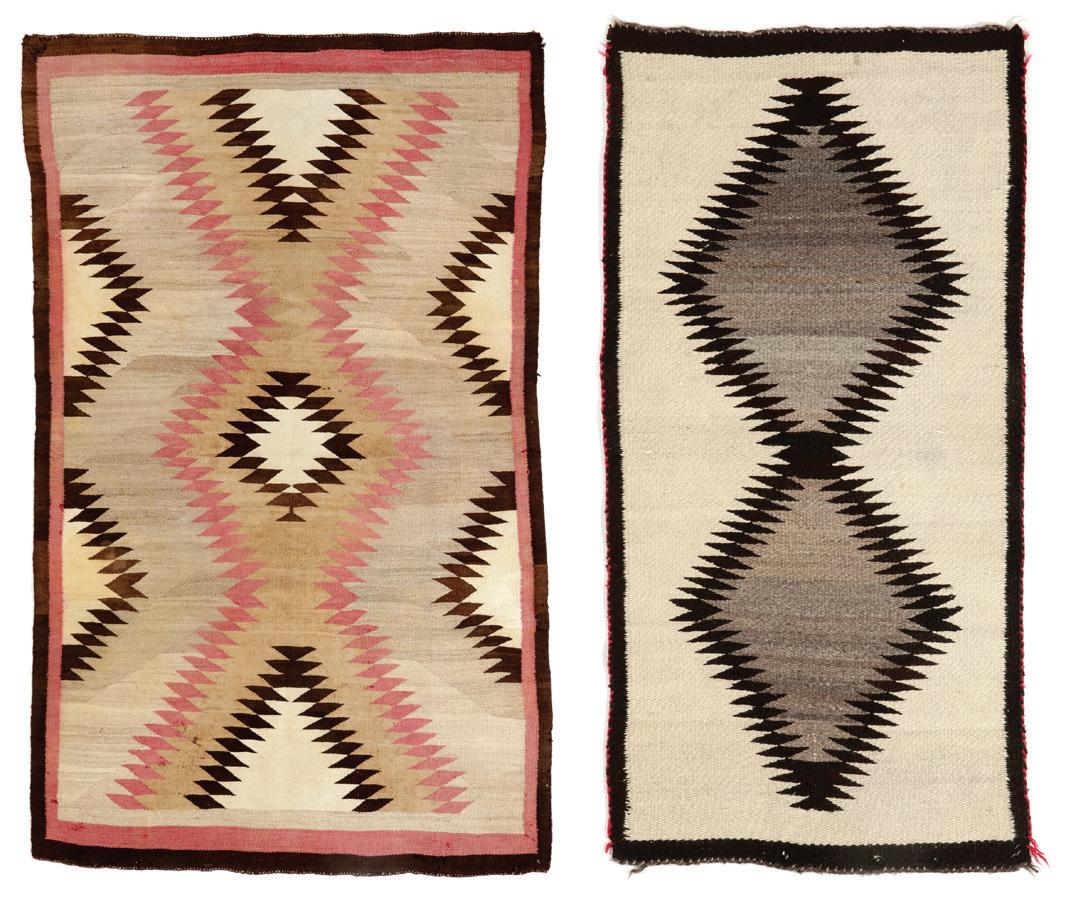
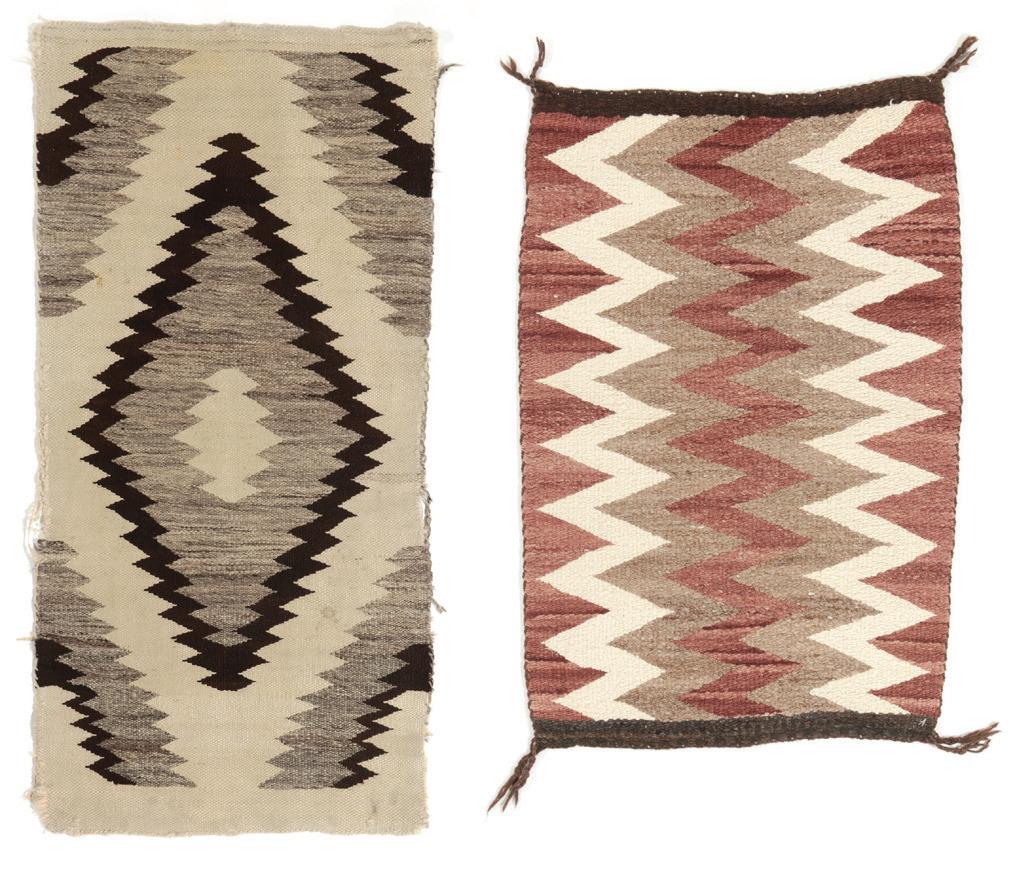
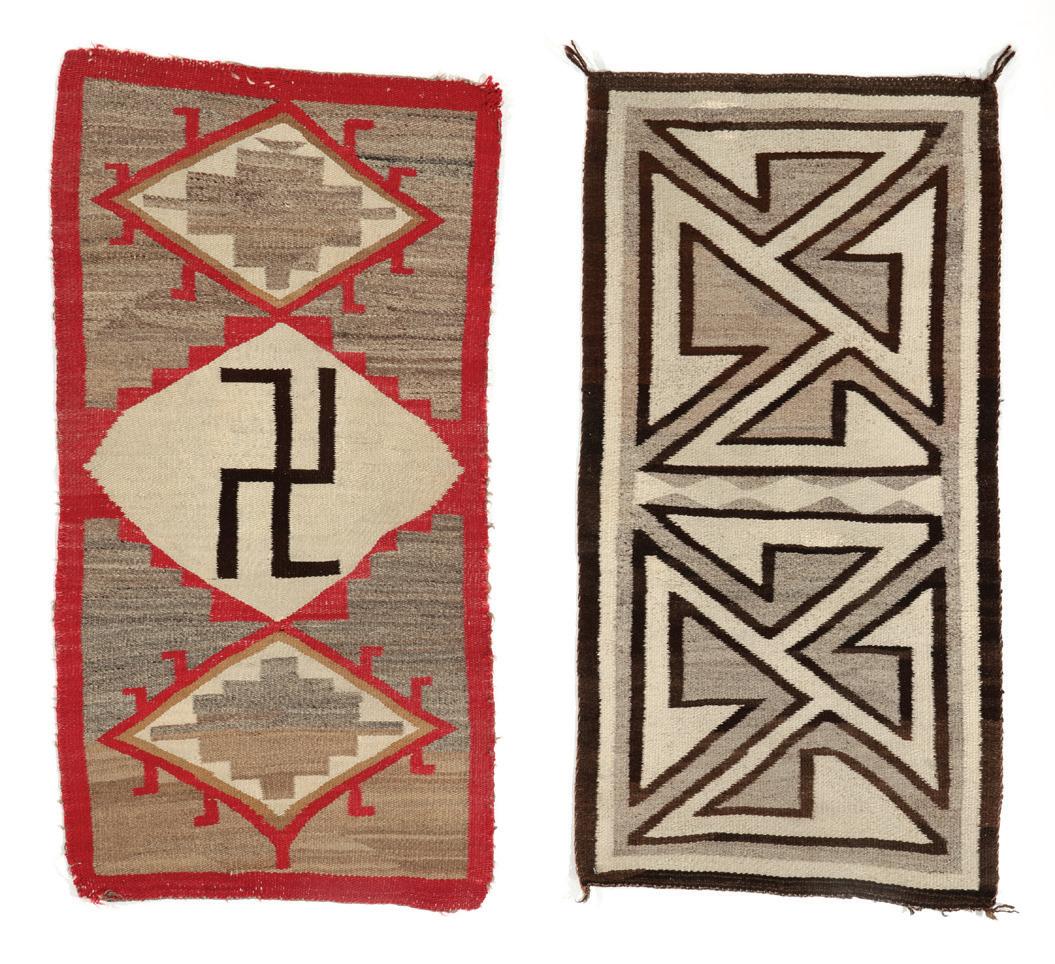
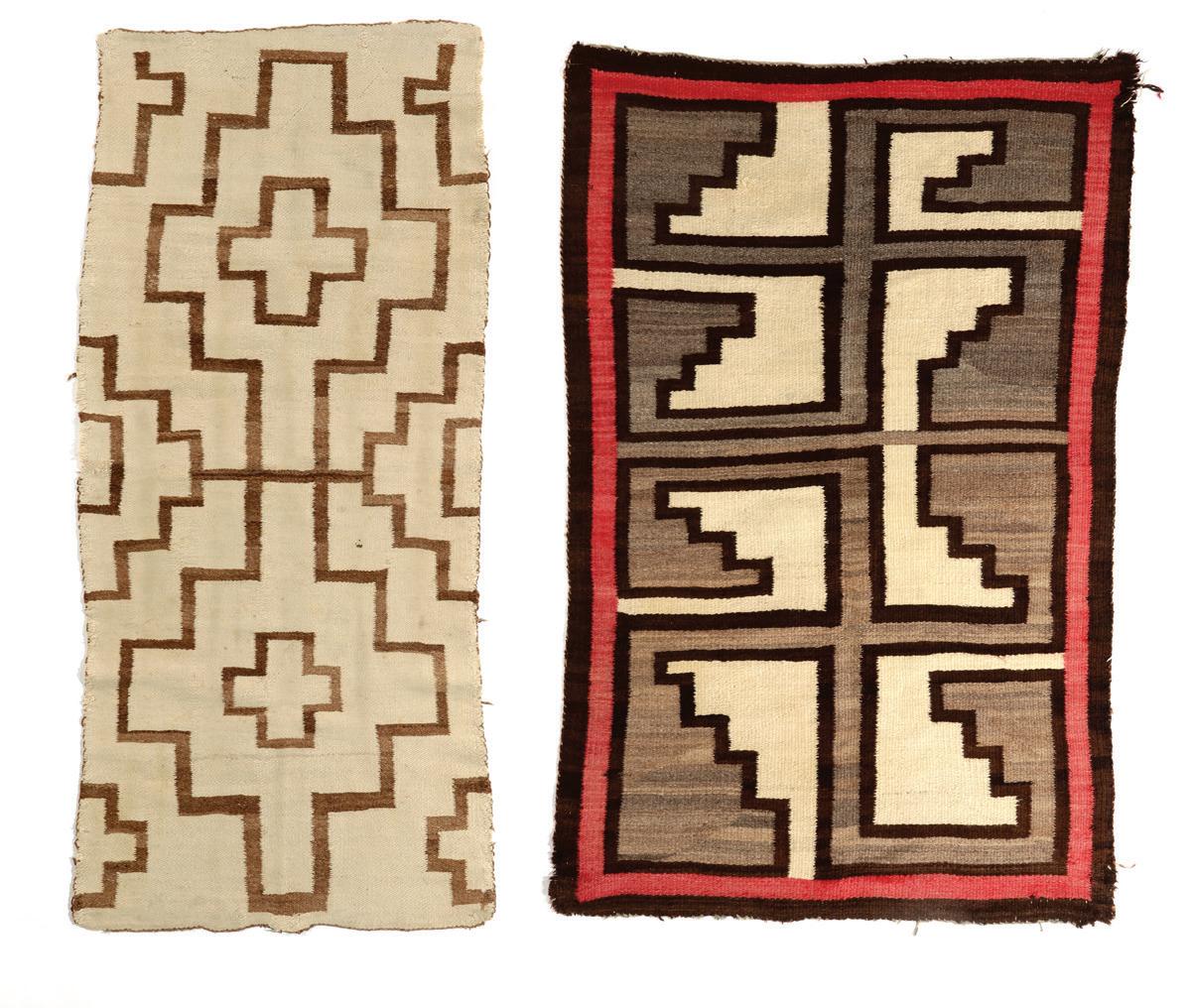

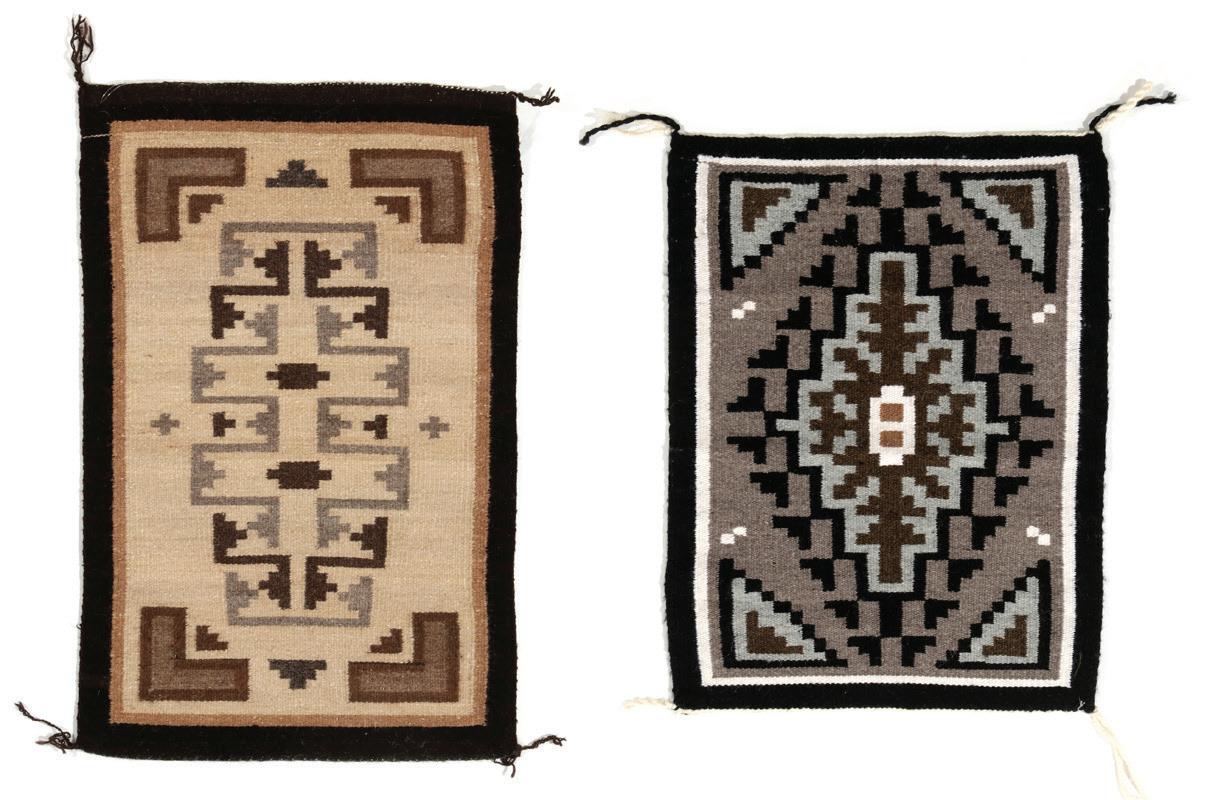

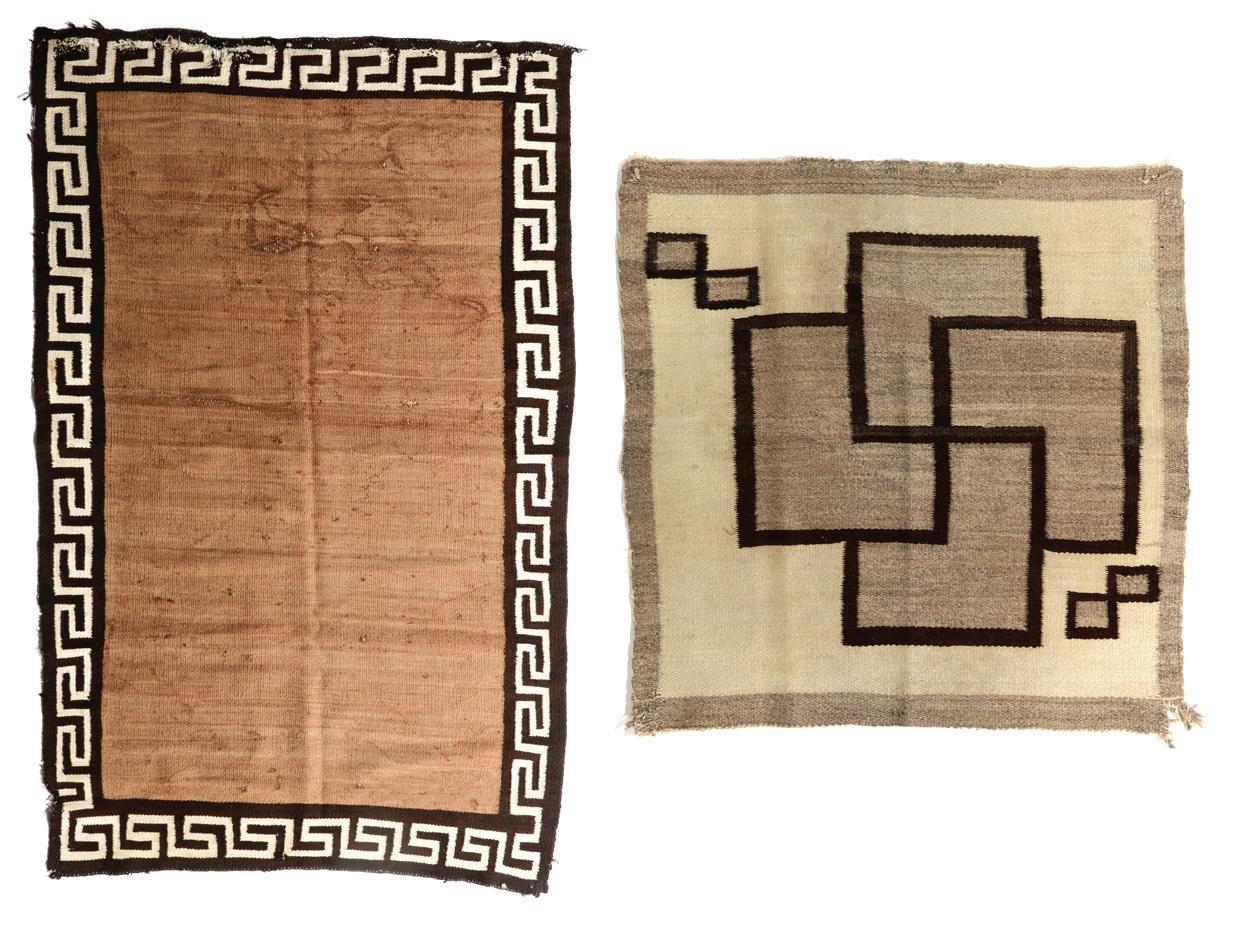



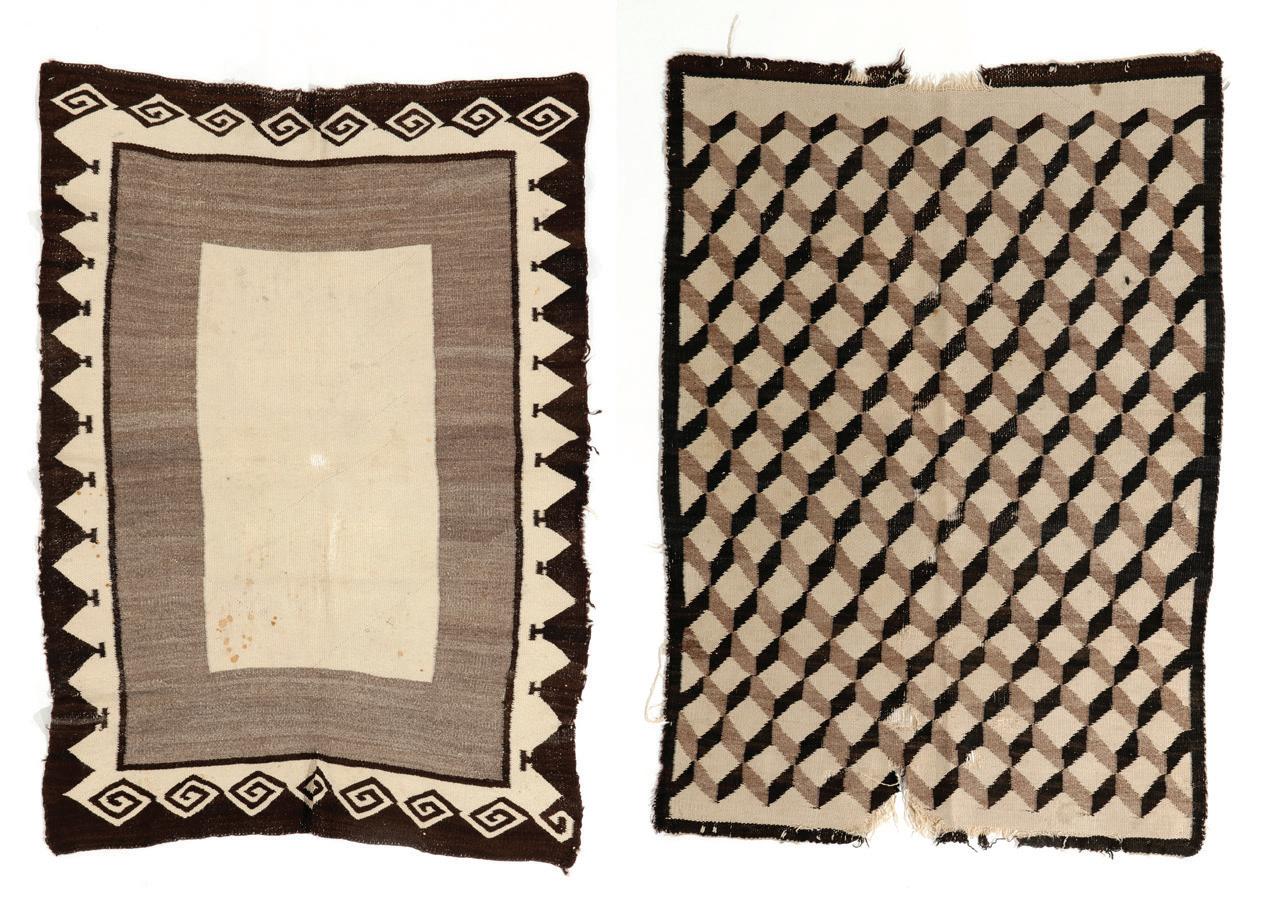
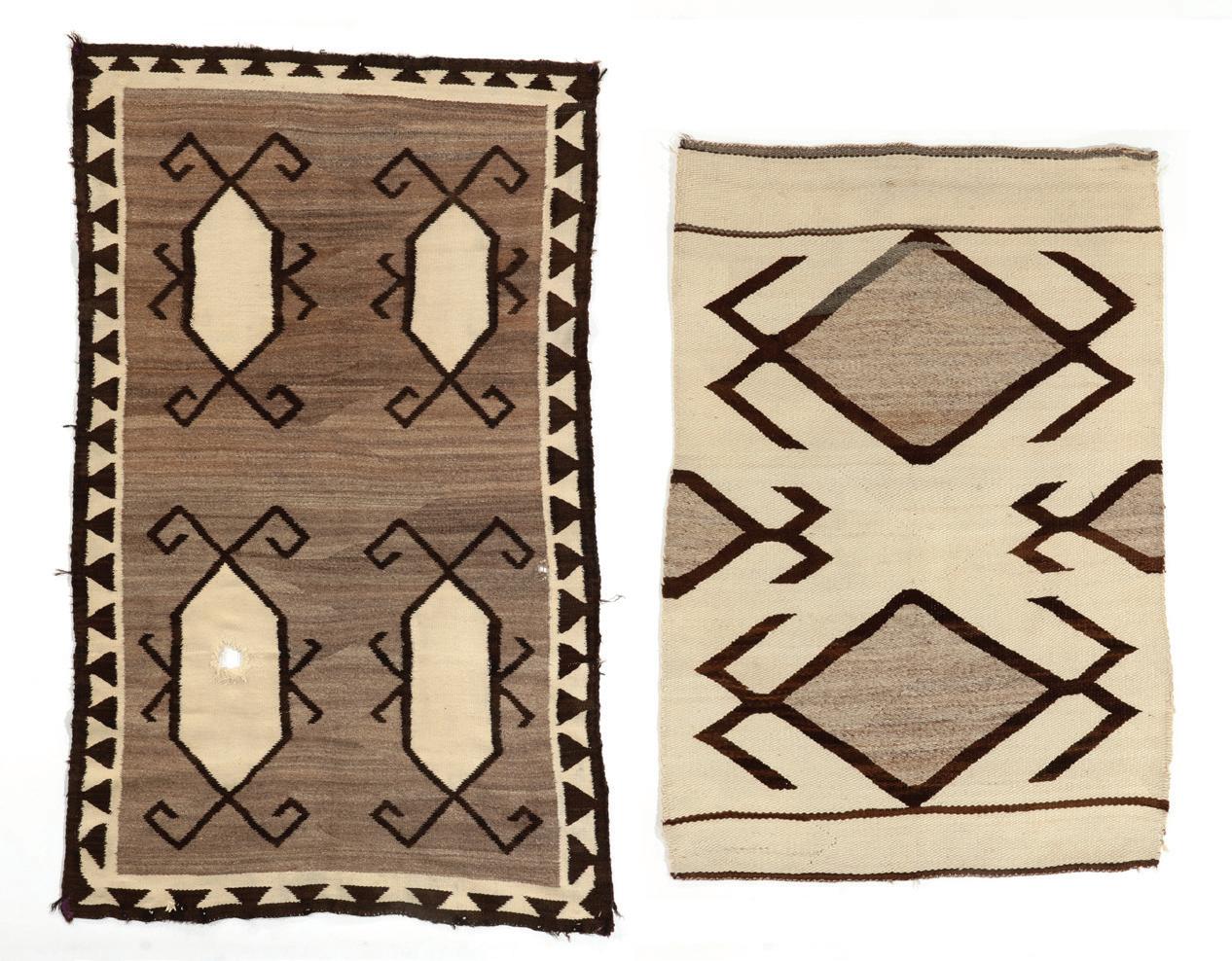
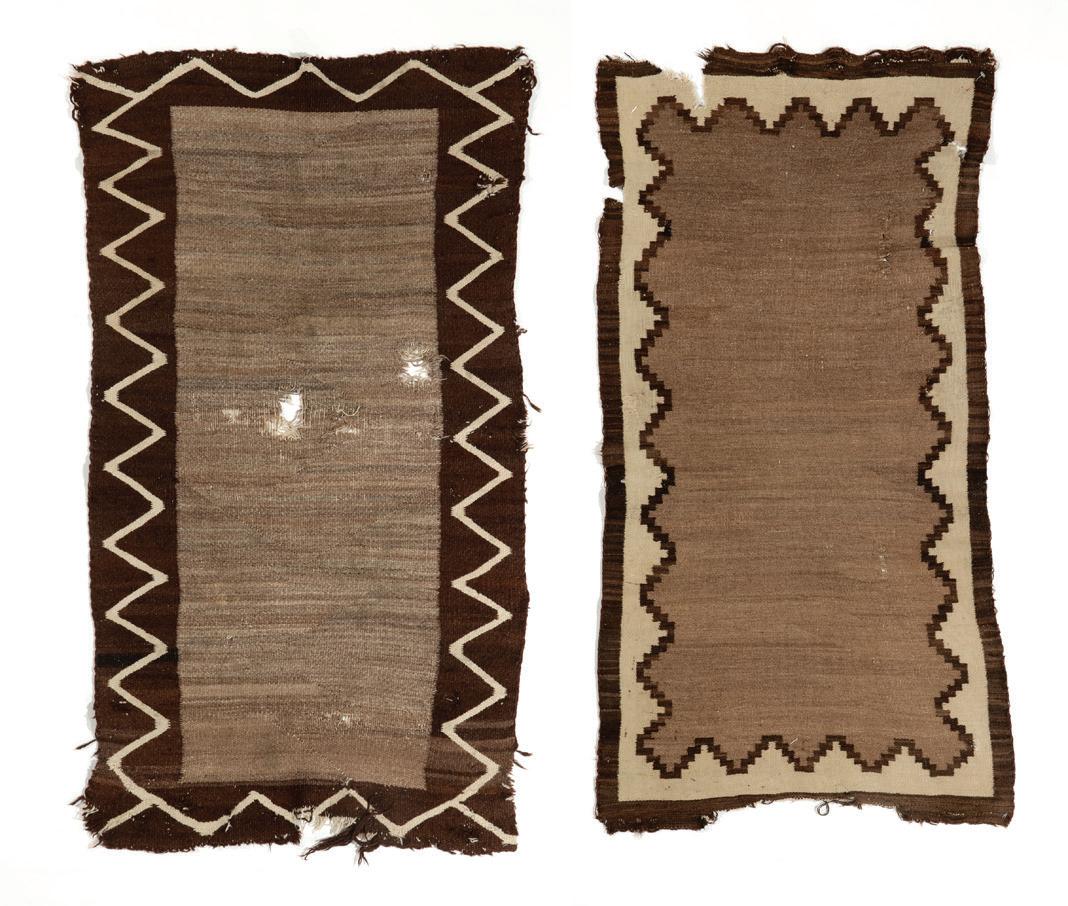

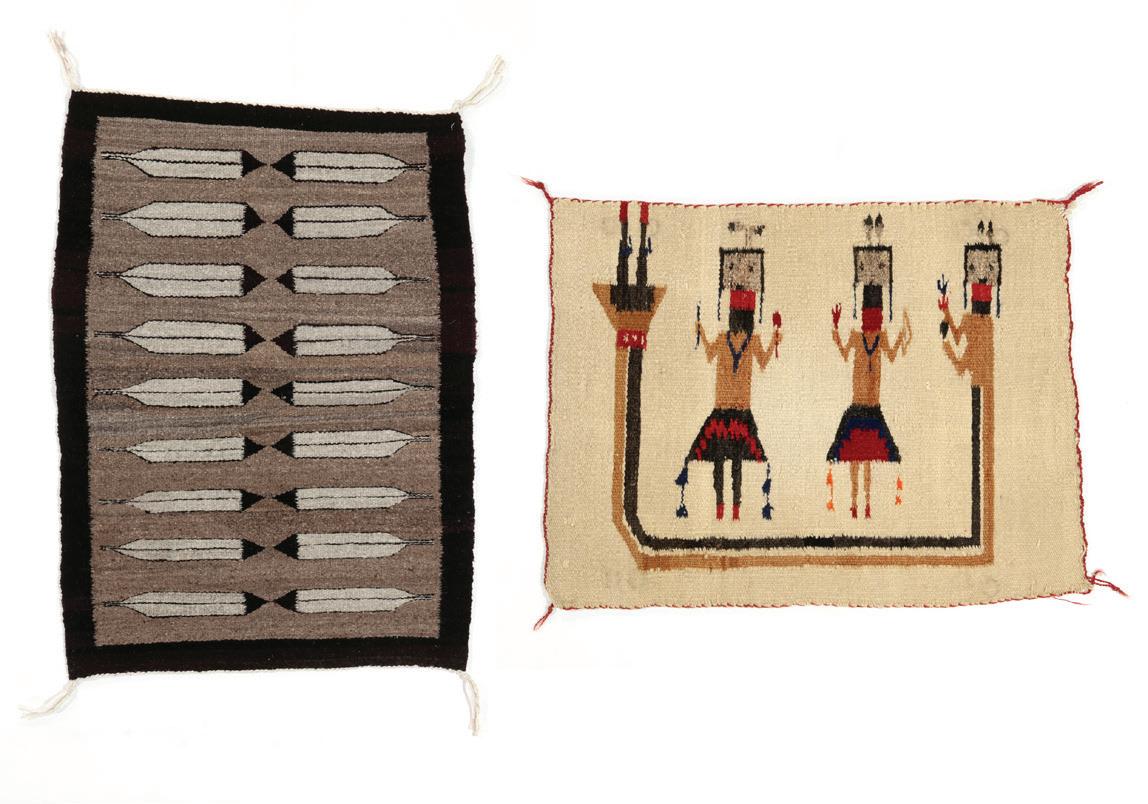




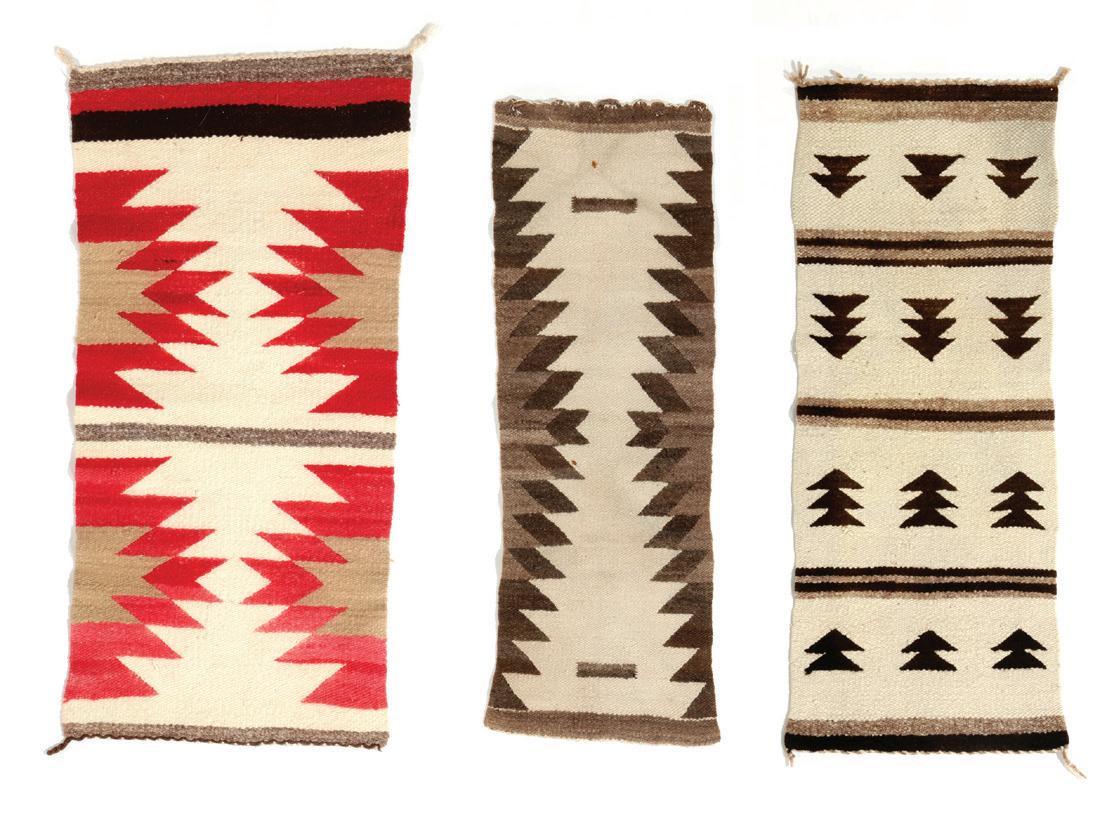
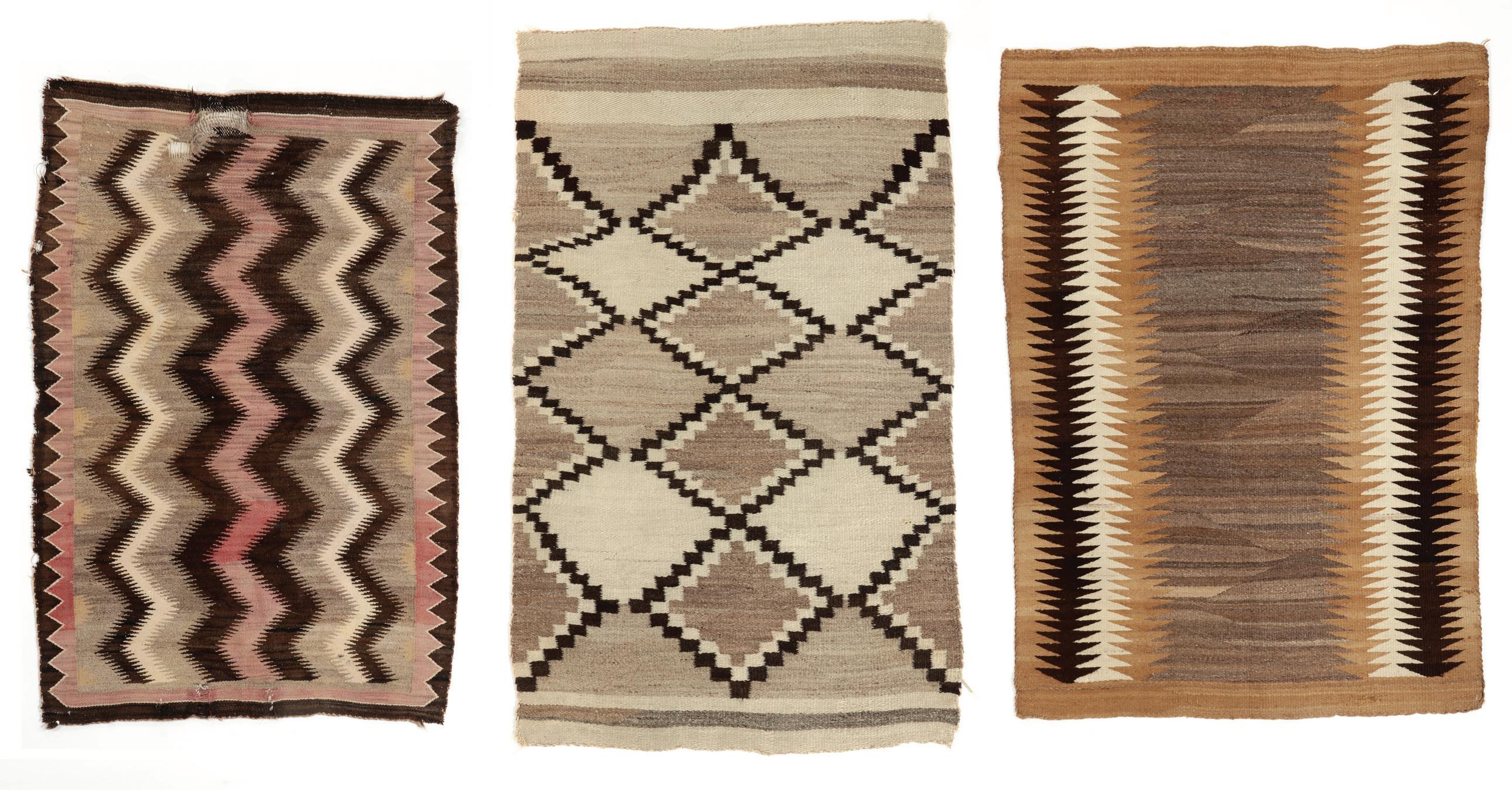



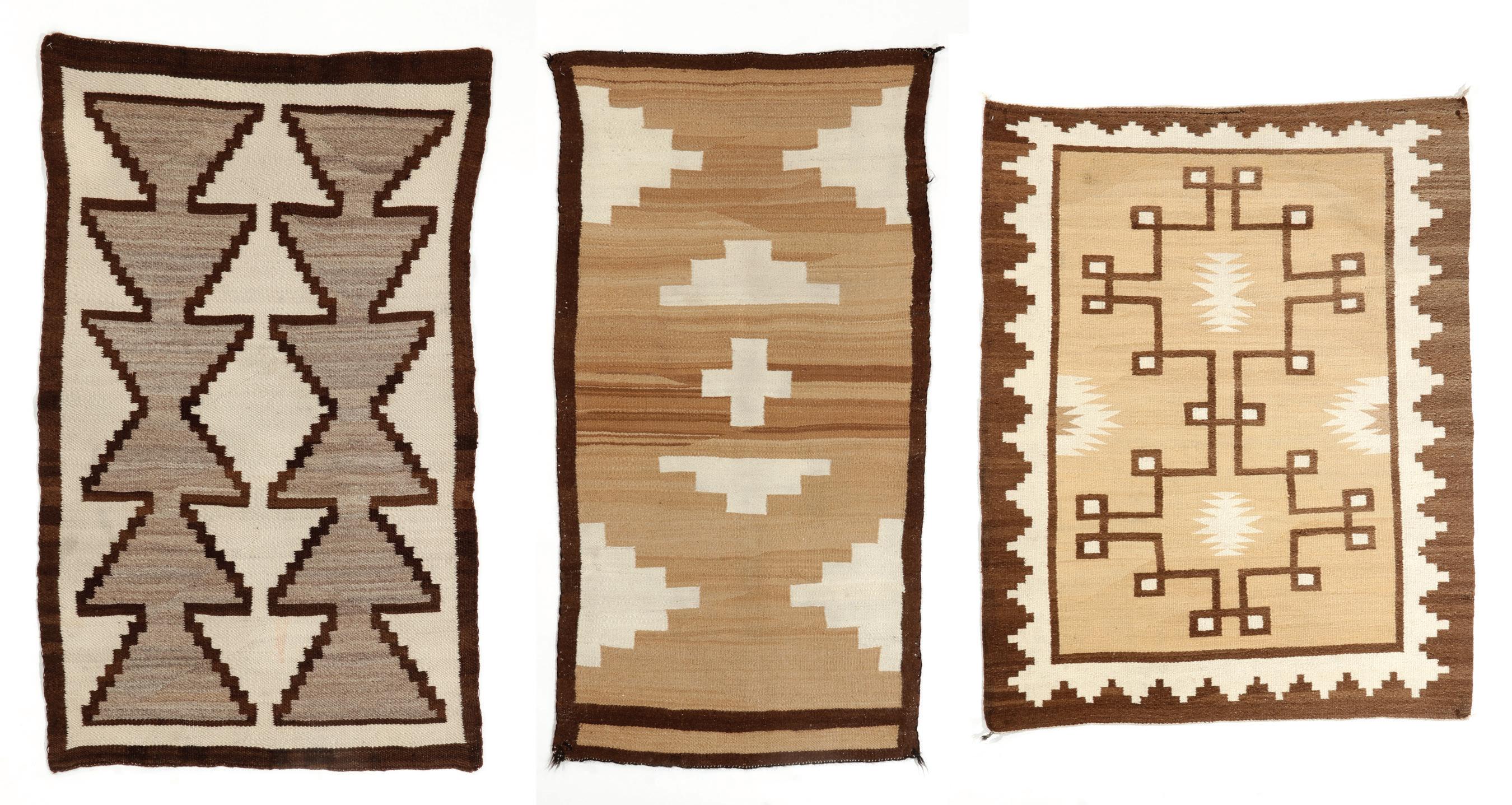

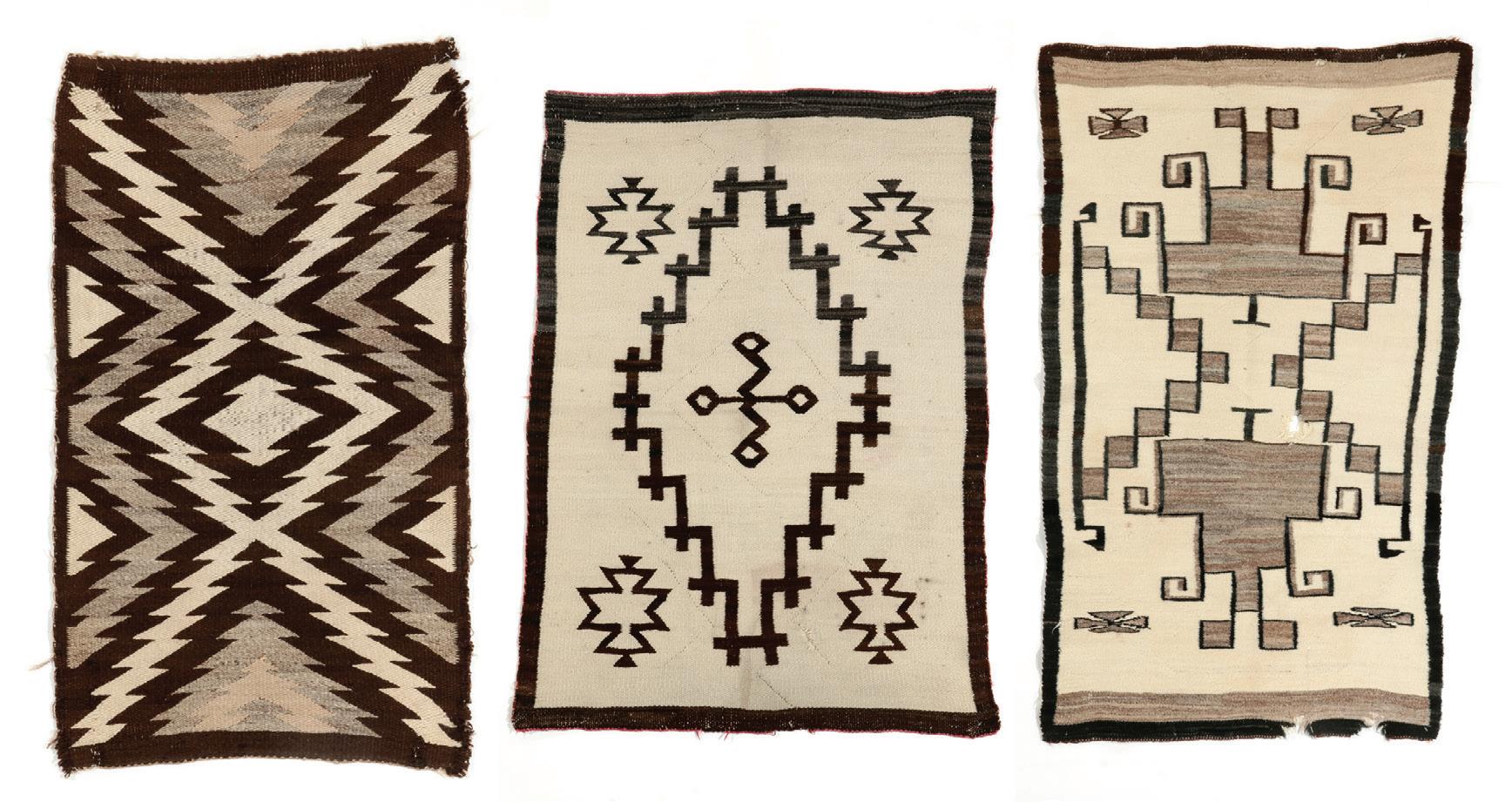


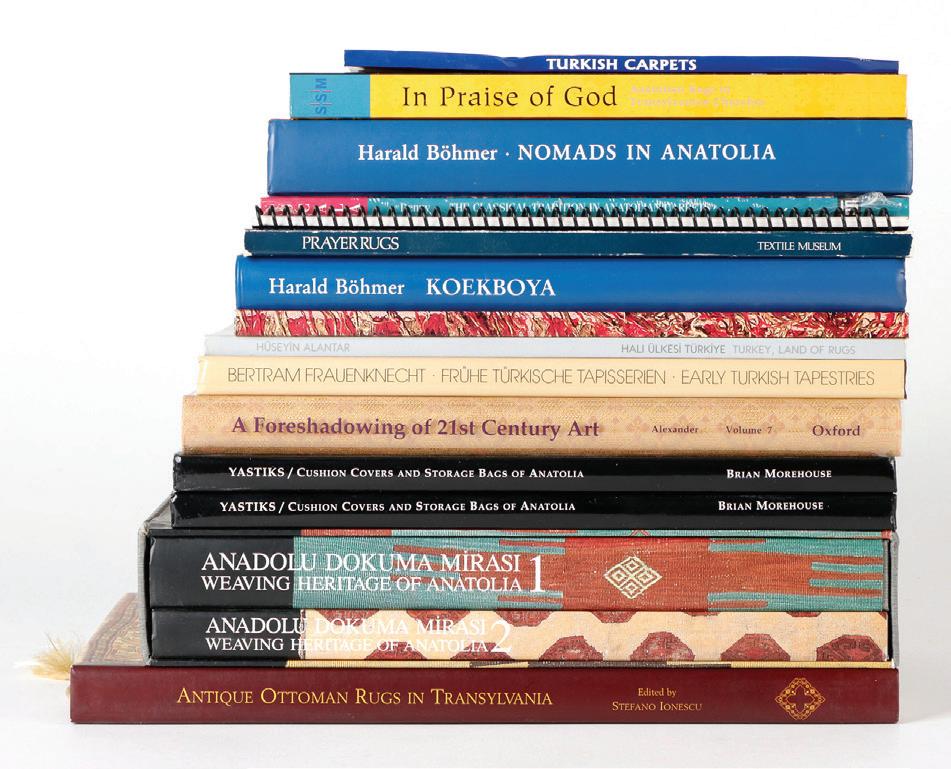


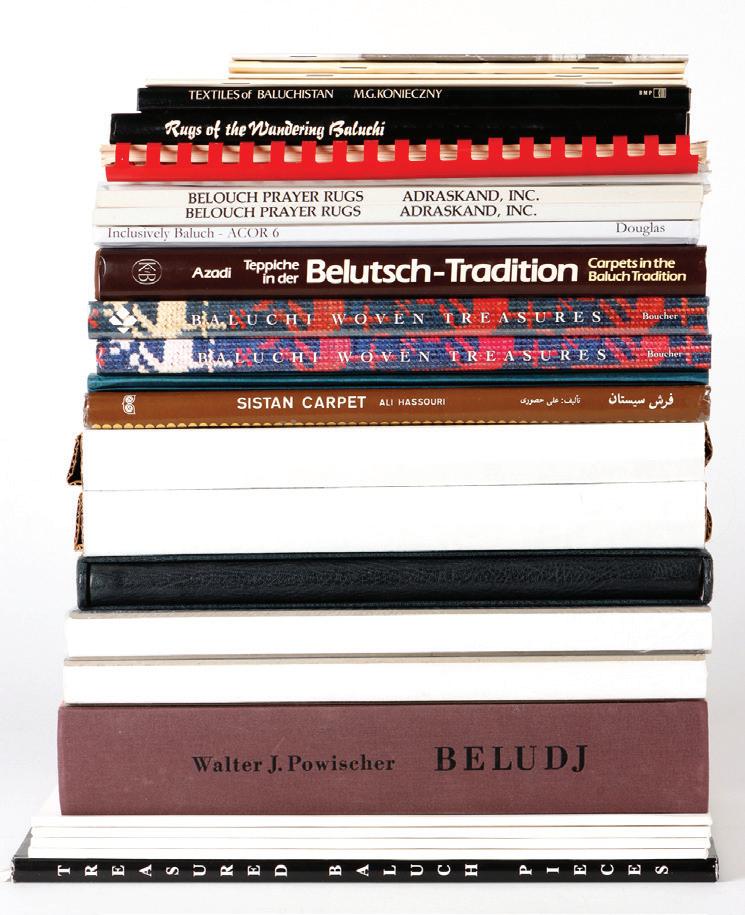



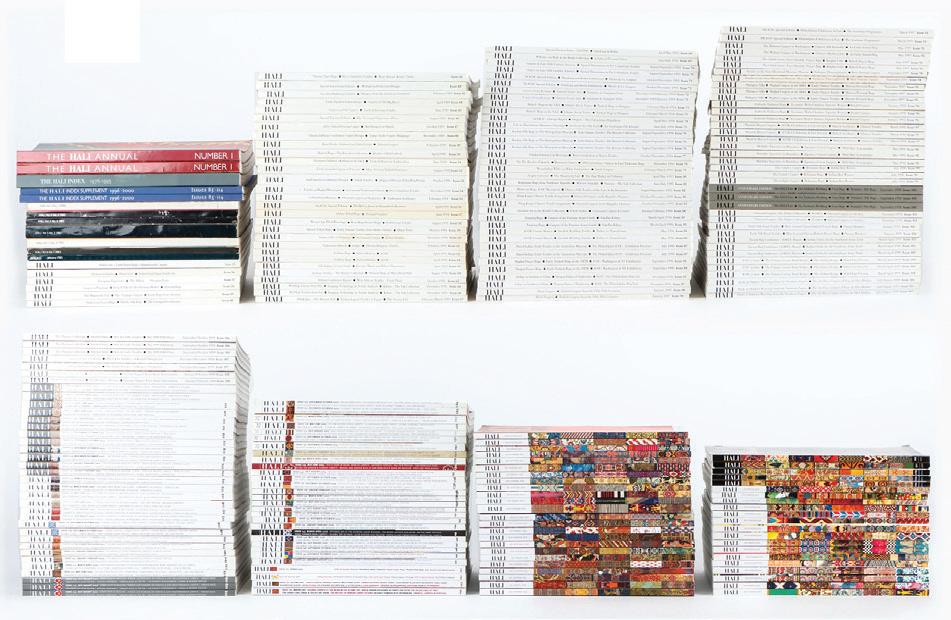

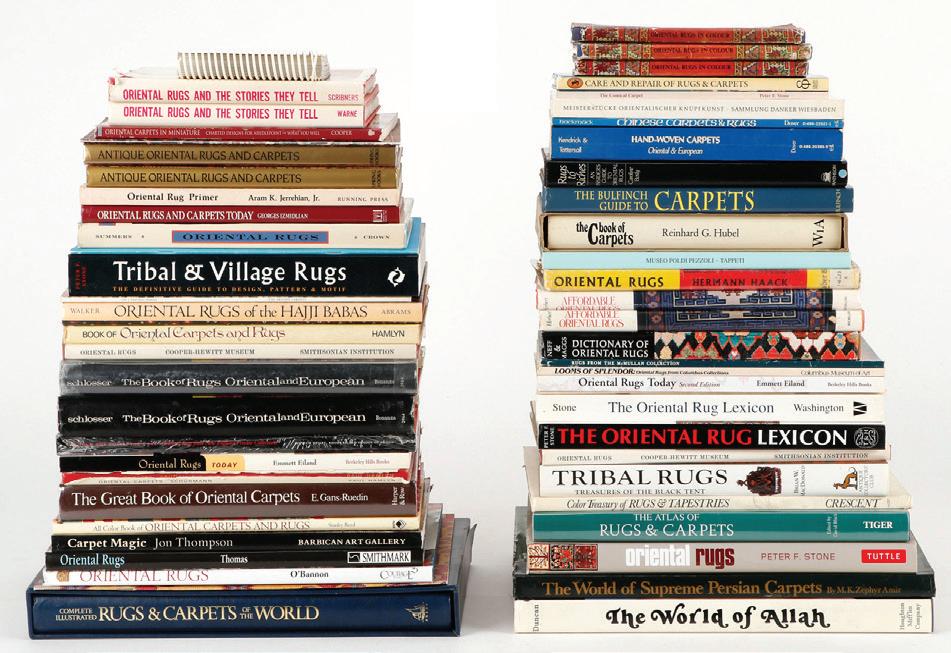


The property offered and sold through New Material Culture, Inc.’s (hereinafter MC) public auctions (hereinafter the Property) shall be offered and sold pursuant to the terms and conditions set forth below (hereinafter the Agreement). This Agreement constitutes the complete statement of the terms and conditions pursuant to which all Property is offered for sale. By bidding at the auction,whether in person, by agent, in writing, by telephone, internet bid or any other means, the buyer of the Property (hereinafter the Buyer) agrees to be bound by this Agreement.
PROPERTY SOLD AS IS. Except as expressly stated below in the LIMITED RIGHT OF RESCISSION, all Property is sold as is, where is, with all faults. Neither MC nor any consignor makes any guarantees, warranties or representations, expressed or implied with respect to the Property or the correctness of the catalogue or any other description of the Property. In no event shall MC or the consignor be responsible for the correctness, nor be deemed to have made any representation or warranty, of description, genuineness, authorship, attribution, provenance, period, culture, source, origin or condition of the Property. No statement made at the sale, or in the bill of sale, or invoice or elsewhere shall be deemed such a guarantee, warranty or representation.
LIMITED RIGHT OF RESCISSION. With regard ONLY to descriptions of fine art in which a specific artist is named as the artist, all information contained in the catalogue concerning the authenticity of said Property is guaranteed for a period of 30 days from the date of the sale. If, within that 30 day period, Buyer has complied with all Terms and Conditions of Sale regarding timely payment and collection of said Property and would like to dispute the authenticity of said Property, Buyer can submit, at his own expense, two written professional opinions regarding authenticity by recognized authenticators, jointly approved by both MC and Buyer. In the event said Property is judged inauthentic by both expert authenticators, said Property may be returned if it is in the same condition as at time of sale and the Buyer’s full purchase price will be refunded. Refunds shall not include cost of transportation, insurance or other expenses that Buyer may have incurred. This limited right of rescission is available only to the original auction Buyer and does not extend or transfer to any subsequent owner, heir, agent transferee or any other third party.
WITHDRAWAL OF PROPERTY. MC reserves the right to withdraw any Property at any time for any reason and to default any sale in the event of an error or dispute.
COPYRIGHT AND REPRODUCTION RIGHTS. MC and its consignors make no warranty or representation, express or implied, that the Buyer will acquire any copyright or reproduction rights to any Property sold. MC expressly reserves the right to reproduce any image of the Property sold in the catalogue. The copyright in all images, illustrations and written material produced by or for MC relating to Property, including the contents of the catalogue, is, and shall remain at all times, the property of MC and shall not be used by the Buyer, nor by anyone else, without MCs prior written consent.
EXAMINATION OF PROPERTY. All Property is available for examination prior to bidding. The Buyers bidding signifies that the Buyer has examined the Property as fully as desired or has chosen not to examine the Property. MC recommends that prospective bidders examine all items in which they have an interest prior to bidding.
RESERVES. Some of the Property in the sale is offered subject to a reserve. The reserve is a confidential minimum price agreed upon by the consignor and MC below which the lot will not be sold. In most cases, the reserve will be set below the estimated range, but in no case will it exceed the low estimates listed. Bidding will begin at a price appropriate in the auctioneers discretion. The auctioneer always reserves the right to withdraw Property for any reason he deems appropriate.
ORDER OF BIDS. Unless otherwise announced by the auctioneer, all bids are per lot as numbered in the catalogue. MC reserves the right to determine any and all matters regarding the order, precedence or appropriate increment of bids or the constitution of lots. Please be aware that MC accepts bids from various sources including online bidding platforms, phone bidders, floor bidders, and online and in-house absentee bidders. The auctioneer will accept bids in the order they are received during the course of the live auction. Absentee bidders please take note: in situations where there is more than one party bidding on a lot when the bidding stops, you risk losing the lot to another buyer, depending on the order the bids are received by the auctioneer during the course of the live auction. The safest way to ensure you win a lot is to bid live (online, in-house, or by phone).
ABSENTEE AND PHONE BIDDING. Absentee and phone bidding are permitted by prospective bidders who cannot be present at the auction. Please complete the Absentee Bid and/or Phone Reservation form. Absentee bids are executed competitively and confidentially. All reservations for phone bidding are held in the strictest confidence and must be received by 5 pm EST the day before the auction. No additional phone bids will be accepted at such time including additions when speaking with a staff person on the phone. Written absentee bids may be submitted on the Absentee Bid Form up to 30 lots before the item comes up for auction. Leaving an absentee or phone bid on a lot indicates your willingness to open the bidding at one half the printed estimate, and gives the auctioneer the authority to open the bidding at that level, or to open the bidding on a lot with a printed reserve at the reserve price. In the case of identical absentee bids, the bid received first will prevail. Bids left on internet portals are not executed until the item is offered in the live auction and the order in which they are received is not a factor.
CUT BIDS. We do not accept cut bids, (bids less than the last interval) from the floor or from absentee bidders including phone and internet bidders. Thus, it is possible that a lot could go to another bidder for less than an absentee bid. For example, if the bids are progressing in $10 dollar increments and an absentee falls at a $5 increment we will not take the bid since it is less than the $10 increment.
FOLLOWING ARE GENERAL GUIDELINES FOR BIDDING INCREMENTS:
$0-$500 by $25 increments
$500-$1,000 by $50 increments
$1,000 $3,000 by $100 increments
$3,000-$5,000 by $250 increments
$5,000-$10,000 by $500 increments
$10,000-$30,000 by $1,000 increments
$30,000-$50,000 by $2,500 increments
$50,000-$100,000 by $5,000 increments
$100,000-$200,000 by $10,000 increments
Above $200,000 auctioneers discretion
HIGHEST BIDDER. The highest bidder as determined by the auctioneer shall be the Buyer. In the case of a disputed bid, the auctioneer shall have sole discretion in determining the Buyer and may also, at his or her election, withdraw the Property or reoffer the Property for sale. The auctioneer shall have sole discretion to refuse any bid, or refuse to acknowledge any bidder. At such time as the auctioneer has declared Property sold to a given Buyer, said Buyer thereupon assumes full risk and responsibility for the Property, agrees to sign any requested confirmation of purchase, and agrees to pay the full price, plus Buyers Premium, therefore or such part, upon such terms as MC may require.
PAYMENT. Payment is due within 7 business days. Payment must be made by cash, approved check, or wire transfer. We also accept Visa, MasterCard, Discover and Paypal for invoices totaling under $5,000. Credit card transactions will not be accepted for international clients. MC reserves the right to require bank checks for purchases over $5,000. Personal checks will be acceptable only if credit has been established with MC or if a bank authorization has been received guaranteeing a personal check. MC reserves the right to hold Property purchased by personal check until the check has cleared the bank. Buyer agrees to pay MC a handling charge of $25.00 for any check dishonored by the drawee. MC reserves the right to not issue a Buyers number or to withhold merchandise if appropriate credit has not been established. Credit arrangements must be made by the Friday prior to the day of auction so bank statements can be verified. Any bidder that plans on spending in excess of $100,000 should make arrangements with the MC accounting department at least five (5) days in advance of the sale, as a deposit may be required to participate. All Property purchased must be paid for no later than 5 pm EST on the seventh business day following the sale. MC may impose, and the Buyer agrees to pay, a monthly interest charge of 1.5% of the purchase price of any Property not paid by the Buyer within thirty (30) days of the date of sale. MC reserves the right to rescind any sale of Property in the event payment is not received within seven (7) business days of the sale. Credit card payments processed through Liveauctioneers.com may be subject to additional fees.
BUYERS PREMIUM. A 25% buyer’s premium will be added to the hammer price on each lot sold on a house paddle, including telephone and absentee bidding; A 27% buyer’s premium will be added to the hammer price on each lot sold on the Material Culture Private Label website; 30% will be added to lots purchased online through Liveauctioneers and Invaluable/AuctionZip.
REMOVAL OF PROPERTY. All items must be picked up, or shipping arrangements made, within two weeks of the day of sale. Items not collected or shipped by the 15th day following the sale will incur storage fees at a rate of $10.00 per lot per day regardless of the size or value of the lot. Items not collected by the 30th day following the sale may be sold by MC or sent by MC to a public warehouse at the sole risk of, and charge to, the Buyer and MC may prohibit the Buyer from participating, directly or indirectly, as a bidder or purchaser in any future sale. No Property may be removed from MCs premises until the Buyer has paid in full the purchase price including Buyers premium. MC shall have no liability for any damage to Property left on its premises after the auction. A defaulting Buyer will be deemed to have granted and assigned to MC a continuing security interest of first priority in any Property or money of, or owing to such Buyer in MCs possession, and MC may retain and apply such Property or money as collateral security for the obligations due to MC. MC shall have all of the rights accorded a secured party under the Pennsylvania Uniform Commercial Code.
PACKING AND SHIPPING. Buyer agrees that packing and shipping are done at the Buyers risk and that Buyer will pay in advance all packing expenses, materials, carrier fees and insurance charges. Shipping is the sole responsibility of the Buyer. MC will have no liability for any loss or damage to shipped items. Upon request, MC will provide a list of shippers who deliver to destinations within the United States and overseas.
TAXES. All purchases are subject to Pennsylvania sales tax unless the Buyer possesses a Pennsylvania sales tax exemption number. Exemption numbers from other states are accepted in Pennsylvania if presented with a business card or letterhead. Dealers, museums, and other qualifying parties can apply for a Pennsylvania exemption number prior to the auction. Buyer is responsible for any and all tariffs, taxes and assessments that might be made on the Property. International Buyers are responsible for tariffs, taxes, or assessments of shipped items to the Buyers country.
IMPORT/EXPORT RESTRICTIONS. Some property that is sold at auction can be subject to laws governing export from the United States, such as items that include material from some endangered species. Import restrictions from foreign countries are subject to these same governing laws. Granting of licensing for import or export of Property from local authorities is the sole responsibility of the Buyer. Denial or delay of licensing will not constitute cancellation or delay in payment for the total purchase price of said Property.
BUYERS BREACH. If the Buyer breaches any of its obligations under this Agreement, including its obligation to pay in full the purchase price of all Property for which it is the highest successful bidder, MC may exercise all of its rights and remedies under the law including, without limitation, (a) canceling the sale and applying any payments made by the Buyer to the damages caused by the Buyers breach, and/or (b) offering at public auction, without reserve, any lot or item for which the Buyer has failed to pay in full the purchase price, holding the Buyer liable for any deficiency plus all costs of sale.
GOVERNING LAW. These conditions of sale shall be governed by the laws of the Commonwealth of Pennsylvania (excluding the laws applicable to conflicts or choice of law). The Buyer agrees that any suit for the enforcement of this Agreement may be brought, and any action against MC in connection with the transactions contemplated by this Agreement shall be brought, in the courts of the Commonwealth of Pennsylvania or any federal court sitting therein. The Buyer consents to the nonexclusive jurisdiction of such courts and waives objections that it may now or hereafter have to the venue of any such suit.
AMENDMENTS TO TERMS AND CONDITIONS. No claimed modification or amendment of this Agreement on the part of any party shall be deemed extant, enforceable or provable unless it is in writing that has been signed by the parties to this Agreement. No course of dealing and no delay or omission on the part of MC in exercising any right under this Agreement shall operate as a waiver of such right or any other right and waiver on any one or more occasions shall not be construed as a bar to or waiver of any right or remedy of MC on any future occasion.
